
the journal of the mountain hunter and committed conservationist



the journal of the mountain hunter and committed conservationist

SETTING NEW STANDARDS IN WARMTH AND LIGHTWEIGHT PACKABILITY.
A RIPSTOP FACE FABRIC PROVIDES ADDED PROTECTION FROM RUGGED GLASSING TERRAIN.
























































































































Weatherby® teamed up with PEAK 44 to produce an ultra-light rifle that can own the range and dominate in the field. The Alpine™ CT features the PEAK 44 Bastion stock, weighing in at 24 ounces, and uses a proprietary 3D-Hex recoil pad to reduce the effects of recoil. The BSF carbon fiber barrel delivers unmatched accuracy and comes with Weatherby’s Accubrake DST (Directional Self-Timing). The Alpine CT is built on Weatherby’s newest bolt action rifle platform, the Model 307 ™ and it is proudly manufactured in Sheridan, WY. Learn more at weatherby.com.










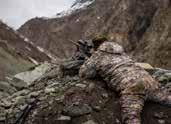


Official publication of The Wild Sheep Foundation
WSF World Headquarters: 412 Pronghorn Trail • Bozeman, MT 59718 • 406-404-8750
Cody Office: 1285 Sheridan Avenue, Suites 260/275 • Cody, WY 82414 • 406-404-8750
CHAIRMAN: Glen Landrus • ramslamvideo@gmail.com......................................
VICE CHAIR: Charlie Kelly • azsheepguy@gmail.com .........................................
SECRETARY: Jann Demaske • demaskes@msn.com
TREASURER: Larry Jacobs • lljacobs4@aol.com
Clint Bentley • sheepspotr@aol.com ........................................................................
Julie Chapman • jhelmchapman@yahoo.com ..........................................................
Sam Cunningham • scunningham@quailcreekent.com
Larry McGovern • ltmcgovern67@gmail.com
Emilio Rangel W. • emiliorw@me.com
Peregrine L. Wolff, DVM • falcolupus@gmail.com ................................................
Logan Richard Young • loganyoung270@gmail.com
Term Expires 2025
Term Expires 2026
Term Expires 2026
Term Expires 2027
Term Expires 2027
Term Expires 2025
Term Expires 2027
Term Expires 2025
Term Expires 2027
Term Expires 2025
Term Expires 2026
PRESIDENT & CEO Gray N. Thornton • gthornton@wildsheepfoundation.org
The Wild Sheep Foundation’s mission is to enhance wild sheep populations, promote scientific wildlife management, and educate the public and youth on sustainable use and the conservation benefits of hunting while promoting the interests of the hunter.
The tradition began on a November weekend at Mt. Horeb, Wisconsin, in 1974. Thirteen wild sheep enthusiasts passed the time by sharing stories about their encounters with the majestic mountain creatures. After realizing how fortunate they were to have all shared such incredible experiences, they decided it was time to give something back. They forged FNAWS so men and women everywhere could get more involved in the positive management of wild sheep. It was incorporated as a non-profit corporation in Iowa on September 14, 1977, and began accepting paid memberships in 1978 as more people joined the cause. The commitment and noble spirit of FNAWS quickly helped the foundation become the fastest-growing wildlife conservation organization of its kind.
PRESIDENT & CEO - EDITOR IN CHIEF, WILD SHEEP ® MAGAZINE: Gray N. Thornton • gthornton@wildsheepfoundation.org • Bozeman HQ
Kim Nieters, VP of Operations - Auction Director knieters@WildSheepFoundation.org Cody, WY
Kevin Hurley, Vice President of Conservation – Thinhorn Programs Lead khurley@WildSheepFoundation.org Boise, ID
Terry Ziehl, Finance Director tziehl@WildSheepFoundation.org Cody, WY
Keith Balfourd, Director of Marketing & Communications keith@WildSheepFoundation.org Bozeman, MT
Julie Tripp, Awards & Publications Director jtripp@wildsheepfoundation.org Lolo, MT
Paige Culver, Development Manager pculver@WildSheepFoundation.org Bozeman, MT
Maddie Richards, Membership Manager/<1 Clubs Manager mrichards@WildSheepFoundation.org Bozeman, MT
Justin Phillips, Graphic Arts & Design Jphillips@wildsheepfoundation.org Cody, WY
Gray N. Thornton, Editor in Chief
Scott Morrison, Editor/Art Director
Megan Costanza, Banquets & Events Manager mcostanza@WildSheepFoundation.org Reno, NV
Mike Aiazzi, Expo & Exhibits Manager maiazzi@wildsheepfoundation.org Reno, NV
Jaime Teigen, E-Commerce & Office Administrator jteigen@wildsheepfoundation.org Bozeman, MT
Rebecca Anne Rebrovich, Assistant rrebrovich@wildsheepfoundation.org Bozeman, MT
Margie Forster, Registration Assistant mforster@wildsheepfoundation.org Reno, NV
CONTRACT & CONSULTANTS
Dr. Ryan Brock, Youth Education Coordinator rbrock@wildsheepfoundation.org Reno, NV
Greg Schildwachter, Lobbyist greg@watershedresults.com Washington, DC
Charlie Booher, Lobbyist charlie@watershedresults.com Missoula, MT
Ashley McEnroe, Field Editor/Staff Writer
Craig Boddington, Contributor
Andrew McKean, Contributor
Ken Nowicki, Field Editor
Greg Schildwachter, Columnist Legislative Watch
Contributing photos, articles, stories, and research pertaining to wild sheep or the interests of the members of WSF are always welcome. Contributed material will be published at the editor’s discretion. Please include a selfaddressed stamped envelope if you wish materials to be returned.
Kurt Alt, Conservation Director –International Programs altwildlife@yahoo.com Brussels, Belgium
Marina Meyer, MadebyMimi, LLC, Social Media Consultant mjsams09@yahoo.com San Antonio, TX
Clay Brewer, Mexico Initiative Lead & Special WAFWA Projects Claybrewer1@outlook.com Rochelle, TX
Pat Cummings, DNWR – NTTR Project Lead Patrickcummings1002@gmail.com Las Vegas, NV
Maureen Jefferson, Conservation Permits Jm_hullinger@sbcglobal.net Las Vegas, NV
Chester Moore, Staff Writer chester@chestermoore.com Orange, TX
Ashley McEnroe, Staff Writer aoliverio@gmail.com Big Sky, MT
Shane Mahoney, Special Conservation Consultant shane@conservationvisions.com St. John’s, Newfoundland
Wayne van Zwoll, Contributor Morrison Creative Company, Inc. Magazine Design/Production Yellowstone Graphics, Graphics/Design
Advertising & Editorial Submissions Wild Sheep Foundation Headquarters 412 Pronghorn Trail, Bozeman, MT 59718 ATTN: Editor

For more information on submission guidelines, meetings and convention information, and service, conservation and hunting award criteria, please visit our website at www.wildsheepfoundation.org. All membership dues include $28/year for a subscription to Wild Sheep® magazine.
PUBLISHED QUARTERLY BY THE WILD SHEEP FOUNDATION OF BOZEMAN, MONTANA, IN CONJUNCTION WITH MORRISON CREATIVE COMPANY, INC. OF LIVINGSTON, MT.
DISCLAIMER While Wild Sheep Foundation strives to attract quality advertisers and donors, it cannot be responsible for the ultimate quality of the products which they may present to our members and buyers. Neither the Wild Sheep Foundation nor its Officers or Directors is a guarantor of your satisfaction with the products it makes available to you. Our dedication is to the wild sheep of the world and not to policing our advertisers or donors. We cannot, under the law, reject an advertiser or donation simply because of a prior complaint from a dissatisfied consumer. We will strive to make available quality merchandise and hunts, but without warranty or guarantee.
FOUNDATION FOR NORTH AMERICAN WILD SHEEP®, FNAWS®, WILD SHEEP FOUNDATION®, and WSF® and their respective logos are Registered trademarks and cannot be used, commissioned, or otherwise represented without permission of the Wild Sheep Foundation. <1 CLUB®, <1iCLUB®, CHADWICK RAM SOCIETY®, MARCO POLO SOCIETY®, MOUNTAIN HUNTER HALL OF FAME®, PUTTING SHEEP ON THE MOUNTAIN®, PUTTING AND KEEPING SHEEP ON THE MOUNTAIN , PUTTING AND KEEPING WILD SHEEP ON THE MOUNTAIN , SHEEP SHOW , SHEEP WEEK , TAKE ONE PUT ONE BACK , THE SHEEP SHOW , WILD SHEEP MAGAZINE, WIHI®, WOMEN HUNT®, WH®, WOMEN IN HUNTING®, WOMEN IN HUNTING INITIATIVE® and their respective logos are also Registered trademarks and cannot be used, commissioned, or otherwise represented without permission of the Wild Sheep Foundation.
COME FOR THE SHEEP, STAY FOR THE PARTY™, AND TODAY, TOMORROW, & FOREVER FOR WILD SHEEP™ ARE TRADEMARKS OF THE WILD SHEEP FOUNDATION.
GRAND SLAM® is a registered trademark of Grand Slam Club/Ovis. Used with permission.
Wild Sheep® (USPS# 009-460) is published quarterly by Wild Sheep Foundation, 412 Pronghorn Trail, Bozeman, MT 59718
Periodical Postage Rate is paid at Bozeman, MT 59718 and additional mailing offices.
Subscription Price $28.00 All membership dues include $28/ year for a subscription to Wild Sheep® Magazine
Postmaster: Send address correction to: Wild Sheep Foundation, 412 Pronghorn Trail, Bozeman, MT, 59718




Rangemaster CRF Pro Features:




The Leica Rangemaster CRF Pro sets a new standard in laser rangefinding performance. Paired with the rugged and versatile Leica Amplus 6 riflescope, this duo promises precision, clarity, and reliability like never before. With advanced ballistics calculation, superior optics, and weather-resistant design, conquer any hunting terrain with confidence. Trust Leica for the perfect shot, every time.

Our desired future state
To be the best managed, most respected, influential and relevant conservation organization benefitting wild sheep worldwide.
Why we exist
To Put and Keep Wild Sheep on the Mountain®
What we do
We enhance wild sheep populations, promote scientific wildlife management, and educate the public and youth on sustainable use and the conservation benefits of hunting while promoting the interests of the hunter.
Honesty
Integrity
Respect for Others
Hunting Ethics
The principles that guide us
Teamwork Accountability
Positive Attitude Stewardship
Respect for Wildlife Loyalty
Putting & Keeping Wild Sheep on the Mountain® Since 1977







K-DWR Water Resistance beads and resists water from penetration.


4-way Stretch Toray
Primeflex Nylon with an ultra-soft and comfortable micro-fleece interior.
Proprietary lamination process adds superior wind protection.
Proprietary Nylon Fabric provides added durability.
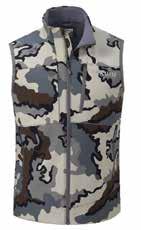
Featuring the latest soft-shell technology, the ALL-NEW Guide PRO Series delivers unmatched performance, durability, and fit, all at a backpack friendly weight. It utilizes a proprietary lamination process for next-level wind resistance, making it a must-have in your kit.

by Gray N. Thornton President & CEO
June 30th closed on a monumental and record-breaking fiscal year for the Wild Sheep Foundation, and I just want to say thank you.
A very heart felt thank you to our members, our life and summit life members, our society members, our donors, our sponsors, our exhibitors, and our chapter and affiliate partners.
Your support enabled the Wild Sheep Foundation to direct a record $9.2 Million dollars this fiscal year to mission program funding benefiting wild sheep, their habitat and health, and initiatives promoting and protecting our outdoor and hunting heritage. That $9.2 Million is $1.7 Million more to mission programs than our record last year. No organization or entity in our industry comes close to this level of mission focus and giving. No one. Thank you – YOU made this happen.
As I have said many times, while the Wild Sheep Foundation may be relatively small with only about 11,000 members worldwide, we cast a very long and impactful conservation shadow. Again, YOU make this happen – thank you.
Like all of us sheep hunters, I need to have goals to focus on. The next rock or ridge to reach while climbing the mountain. The next river to cross. The next summit to ascend.
At our 2023 convention I spoke of a focus of impact and relevance A focus of making sure everything Wild Sheep Foundation does
makes a positive impact on wild sheep...and to work to ensure that we remain relevant. Relevant to our members. Relevant to our industry. And, most important relevant to our Mission and Purpose to Put and Keep Wild Sheep on the Mountain®
Directing to Grant-in-Aid, wild sheep advocacy, education, and our state, provincial and tribal agency partners $7.5 million in fiscal year 2022-23 and $9.2 million in fiscal year 2023-24—an incredible $16.7 million to mission programs in just two years certainly made an impact, —and without a doubt—ensures that we are relevant.
But as we all know, money, even lots of it, is not the only answer. Money is not an end-all solution.
While our organization is certainly firing on all cylinders, wild sheep face enormous challenges. Disease and environmental factors far beyond our control are devasting wild sheep populations in some of their range. And this cyclical drop in supply, as well as increasing demand, is making the dream of hunting wild sheep an expensive one to say the least.
So what do we do?
Those of you who attended our record 2024 convention heard me speak of three words and a threeyear focus on them.
Those words are innovation, transformation, and legacy.
As we launch our 2024-25 fiscal year, you will hear me speak on innovative programs WSF will
launch to address the challenges wild sheep face, innovative initiatives to complement changes in our industry, and innovative additions to our annual convention. This innovation will help to ensure WSF continues to be impactful to the wild sheep resource and true to our Purpose.
We will transform many of our systems and programs to remain best-in-class and relevant to our members, our industry, and the wild sheep we cherish.
As Paige mentioned in your development article in issue, we’ll soon launch a new fundraising program called “Keep Climbing” as a part of our Today, Tomorrow, and Forever for Wild Sheep campaign. “Keep Climbing” will ensure WSF can and will continue to Put and Keep Wild Sheep on the Mountain® long after all of us are gone.
Thank you for your support this past year, and thank you for your membership in the Wild Sheep Foundation! WS
Gray N. Thornton President & CEO, Wild Sheep Foundation Editor-in-Chief, Wild Sheep® magazine
Marco Polo Society® Member
Summit Life Member
Chadwick Ram Society® Member
Legacy Society Member








by Glen Landrus Chair

hope this issue finds you well and anticipating a full hunting schedule. The limited entry draws across the West once again have not been kind to me, so sadly, I have nothing exciting scheduled yet for this fall.
Your WSF Board of Directors held the spring transition meeting in Reno in early April. Two long days of meetings covered a few important outcomes that are worth reiterating here.
First, what we all felt coming out of Sheep Show® was confirmed— we had another record-breaking convention! Thank you again to our members, exhibitors, donors, outfitters, staff, and volunteers. With such positive numbers, I look forward to building our next fiscal year budget reflecting a greater financial commitment to Put and Keep Wild Sheep on the Mountain®!
Another important item was a very thorough presentation by Kevin Rinke and the roll out of the “Keep Climbing” campaign. Kevin and his committee have spent countless hours researching, brainstorming, analyzing—and in the end—mapping our path forward to support wild sheep conservation for Today, Tomorrow, and Forever. Thank you, Kevin, and your committee, for your relentless dedication to this project!
We also spent a considerable amount of time discussing the dire situation with our thinhorn
sheep, primarily Stone’s sheep in northern British Columbia. As a result, your board of directors unanimously adopted a motion to work collaboratively with our British Columbia partners in funding $1 Million dollars in onthe-ground Stone’s sheep projects! Record conventions equals record financial commitments!
Operational Excellence Committee for their collaborative work regarding our WSF board elections. We have a great plan to recruit, showcase, and encourage members to get out and vote! WSF board leadership plays a critical role in mapping out our future pathways, please vote this fall!
In closing, I was humbly elected
“Collaboration is a key part of the success of any organization, executed through a clearly defined vision and mission and based on transparency and constant communication.”
We look forward to working with our partners such as GOABC, WSSBC, First Nations, government, and others to bring this commitment to fruition over the next few years! This, along with our Chapter & Affiliate Summit in Calgary’s conservation appeal which raised nearly $200,000 USD for Alberta’s Rocky Mountain bighorn populations shows that we are all in, Canada! Let’s go to work!
Finally, I want to thank Charlie Kelly and Larry McGovern and the
again as chair of the board for our next fiscal year. It’s hard to believe this will be my final year on the board and I am excited to spend it again leading this amazing group. We should be so proud of what we have accomplished, but with greater collaboration, we can do so much more. The wild sheep depend on it! WS
Yours in Conservation,
Glen A. Landrus


In 2013 the Wild Sheep Foundation (WSF) launched a legacy campaign, Ensuring the Future of Wild Sheep, that includes tax and estate planning opportunities, counsel and advice, major gifts, and giving societies to raise the funds required to ensure the future of the wild sheep resource by directing even more dollars to wild sheep restoration, repatriation and conservation. Our vision is to build a series of funds from which a targeted annual offtake of 4% will allow WSF to direct 100% of our convention fundraising to mission programs. Our goal is $5 to $6 million annually in mission focused Grant-In-Aid and other funding to “Put and Keep Wild Sheep on the Mountain.” With your help we can achieve this vision and goal.
The Marco Polo Society was established in 2008 as WSF’s premier giving society. To compliment the Marco Polo Society and expand this giving concept to ALL WSF members and wild sheep advocates, WSF created a new giving society in the fall of 2013 – the Chadwick Ram Society with five benefactor
levels enabling tax-deductible, donor directed gifts from $250 to $5,000 per year to mission areas of the donor’s desire. Donations can be made to the WSLF Endowment Fund, WSF Conservation Fund, our annual Convention and/or Area of Greatest Need to fund specific programs and initiatives. Chadwick Ram Society members are recognized with a lapel pin displaying their Copper, Bronze, Silver, Gold or Platinum benefactor level. Members may also “upgrade” their benefactor levels within the Chadwick Ram Society as well as to the Marco Polo Society.
For more information on the Chadwick Ram Society, the Marco Polo Society or the Ensuring the Future of Wild Sheep campaign, contact WSF President & CEO, Gray N. Thornton, Development Manager, Paige Culver, or visit our website.
We cordially invite you to join the Chadwick Ram Society and help Ensure the Future of Wild Sheep!

CRS
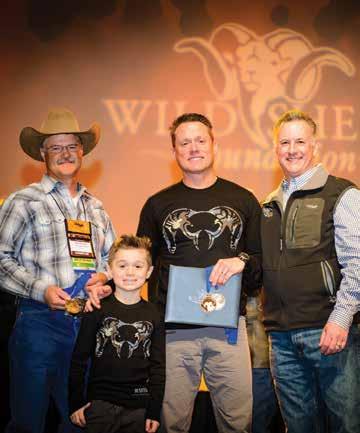
“I was invited to attend the Sheep Show for the first time in 2013. I had no idea the impact it would have on my life. As a direct result of joining the Wild Sheep Foundation, I have met so many incredible people, developed friendships that will last a lifetime, and experienced countless adventures around the globe with the best outfitters in the world. I have also learned how vitally important it is for all of us to support the mission of this great organization.
Wild sheep are the iconic symbol of the mountains we so love. Conservation is a comprehensive and multifaceted endeavor that requires extensive resources. The Wild Sheep Foundation is at the forefront of this effort, working tirelessly to not only preserve these majestic animals and the wilderness they inhabit, but to ensure that wild sheep thrive for generations to come.
(List is current as of press time - Jan. 1, - June 21, 2024)
PLATINUM - $50,000
Mike Borel & Roz Faugier-Borel (CA)
Rob & Lucy Cinclair (TX)
Andrew & Kymberly Pratt (TX)
GOLD - $25,000
Samuel Hays (TX)
Shane & Kim Mahoney (NL)
Terry & Mary Mick (MN)
SILVER - $10,000
Pat O’Neill & Kay Giannola (MN)
Charles & Rebecca Hartford (CA)
Breck Johnson (CO)
Anthony Reviglio (NV)
Michael Rogers (AZ)
BRONZE - $5,000
Thomas Armosino (OR)
Paul Baird (AZ)
Jeff & Kris Brant (WA)
Kevin & Lisa Fox (AK)
Joe & Kathy Hill (WA)
Douglas & Jacky Johnson (AK)
David & Lisa Matthias (IA)
Bruce Mellot (PA)
Rob & Brie Register (GA)
Brian & Nikiesha Richards (AK)
Chad Riedel (AK)
Konrad Schruf II (AK)
Jesse & Lovely Simonson
COPPER - $2,500
Ed Checque (AK)
Timothy & Brianne Clark (AK)
Eli Davis (WV)
Jim Elder (ID)
Will Garroutte (CA)
Ryan Hammond (AK)
Michael Hill (WA)
Jeremy Hoagland (AK)
Dave & Kris Hubbard (WA)
Loren Keisling (AK)
Shay Law (OR)
Nathan Liebl (WI)
Mary Maack (OR)
Ray Maack (OR)
James Perkett (AZ)
Steve Perrins (AK)
Bruce Perryman (WY)
Mark Riether (NJ)
Megan Rowe (CA)
James Treeman (OK)
Dilan Worthley (AK)
Ray Wurdinger (OR)
Having received so much from being a part of the Wild Sheep Foundation, I am instilled with a profound sense of gratitude and responsibility to give back. Each of us can contribute something to support the cause and reciprocate the many benefits and opportunities provided. This past year I learned more about the Chadwick Ram Society and its vision. Joining the society is my way of financially committing to the conservation effort in a meaningful way every year, and honoring the legacy of those who have supported the Wild Sheep Foundation long before I was here. I urge you to consider joining also, at whatever level you feel comfortable.”
-Rob Register

Beginning with the Fall 23 issue of Wild Sheep® magazine, jurisdictional WAFWA summaries will appear in the subsequent issues as space allows.
It is estimated based on historic explorer and naturalist records, well-documented anecdotes in early newspapers, broad paleontological data, and a geospatial analyses of bighorn terrain, that Nevada’s bighorn sheep numbers prior to European settlement were 30,000 – 50,000. Historically, the entire state including both the Mojave and Great Basin Deserts and mountains were occupied by a single species of desert bighorn sheep (Ramey 1993, 2000; Wehausen 2000), but with different races adapted to a tremendous amount of climatic and elevation gradient.
Nevada’s bighorn sheep population was at its lowest in the late 1950s at approximately 2,500 animals. They primarily occupied the lower one-third of the state (see remnant polygons on map) with the entire northern half of the state completely extirpated of bighorn primarily from pneumonia dieoffs contracted by comingling with domestic sheep that numbered as high as three million in Nevada in the early 1900s. The first experimental bighorn transplants occurred in 1968 but it wasn’t until the late 1970s that bighorn translocations were successful. To date, 2,111 desert bighorn were reintroduced, and 1,005 California and 326 Rocky Mountain bighorn were introduced into Nevada. Most of the transplants were highly successful with the peak

1. Occupied bighorn sheep habitat distribution of bighorn sheep in Nevada categorized by remnant, introduced, and pioneered in Nevada.
statewide bighorn population estimate in 2019 at 12,500. As was planned, a great deal of herd connectivity was created from all these reintroductions with narrow valleys separating many of the mountain ranges that allow for bighorn forays. Most
of this connectivity was created in desert environments with no domestic sheep operations. In other areas of higher elevations and more productive habitats, a few reintroduced bighorn herds were established 10-50 miles from public land domestic sheep


Figure 2. Statewide bighorn sheep population estimates by subspecies 1965 – 2024. Population estimates for 2024 labeled on graph for each subspecies population.
allotments and trailing routes. Regardless of distance, pathogen transmission was accelerated over the last 15-20 years for both domestic-bighorn and bighornbighorn interaction. This resulted in several metapopulation disease events with some dieoffs having no known domestic sheep source, especially in the Mojave Desert. Five years after peak levels, the 2024 statewide estimate sadly dropped to 8,400 bighorn adults (Figure 2).
Desert bighorn lamb recruitment that supports herd recovery and growth continued to slowly improve to 27 lambs: 100 ewes compared to 23 and 21 lambs: 100 ewes in 2022 and 2021, respectively, but still well below the long-term lamb ratio since 1990 of 38 lambs: 100 ewes. We continued to see a statewide decline in desert bighorn sheep with an 11% drop from 7,200 in 2023 to the 2024 estimate of 6,400. This is a 38% decline since its peak in 2019 at 10,300. The
last time the statewide estimate was this low was in 2007. This decline was attributable to many factors including: 1) the multiyear drought that ended in 2022, 2) competition at and destruction of critical riparian/water sources from excessive feral horses and burros, 3) continued high lamb mortality from pneumonia in most desert bighorn herds and 4) lion predation on small, depressed herds has contributed to a “predator pit” state where lamb recruitment is unable to overcome losses from predation.
The 2023 aerial surveys classified over 1,000 California bighorn sheep with another increase in the lamb ratio of 46 lambs: 100 ewes compared to 43 in 2022 and 29 in 2021 during the worst of the drought period. The multi-year drought, overgrazing and degraded riparian areas from excessive use by free-roaming horses and burros and cattle, and mountain lion predation continues to suppress population growth. The 2024
statewide California bighorn population estimate is stable at 1,700 adults.
Rocky Mountain Bighorn Sheep
Aerial and ground surveys conducted in 2023 in four of the herds classified 158 bighorn sheep with very encouraging metrics of 60 lambs: 100 ewes and 66 rams: 100 ewes. The statewide population estimate of the six Rocky Mountain bighorn herds is static at 330 adults.
In the 2023-2024 hunt season, there were 235 desert bighorn ram tags compared to 294 the previous year. The 235 tags included 211 for standard seasons, 8 archery only, 5 specialty tags, 4 management (access-limited) tags, and 12 one-horn ram tags. Excluding the 1-horn ram hunt, there were 188 rams harvested in 2023 for 85% success of tags used. There was a slight uptick in ram horn metrics statewide in 2023 with 11 rams (only 7 in 2022) that scored above 170 B&C pts. The previous drought years continued to impact both horn base and horn length in 2023 and likely for the next few years. Statewide average days hunted was 6.7, the highest recorded, which is a combination of both difficulty of finding mature rams, but also more hunters are spending quality time enjoying the month-long hunt. The most positive hunt metric was average age of harvested rams, which was again the highest recorded at 6.9.

The one-horn ram hunt continued to be a great once-in-a-lifetime hunt for those that put the time in with five successful hunters at 50% success rate with average age of harvested rams at 9.2. The 2023 demand for desert bighorn ram hunting leveled off for resident applicants at 12,106 but continued to grow by nonresidents that surpassed 14,000 unique applicants for the first time. The 2023 desert bighorn ewe hunts harvested 20 ewes and 24 ewes from Units 161 and 268, respectively. Overall success rate was 56% of hunters afield. The number of desert bighorn ewe applicants showed a slight increase from 2,183 applicants in 2022 to 2,352 in 2023.
The 2023 California bighorn ram season was another challenging year for many hunters. Hunter success was the lowest on record at 80%, compared to long-term average of 92%. Average hunt days continued to trend up to over 10 days, with the last three years being over 8.5 days. Average age of harvested rams dropped again to 6.0 compared to long-term average of 6.9 years over the last 20 years. The average B&C score showed a slight improvement up to 149 5/8 from an all-time low last year of 146 1/8. The previous multi-year drought will continue to influence both horn base and length. Demand for California bighorn ram hunts continued to rise in 2023 with 22,080 total unique applicants compared to 21,452 applicants in 2022.
Only two Rocky Mountain bighorn ram tags were available
in 2023, the lowest tag quota since 1995 (first season was in 1985). This was the second ram season in the Ruby Mountains, Unit 102 since the all-age dieoff in 2010. As with the 2022 season, both hunters in Unit 102 had great hunts, harvesting 177 B&C-class rams averaging only 3.5 days. The other tagholder in the South Snake Range below the Great Basin National Park, struggled during the season and finally harvested his mature ram in February. Figure 3 depicts annual ram harvest for all subspecies since 1965. Peak ram harvest was 356 in 2017 with 300 rams being deserts.
and innumerable lambs perished that would have normally been recruited into the population. Extensive disease surveillance and post-event testing has confirmed Mycoplasma ovipneumoniae (MOVI) as the “trigger” pathogen involving approximately 17 different strains. Most of the pathogen spillovers over the last decade have been bighorn to bighorn transmission.
Ongoing efforts continue with Test and Remove for California bighorn herds in the Santa Rosa Range and Snowstorm Mountains in northern Nevada. For the Santa

Pneumonia dieoffs have significantly impacted Nevada bighorn herds in the last 20 years. Approximately 60 of the state’s 81 bighorn herds have experienced upper respiratory disease events. The impacts to the herds involved >15% adult loss the first year after the pathogen spillover and variable/cyclical lamb mortality lasting 1 to 18 years. It is estimated that since 2019, over 3,000 adults died of pneumonia
Rosas, 112 bighorns have been sampled since 2021 (90% ewes) and 14 were positive for MOVI by PCR. Likely, less than six ewes currently alive have not been tested. For the Snowstorms, 110 animals have been sampled and tested since 2014 (68% ewes). A total of 29 were positive for MOVI by PCR. Efforts will continue to monitor lamb recruitment to evaluate the hopeful success of the Test and Remove projects with the goal to augment both

populations with “clean” bighorn sheep. USDA Wildlife Services has been conducting predator management for these two herds. There is a huge investment in Test and Remove projects, where clean/ healthy ewes are “priceless” and their protection and survival is key to the future restoration of their bighorn populations. This project is in collaboration with the Oregon Department of Fish and Wildlife involving an interstate herd (Santa Rosas/Rattlesnake/Ten Mile) and part of the overall ION (Idaho/ Oregon/Nevada) Partnership supported by the Wild Sheep Foundation and affiliate bighorn conservation groups in each state. A Test and Remove project was initiated in 2021 on the Nevada Test and Training Range (NTTR, Department of Defense (DOD) lands) for a large desert bighorn metapopulation that had its pathogen spillover in 2014. It was expanded to include adjacent herds on BLM lands in 2022 with known connectivity to the NTTR bighorn population. A total of 53 animals were sampled just on the NTTR with only three actively shedding MOVI (all three were euthanized). An additional 31 bighorn were tested from adjacent herds on BLM lands in 2022 and 2023 with only one actively shedding MOVI. Based on high rates of MOVI antibody detection from ELISA tests 2022 and 2023 of 42% and 71%, respectively, there are still chronic carriers scattered across the large metapopulation. Due to lack of funding, challenges to accessing DOD lands, low bighorn density, and limited ability to detect chronic carriers (“needle in a haystack”), the Test and Remove effort was discontinued. Periodic

Figure 4. Mycoplasma ovipneumoniae (Movi) exposure status from statewide disease surveillance from 2010-2023 involving both live capture and hunter harvest sampling.
surveys will be conducted to see if the metapopulation can clear the active MOVI infection through old-age attrition and lion predation of chronic carriers. WS
— Mike Cox, Nevada Department of Wildlife
References
Ramey, R. R. II. 1993. Evolutionary Genetics and Systematics of American Mountain Sheep: Implications for Conservation. PhD dissertation. Cornell University. Ithaca, NY. 212 pp.
Ramey, R. R. II. 2000. New Perspectives on the Evolutionary Origins, Historic Phylogeography, and Population Structure of North American Mountain Sheep. In Thomas, A.E. and H.L. Thomas (eds.). 2000. Transactions of the 2nd Northern Wild Sheep Conference. 9-16.
Wehausen, J. D. and R. R. Ramey II. 2000. Cranial morphometric and evoluationary relationships in the northern range of Ovis Canadensis. Journal of Mammalogy. 81:145-161.

The Rocky Mountain Bighorn Sheep (RMBS) population consists of six herds totaling approximately 370 sheep scattered throughout western SD. Bighorn sheep were numerous on the prairies of western SD and the Black Hills before their extirpation in the late 1890s. U.S. Senator Peter Norbeck orchestrated their reintroduction in the early 1920s and thus began a conservation success story where bighorns once again occupied their native habitats in SD. Unfortunately, bighorn populations have fluctuated greatly since their reintroduction in the 1920s most likely due to pneumonia related mortality. In 2023, there were an estimated 370 RMBS in SD (Figure 1).
Going back to 1978, licenses offered have varied from 2 to 11. Harvest since 1978 has been at a success rate of 100%. Permits typically consist of one auction permit and several South Dakota resident random draw permits. Rams only are allowed for harvest. Ewes hunts can be implemented when deemed necessary.
Unfortunately, researchers in SD have documented bighorn disease die-offs in four populations related to pneumonia from Mycoplasma ovipneumoniae (MOVI)

since 2004. To recover these populations, SD has implemented the Test and Remove method in all four populations. In two of the populations (Custer State Park and Rapid City herds), this method has successfully removed the MOVI pathogen and allowed lamb survival to recover to normal levels. In the most recent population (Badlands), Test and Remove was just initiated in 2023. The Test and Remove method was important in reducing pneumoniarelated mortality in both adults and lambs and allowed recovery in two populations (Garwood et al. 2020, Ensrud 2022, SDGFP unpublished data). WS
— Chad Lehman, South Dakota Department of Game, Fish, and Parks
Literature Cited
Garwood, T., C. P. Lehman, D. P. Walsh, E. F. Cassirer, T. E. Besser, J. A. Jenks. 2020. Removal of chronic Mycoplasma ovipneumoniae carrier ewes eliminates pneumonia in a bighorn sheep population. Ecology and Evolution 10(7):1-12.
Ensrud, A. N. 2022. A postpneumonia epizootic evaluation of the Rapid City, South Dakota bighorn sheep herd. M.S. Thesis, South Dakota State University, Brookings, SD, USA.

Rocky Mountain Bighorn sheep populations throughout Wyoming have declined since the early 1990s from an estimated 7,000 sheep in 1990 to a low of 5,800 sheep in 2019. Since 2010, bighorn sheep numbers have generally declined, but showed some recovery in 2019 (Figure 1). At least some of this estimated increase is due to prospering reintroduced herds such as the Ferris/Seminoe population. After the 2021 hunting season it was estimated there were about 6,400 bighorn sheep. License issuance and ram harvest (Figure 1) has similarly declined over the past twenty years. In part, the decline in licenses issued and harvest is linked to several things other than population trend including harvest success, average age of harvested rams, and hunter effort. Because bighorn sheep hunting is so coveted (and now a once-in-alifetime opportunity), managers are very conservative with hunting opportunity, but harvest over the past decade has been consistent with change in population size (Figure 2).
The Devil’s Canyon herd in north central Wyoming experienced a pneumonia-related die-off between October 2022 and September 2023. Immediately following the end of the 2022 hunting season, a significant mortality event impacted the Devils Canyon herd. The death of a GPS-collared ewe in late October revealed another 36
sheep carcasses over the course of three days. Fresh carcasses were necropsied and samples sent to the Wyoming Game and Fish Department’s Wildlife Health Laboratory. Four living sheep were removed by department personnel after exhibiting clinical signs of pneumonia such as nasal discharge and extreme lethargy (unwillingness to move). Wildlife
Standardized aerial classifications conducted in July 2023 resulted in a total of 142 sheep counted. Shortly after this survey, managers were notified of new mortalities from collared ewes. Between late July and early September, 2023, 11 of the remaining 13 collared ewes were lost to pneumonia. The pathogen Mannheimia haemolytica was again confirmed to be the

Health Laboratory staff concluded that this outbreak was triggered by a novel strain of the pathogen Mannheimia haemolytica. Disease-related mortality continued through fall 2022 (began with ewes and lambs) and into the winter (final mortalities were rams in November and December). By December 31, 2022: approximately 44% of the collared sheep (n=6 ewes: 6 rams) were lost to the pneumonia outbreak.
causal pathogen. Unlike the initial outbreak, the second dieoff seemed to disproportionately impact ewes since no lamb or ram mortalities were documented during this period. Although the impact to the entire herd is not yet known, incidental observations were collected in November, December, and January where 3057 sheep were counted. Currently managers estimate the population


in the early spring of 2024 to be 70 individuals. Spring recruitment surveys and summer trend counts will likely reveal the extent of this second episode.
Given the significant and continual decline in bighorn sheep in the Whiskey Mountain herd, and following over a year’s worth of in-depth discussion with other sheep experts, local managers and researchers took a novel approach for Wyoming and implemented “Test and Remove” in the Red Creek sub-herd. The goal was to lower the prevalence of the pneumonia-causing pathogen, Mycoplasma ovipneumoniae (MOVI), by removing “chronic carriers” and ultimately increase overall herd health and lamb survival. It was decided to first test this approach with the smaller Red Rocks portion of the Whiskey herd. Testing for MOVI has been
conducted during captures each December and March since 2015. Based on these testing results, 13 ewes within the Red Rocks subherd have been removed (7 in 2022, 4 in 2023, and 2 in 2024). Of the 7 ewes removed between December 2021 and May 2022 during initiation of this approach, detailed lab necropsies found 6 of 7 (86%) had chronic pneumonia and 4 of 7 (57%) had sinus masses. Of the 4 removed in 2023, 1 (25%) had chronic pneumonia and 2 (50%) had sinus masses. Results from the 2 removed in 2024 were not available as of this writing. Though we have likely lessened the opportunity for mother-tolamb and then lamb-to-lamb pneumonia transmission to occur, there are other untested ewes within this sub-herd from which transmissions could continue to occur. Lambing season in 2022 was the first glimpse at reproduction/ survival after removing 7 of the
chronic carriers. During 2022-2023 winter classifications, personnel observed a lamb ratio of 47 lambs per 100 ewes. In 2024, personnel classified 36 lambs: 100 ewes. This number of lambs had not been observed in this sub-herd in the past 6 years. In fact, this is more observed lambs than has been seen in the last 6 years combined. We are still in the beginning stages of the project and are not making inferences about this increased number of lambs, but this is an encouraging step forward.
In 2024, test and remove was expanded to the rest of the Whiskey Mountain herd. In March 2024, 42 ewes were captured and tested. 14 (33%) tested positive using PCR in the field and confirmed in the lab. All 14 have been removed. We are using a “one-strike” protocol to identify chronic carriers. This is a departure from the “two strike” protocol in the Red Creek sub-herd because these sheep are wary of a helicopter, and once they are caught, they immediately leave the country and are in the wilderness area. So, getting our hands on the captured sheep to conduct a second test is nearly impossible and would greatly delay or hamper our ability to remove carriers. It is recognized this protocol may increase the likelihood of removing a positive animal that could clear the pathogen. We are not removing any rams or yearling ewes. WS
— Daryl Lutz, Wyoming Game and Fish Department
The Marco Polo Society® (MPS) is the Wild Sheep Foundation’s premier major giving “society” whose members have given and/or pledged a minimum of $100,000 to the Foundation. These donors have played a key role in the Wild Sheep Foundation’s success over the last 16 years. Quite frankly, this special group of donors has led the way in achieving our purpose of “putting and keeping wild sheep on the mountain”.
WSF SALUTES OUR MARCO POLO SOCIETY® MEMBERS TO DATE - Alphabetical Order
Shane & Angela Alexander (TN)
Lee & Penny Anderson (FL)
Anonymous
Anonymous
Stanford & Pamela Atwood (CA)
John & Jane Babler (MN)
Bryan & Barbara Bartlett (NM)
Scott & Erica Barry (MI)
Brian & Debbie Benyo (OH)
Gary Bogner (MI)
Dan & Kathy Boone (TX)
Louis & Patti Breland (AL)
Jerry & Amy Brenner (NC)
Steve & Jackie Bruggeman (MN)
Peter & Wendy Burchfield (PA)
Tony & Virginia Caligiuri (IA)
Ron & Billi Carey (AB)
Oscar & Valerie Carlson (MN)
Michael Carpinito (WA)
Walt & Joan Coram (TX)
Guinn & Betsy Crousen (TX)
Sam & Tracy Cunningham (TX)
Denis & Diane Dale (AB)
Dean & Paige Darby (MI)
Monty & Becky Davis (TX)


Since its inception in 2008, $11 million in MPS gifts/pledges have been directed to WSF and mission programs. We are so proud to announce that the Marco Polo 100 member goal was achieved at the 2024 Sheep Show when a group of generous Marco Polo members purchased the #100 member spot for a whopping $1 Million Dollars to be directed to the Wild Sheep Legacy Foundation’s Endowment Fund. We are so humbled and proud to witness the Wild Sheep Family come together to create history and we have never been more excited and hopeful for the future of wild sheep worldwide.
Jeff & Jann Demaske (CO)
Chris & Jaimie Dianda (NV)
Mike & Julie Dianda (NV)
Mark & Janice Dickson (CA)
Billy Dunbar (AK)
The Fiedeldey Family (OH)
Tom Foss (AB)
Ronald S. Gabriel, MD (CA)
Kevin Gilbert (MT)
Paul Greene (CO)
Brian and Susan Ham (AZ)
Marc & Cheryl Hansen (PA)
Jim & Sue Hens (NY)
Charles Herron (AL)
Tom & Denise Hoffman (NY)
Steve & Jill Hornady (NE)
Larry & Jane Hunts (OR)
Kevin Hurley (ID)
Ross & Nicole Jackson (CO)
Scott Jesseman (IL)
Kaan & Nurgul Karakaya (TUR)
Roger Kenner (ND)
G. Thomas & Patricia Lang (FL)
George & Kelly Lawrence (WA)
Doug & Dana Leech (WV)
Thomas Lemmerholz (GER)
Wayne & Denise Lennington (TN)
Jeff Lindgren (MN)
Robert Hall & Jane Link (FL)
Paul Mattes (MI)
Kyle & Joanne Meintzer (NV)
Joe & Christine Michaletz (MN)
Craig & Therese Mueller (ID)
Richard & Linda Murphy (NM)
The Olmstead Family (BC)
Mark & Gabriela Peterson (MI)
Ron & Vicki Pomeroy (WY)
Larry & Brenda Potterfield (MO)
Rancho La Palmosa (MEX)
Joni & Gary W. Raba (TX)
Terry Rathert (TX)
Gary & Yvonne Rigotti (OR)
Christopher Ring (TX)
Kevin & Janine Rinke (MI)
Alan & Barbara Sackman (NY)
Doug & Shelly Sayer (ID)
Roger Segebrecht (WI)
Steve & Sue Skold (IA)
Kip & Sue Slaugh (UT)
Kevin & Tuesdy Small (CA)
Dan Smith Jr. (CA)
Dan Smith III (CA)
J. Alain Smith (WA)
Mike Snider (MI)
Jeff Sorg (MT)
Daryll & Shauna Southwick (CO)
Brandon & Kristi Stokes (OR)
Rick Taylor & Carole Danyluk (BC)
Jelindo & Sandee Tiberti (NV)
Gray & Renée Thornton (MT)
Matt Tomseth (OR)
Mark Watkins (MN)
Tim & Ruth Van Der Weide (IA)
Ken & Anna Vorisek (AK)
Neal & Jody Wanless (AZ)
Mark Watkins (MN)
Jay & Martha Webster (TX)
Craig West (NC)
Steven & Ardyce Whisler (MT)
Clayton & Modesta Williams (TX)
Lyle & Jennifer Wood (AB)
Russ & Debi Young (TX)
Gary & Penny Young (WV)
Alan Young (YT)
#100 - $1M to the Endowment



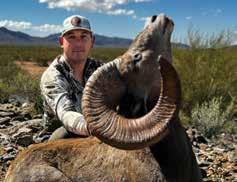


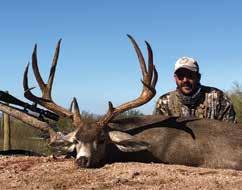



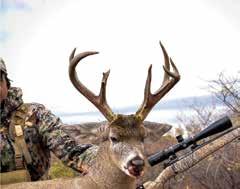

by Paige Culver WSF Development Manager

The greatest moments in history didn’t start as the greatest moments in history. They began as an idea, a first step, a seed of inspiration, or a whisper of curiosity. In the same way, sheep hunters don’t begin their journey at the summit. Their journey begins after they lace up their boots and take the first step out of base camp with their ultimate destination looming overhead and where their reward awaits. Placing one foot in front of the other, step by step, the seemingly unconquerable is conquered.
The Vision, the desired future state, of the Wild Sheep Foundation (WSF) is “To be the best managed, most respected, influential and relevant conservation organization benefitting wild sheep worldwide.”
To achieve this aspirational goal the WSF staff and directors have stayed keenly focused on being transformational, innovative, and leaving a lasting legacy. We do this through creative outreach programs and public education, funding impactful conservation projects, and preparing and planning for the future. It is no secret that we
are able to run full speed toward our Vision because of our faithful members and donors and their willingness to “Keep Climbing” and conquer the proverbial mountain. impact on the world that will NEVER be erased.
“Make an impact on the world that will never be erased.”
Each member at each level of participation is a critical part of our success; from our 10,806 members to our 5,302 Life Members, to our 879 Summit Life Members, to our 448 Chadwick Ram Society members, our founding 100 Marco Polo Society members and our Legacy Society members. You are the foundation upon which WSF can continue to grow and look toward the future as well as our individual and collective legacies. There is nothing more rewarding than knowing one can make an
This year, in addition to continued record Grant-inAid funding, the Wild Sheep Foundation staff and committees are working to develop and successfully execute a five-year, integrated, and linear fundraising campaign that benefits the Wild Sheep Foundation (WSF) and the Wild Sheep Legacy Foundation (WSLF), as well as the wild sheep resource for “Today, Tomorrow and Forever.” Our target for the “Keep Climbing” campaign is $3 Million to the WSLF Endowment Fund in cash or commitments per year, for a total of $15 million during the five-year campaign, by requiring that a minimum of 33% of all new dollars received be directed to the Endowment Fund so that wild sheep will continue to roam freely the lofty places we dream about…forever. We are always humbled by your willingness to climb the mountain with us. Our dream is that the Wild Sheep Foundation remains a positive force and advocate for wild sheep for many generations to come. WS


by Greg Schildwachter WSF Lobbyist
and its partners have drafted a bill in Congress to formalize and expand the Western Big Game Winter Range and Migration Corridors program. This effort began with Interior Secretary’s Order 3362 in 2018.
We advocated unsuccessfully for sheep movement areas to qualify under SO 3362 when it was issued in 2018 and almost expanded in 2019. Now sheep mountains are set to become eligible.
When you hear about migration policy proposals—which have been plentiful in recent decades —you usually hear generalities about the ecological importance of connectivity and fantasies about protecting or designating these areas. This time is different. Now the debate is about movement areas documented by state agencies where actual habitat improvement will occur.
For our mission of Putting and Keeping Wild Sheep on the Mountain® to work, we need mountain habitats in good shape. Obviously, sheep and other big game moving long distances need free passage, food, and water along their way.
How this work gets done is now dramatically different. It is no longer only that hunters contribute tax revenues on weapons and ammunition. It is that hunters— especially sheep hunters—are contributing directly to mission work on the ground. The hunters’ legacy of establishing and paying for conservation is now much richer. Federal agencies share in our mission and those of our partners,
but agencies have been struggling in recent years recruiting and retaining staff and funding their programs. With such resources as they have, they struggle with efficiency. WSF and its many partner nongovernmental organizations and state agencies add more labor and can work more efficiently.
The original 3362 program transferred federal funds to nonfederal partners to improve habitat on winter range habitats for elk, mule deer, and pronghorn. It was small on purpose to prove the concept. A year later, having already proven itself, the program was planned to add wild sheep and moose and to expand to include summer range habitats. This expansion was withdrawn at (literally) the last minute before the signing ceremony. Non-reasons concerning the conflict between wild and domestic sheep tilted then Acting Secretary of the Interior David Bernhardt away from proceeding. Even our friends are misled and dissuaded by the fog of that conflict.
As time expired on the Trump administration, WSF and partners set the bolder goal of elevating the program and its core idea from a temporary discretionary use of department funds into a permanent, obligatory standing program. We took this idea to the incoming Biden administration and got half of what we asked for: the new administration kept the Secretary’s Order in place (and featured migration as a priority on their agenda) but did not commit to maintain the funding.
Secretaries Zinke and Bernhardt
funded the 2018-2019 program at over $7 million per year, which, after non-federal matching funds were added, exceeded $30 million. Secretary Haaland has funded 20212024 at between $2.5 and $4 million each year.
Realizing that the good idea behind this program has bipartisan appeal, and that any administration could nevertheless stop it at any time, we and our partners began work on a bill to hardwire the funding. We also began requesting annual congressional commitment of the funds.
The bill is now nearly ready for introduction because Sen. Alex Padilla (CA-D), who chairs the wildlife subcommittee in the Senate, has committed to lead the effort. This proposal would establish a fully developed program for all species.
Mainly, the Wildlife Movement Through Partnerships Act transfers Interior funds from two agencies (Fish and Wildlife Service and Bureau of Land Management) to the National Fish and Wildlife Foundation for distribution as grants. That is the way the funds have been moving since the 3362 program began. There is a specific corollary to fund tribal work. Also, a share of the FWS Partners for Wildlife Program is expended directly for eligible projects and the U.S. Geological Survey assists states in developing maps of movement areas.
We expect the bill to be introduced during this Congress, but, given how late we are in the schedule, the bill is most likely to be reintroduced next year to have a better chance of becoming law. WS

Thank you Artee Family and the entire Alcampo Hunting team for the hunt of a lifetime at Sierra Al Alamo. Your conservation efforts in collaboration with the Wild Sheep Foundation have created the perfect habitat for Desert Bighorns. I feel blessed to have had the opportunity to hunt with such a fine outfitter. - mike schmillen




by Tony Caligiuri Chair, Ram Awards Committee
This is the time of year when anticipation of the upcoming hunting season is at its apex. Gear is being checked, stock is being conditioned and shoed, a few lucky hunters have drawn once-in-alifetime sheep tags, and others are making final payments to outfitters. But rest assured, outfitters, guides, and hunters are dreaming about the chance at a ram that will qualify for the Wild Sheep Foundation’s 2025 Ram Awards.
The awards committee is busy as well, and some new members have been added, making this year’s plans even more exciting.
Dave Turchanski has stepped up into the leadership role as co-chair of the international panel and brings a wealth of international hunting experience and superb organizational skills into his new role. Former SCI president Steve Skold, Alex Shariff, and Ludo Wurfbain round out the international subcommittee. As publisher of Rowland Ward, Ludo brings a new perspective on international species of goats and sheep as well.
Mike Opitz continues as co-chair of the North American side of the awards, along with Kyle Lehr, both bring a tremendous knowledge of North American big game animals and record book entries. New committee members Marcus Gores and Chuck Hartford finish out the remaining slots on the North American side. Many will remember Chuck as the keynote speaker at the Life Member
Breakfast two years ago and his heartfelt recollections as the ground assault commander of the Jessica Lynch P.O.W. rescue.
We are excited to have all these great WSF members on board for this year’s program and appreciate their hard work in making the greatest sheep awards program in the hunting industry come to life on stage in Reno. We anticipate another record-breaking crowd on Thursday’s award lunch during Sheep Show®. Be sure to arrive in time to attend.
This issue features a great feature story by Lindsey Stroud about her hunt for a BC bighorn last fall. She harvested a giant-of-a-ram that is sure to be a contender for this year’s awards. See page 34. We all look forward to seeing Lindsey on stage in Reno!
Rams taken after August 30, 2022, through August 30, 2024— that haven’t already received a ram award—will be eligible for the 2025 Ram Awards Program. The absolute deadline for submissions is November 1, 2024, and North American entries must be scored by an official Boone and Crockett measurer after the required 60-day drying period—so rams killed after September 1 this season will have to wait for next year’s awards to be considered. All score sheets, whether B&C for North American rams or SCI score sheets for international entries must be signed by an official measurer and be submitted along with a hunt report and field photo to be considered for
an award.
November 1 is also the deadline to get in your submissions to be recognized for a FNAWS. We must have completed hunt reports for all four sheep as well as field photographs for each. Score charts are not required for FNAWS recognition.
The awards committee also had the enjoyable task of selecting four deserving first-time sheep hunters as grant recipients through the Ram Lay-Away Program. These lucky WSF members are in the process of booking their hunts. If you’re interested in applying, scan the QR code for more information about the Ram Lay-Away Program and how you can apply for next year.
Our committee is also considering some new guide awards for this year’s awards program. We hope to have more details about this in the next issue. We are also finalizing the launch of our new 1K Society—A Society with a Purpose. If you have taken a Dall’s, Stone’s, Fannin, desert, bighorn and California bighorn with a combined score of 1000 B&C gross or SCI points, and would like more information, please contact Julie Tripp at headquarters for details and an application. WS







BY LINDSEY STROUD

It was devastating news to Rocky Mountain bighorn sheep hunters when the rams were put on draw in 2022 in the Kootenay Mountains. I had been sheep hunting since I was 16 years old with my father after I had taken my first ram. Over the years I had spent countless hours in the background pre-scouting, hiking, and hunting in search of these majestic creatures. In 2015, I suffered an anoxic brain injury which led me to have to relearn how to use my arms and legs again. My dad, Don Kasner, had made me a promise though in the hospital that we would one day be hunting rams again together.

I was fortunate enough to draw a bighorn tag in region four for the 2023 season. Between friends, family and myself, we spent countless hours in the zone I had drawn, and to much dismay, we did not see a single ram in the pre-season. I had been a little disheartened thinking that I may not even have an opportunity at a ram, even with drawing this tag.
On the day before the opener we had met some friends and devised a plan to do some scouting and then meet up later that afternoon. As we started our journey up a familiar road we had spent countless hours on over the years, we stopped to glass a hidden basin. With the quad rumbling too much, I had turned off the key so I could see better. Once
again, no rams were spotted. My husband, Brody Stroud, jumped back on the quad with me and went to turn on the quad but it would not start. My dad and husband were quick to head to work on the quad as I grabbed my binoculars once again and began to look over the area I had just scanned. As the light began to change, I scoured the cliffs and broken grassy basins with my binoculars and caught a glimpse of something I had not seen earlier. I traded my Leicas for the Swarovski spotting scope and zoomed in on the object contrasting against the green vegetation. Rams!
The first ram I saw was a young ram that could have been confused with a ewe. I scanned to the left and saw mass—and a lot of it. I called
my boys over and their jaws hit the ground as they realized what I had just spotted. I quickly “Inreached” my brother, Jordan Kasner, as I knew I wanted him to be a part of this hunt. I said, “I found a good ram I need you up here with me.” I got a reply back saying he would drop the kids off after their morning hunt and head our way. Our other friends friends, Kayla and Glen, were soon at our side and were in agreeance that this was the ram for me.
As we waited for my brother to arrive, one of us kept eyes on the sheep while the rest of us scouted the thickly-timbered ridges and draws that lay before us for the best access to the high alpine basins that held the sheep. Once we determined a suitable route, Brody and I then made the three-hour round trip journey back to break down base camp and move it to a closer location. At around four o’clock, we met up with my brother and dad. After much discussion, we came up with a game plan. We would gather the gear we needed for a night on the mountain. We said goodbye to dad, jumped on the quads, and headed up the mountain as far as we could before our hike would begin.
The first part of the hike took us about three hours, and Lady Luck seemed to still be on our side. We had a nice deactivated road which turned into a thicker overgrown road, which turned into an elk trail, which turned into a little bit smaller trail up to a bench on the hillside. We figured we were about 1.2 km away from the rams at this point in time, so we made camp for the night. Being in grizzly bear country
As the light began to change I scoured the cliffs and broken grassy basins with my binoculars, and caught a glimpse of something I had not seen earlier.
it wasn’t the best sleep. We got up at 1 a.m. for our group pee and jokes, and then we were able to doze off and get some much-needed rest.
6 a.m. came early. Up we got, had a quick Mountain House breakfast, and were off. We figured we only had about an hour or so up to the sheep. We were wrong. It felt like it was straight up and down.
We battled against overgrown snowbrush and steep shale, but we eventually made it to the ridge we were looking for. We dropped our packs and moved forward thinking the ram we were looking for would be right there. After a short way, we realized there were more finger ridges to be traversed. We went back and grabbed our packs. Well, I left mine thinking I could move faster without it, even though in the back of my head, I could hear my dad saying don’t ever leave your pack behind!!
We dropped down a bit, scaled the mountain side, and came back up to the ridgeline so we would be above the sheep and start making our way across the basin. Suddenly Brody froze and whispered, “Ram right there and he’s got us pegged.” We all dropped behind some brush 230 yards from the rams. The boys both saw the ram, but I didn’t. I knew the general area he was in so I tried not to get worked up. We waited behind the brush for about an hour-and-a-half.
He finally rose from his bed and turned to start feeding. Finally, we were able to make our move. Right at this time I had to shove my sleeves down my throat to stop my cough from blowing the sheep out of the country. I had a cold and was also fighting off nausea from all the
excitement. Jordan stayed behind us to spot the shot. Brody and I crawled about 10 yards to where we had good positioning to shoot. I popped in my Spartan bipod and
lined up on the ram. When I got those horns in my field of view, I didn’t think my heart could beat any faster. I tried to focus on the body as much as I could. I avoided

Submit your Hunt Reports for the 2025 Ram Awards today!
North American wild sheep harvested between August 30, 2022-2024. —
International wild sheep and goats harvested between August 30, 2021-2024.
DEADLINE NOVEMBER 1
Scan code for full details or Email Julie Tripp at jtripp@wildsheepfoundation.org

looking directly at his headgear. Two feet to the left and he was out of my field of view. Two feet to the right and he was out of my field of view. I was worried he wouldn’t present me with a shot.
After what felt like a lifetime, he finally took a few steps, quartering away to the right, and I took my first shot with the .300 win mag. The ram hunched, turned, and ran 50 yards back toward us. He was behind another bush this time and all I could see was his head and horns. It was about a minute-anda-half before the ram turned again, took a few steps and presented a completely broadside shot at 180 yards. I focused on my breathing. Good breath in, deep breath out. At the end of my breath I had a
dead rest. I gently squeezed the trigger and WAP! The sound of the impact echoed through the valley. I turned to Brody saying, “Did you hear that? I heard the hit!” Ever so politely, Brody told me to get back on the gun as the ram hadn’t gone down yet. We watched the ram take a few more steps, then rear back and tumble down the slide.
This is when the emotions took over. I began shaking and I could barely breathe. Tears immediately began flowing down my cheeks. We had done it! Lots of high-fives and hugs were given. The boys walked back to the treeline to grab their packs and I headed down to the ram. He was lying face down hidden in the brush. It wasn’t until I stepped around that I realized that
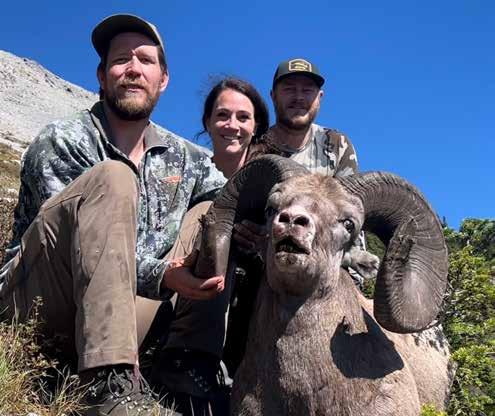
When the boys returned they saw me standing there with my hands on my head staring at the ram.
I had actually gotten what I had asked for. My double-broomed, darkhorn ram. I stared at the ram in disbelief looking at the sheer mass of the body and horns.
When the boys returned they saw me standing there with my hands on my head staring at the ram. They started whooping and hollering. What an incredible moment!
We took our time, soaking in the moment, sitting and looking out over this magnificent country realizing what we had just achieved. Picture taking is always fun and we took our time taking many of them trying to preserve this moment forever. After processing the ram, we began our long trek back down the mountain, grabbing camp along the way. When we got back down to the trailhead my dad was waiting for us. This was his 64th birthday. I could see his anticipation for our arrival with the grin on his face. Brody swung the quad around so he could see the magnificent ram we had taken and his hands flew to his head. Father like daughter. “What a giant!” he exclaimed. More hugs, high fives and dancing were in order.
Once back at camp we couldn’t resist putting a tape on the ram. My brother green scored the ram at 197. This night was a night to celebrate! Our good friends, Kayla, Shar, and Glen, brought us Chinese food and drinks, and the boys stayed up to the wee hours of the morning. I however, was exhausted, so I curled up into bed and dreamt about my ram.
I am thankful that I got to share this day with my dad, Don Kasner, who brought me up to be the hunter I am today; Jordan Kasner, my brother who I’ve always
looked up to and have admired since we were little kids; my mother, Dagny, and sister, Danielle, who have always supported me in all the things I do; my in-laws, as I absolutely would not be here
Lindsey holding the horns her incredible BC ram.
today if it weren’t for them. And most importantly, my husband, Brody Stroud, who loves me so unconditionally and has shared many hunting experiences with me over the years. WS

thank you alcampo hunting/sierra el alamo, the artee family and all their staff. your hospitality and conservation are undeniable. family, passion, forever memories. - kathy hill





Peoa, UTAH | $6,250,000 | 75± ACRES view property
Lost Creek Ranch is a luxurious property on 37.5± acres in the Wasatch Back of the Uinta Mountains. The custom-built, 5 Bed/5 Bath home offers 5,736 square feet of open-concept living, featuring wooden beams, vaulted ceilings, and a stone wood-burning fireplace. The main floor boasts a spacious kitchen with a large island and breathtaking window views. Downstairs, the walkout basement includes a bar area, recreation room, and a full bath with a steam shower. A highlight of the property is the large gym overlooking the pond and barn.
Lost Creek Ranch offers hunting opportunities for a variety of big game and small game species. Among the big game species are Elk, Mule Deer, Moose, and Mountain Lion, while Small Game includes Coyote and Bobcat. For Mule Deer (GMU 7), the ranch boasts a year-round population with trophy caliber bucks, especially during colder weather and rutting season. It has abundant hunting opportunities for archery, rifle, and muzzleloader enthusiasts. Similarly, the area hosts a resident Elk herd and provides owners with opportunities throughout the different hunting seasons (Elk General Unit). Rifle and Muzzleloader seasons offer more opportunities for elk as winter pushes more elk into the area.
Lost Creek Ranch offers total privacy and abundant wildlife, with hunting, recreation, and relaxation opportunities. Despite its secluded location, the ranch is just minutes away from the amenities of Park City, Utah. Travel is convenient with the Salt Lake International Airport 45 minutes away and a nearby private airport only 23 minutes away.





BY CRAIG BODDINGTON
“The mountain will tell me,” says legendary sheep hunter Rex Baker. Rex is a decade my senior. Recently, he confided to me that the mountain was starting to whisper, hadn’t yet blocked his trail. Couple years ago, Alan Sackman decided it would be fun to take one more FNAWS…in his 80s. He set to work and accomplished his goal. Early this year, I sat next

to Dr. Gerald Warnock at the Weatherby banquet. He was excited that he was headed to Mexico for a desert ram. At our Sheep Show® I talked to his outfitter, Bo Morgan. Yes, Jerry Warnock took a fine ram…at 91.
These guys are all Weatherby award winners, Baker in 2002, Sackman in 2008, Warnock clear back in 1994. At that moment
in their careers all were highly experienced mountain hunters… by definition for that award. Years later, and years older, they’re still at it, still testing themselves, listening for the mountain’s message. Now past 70, so am I. To see guys like these, with more years under their belts, still making it up the mountains, gives me hope that I might have a few climbs left in me.
We are compelled to keep doing it as long as we can. Until the mountain speaks and tells us we are done.

I hear it all the time: Mountain hunting is for young folks. I’m not sure that’s true. The toughest hunts are probably easiest when we’re young. In peak condition and prime of life, we don’t even realize it’s supposed to be hard. Nor do we care. We have little caution, always in a hurry. On the other hand, even for the young, the first mountain hunt might be the most difficult of all. We don’t know what to expect, how hard we must push ourselves. Doesn’t get easier, but experience counts. With enough ascents, we know how bad it can get. The
mountain has no surprises left to throw at us. We know how steep, how poor the footing, how miserable the weather can be. We also know something a young hunter cannot know: We know what we are capable of, and that we want it badly enough. We are compelled to keep doing it as long as we can. Until the mountain speaks and tells us we are done. There’s also practical reality. Mountain hunting is not the world’s least costly hobby. With careers to pursue and children to raise, few young hunters have the means. Even for those who do, most sheep hunts are serious
expeditions—a minimum couple weeks—also tough for hunters with young families and increasing responsibilities at home and at work. Regardless of location, much more time-consuming than a weekend’s deer hunt.
Here in North America, we have the wonderful luxury of drawing for permits. Plus, millions of acres of public and crown land where we can use them. We all know fortunate hunters who drew the first time he or she applied. Further practical reality, however, is that drawing a sheep or goat tag takes years and an ever-increasing number of points. I never drew a great tag first time around, but I was only three years in the draw to my Montana bighorn permit, almost the same as first-year. I was 30 years to my Arizona sheep tag, also 30 years to my Montana goat tag. This is my 46th year applying for sheep in Nevada, since long before bonus points existed. An eternal optimist, I still believe I will draw that permit…while I’m able to do the hunt.
Add up all the practical realities and maybe mountain hunting isn’t altogether a young hunter’s game. For sure, a magnificent ram is something we should aspire to and dream of, but it’s not the end of the world if we put it off until the kids are out of school, more time available, the finances more secure. More power to you if you can start at a younger age, but no shame if you can’t. The mountain will be there, waiting for you.
Easy for me to say, right? I was 20 when I shot my first wild sheep. BC outfitter Nathan Olmsted joined us at my kids’ Texas ranch last night.
Mountains vary. This is the Caucasus range in Azerbaijan, not terribly high, but some of the steepest, most abrupt mountains in the world.
He was 11 when he shot his first ram. We were fortunate, but we started sheep hunting in a different era…that ended not so long ago. Today, with permits ever tougher to draw and costs continuing to escalate, a sheep hunt may be years in the planning. I have multiple friends in their 40s and 50s, highly experienced hunters, who are just now contemplating a first sheep hunt.
That’s not a problem. In fact, a great age to begin sheep hunting. Young enough to conquer mountains, old enough to have acquired a bit of wisdom, a modicum of caution, and enough of life to savor the experience. With luck, plenty of years left to savor it again and again. My friend Jim Manley, just a couple years older, was 52 when he did his first sheep hunt. Many since. He got sheep fever bad. In 2022, at 73, he took a fine Dall’s ram in the rough, tough Chugach range. Fine enough to win him membership in the elite “700 Club,” a distinction most of us (me included) will not achieve at any age.
Inertia is Sir Isaac Newton’s First Law of Motion: “A body at rest will remain at rest, and a body in motion will remain in motion unless it is acted upon by an external force.” A couch potato is likely to stay a couch potato. A professional athlete is likely to continue training through the off season—and deep into retirement— because maintaining skills is part of who he or she is. Make no mistake, a mountain hunter is a special and different sort of athlete.


Our “events” are usually scheduled some time out. Naturally, we step up our training to prepare for a big game, but most of us maintain moderate sheep-shape as a matter of long habit and lifestyle… and just in case there’s a last-minute opportunity. I asked Nate Olmsted about the oldest sheep hunter he had guided. Not too far back he guided an 84-year-old to a fine Stone’s ram, his final sheep hunt. Interestingly, this gent had taken his first ram at 17, way back in that different era. That’s a 67-year career as a mountain hunter. He was a body in motion.
Once you know what is required, it’s easier to maintain a modest level of conditioning. Because you know what you must do, and you also know it’s hell to start over. That said, life throws you some curves. Anyone who’s had one can attest

Once you know what is required, it’s easier to maintain a modest level of conditioning. Because you know what you must do, and you also know it’s hell to start over.

that a heart attack is a life-changing event, requiring a restart. Likewise, I suppose, any other life-threatening illness that we manage to survive. In that restart, depression, fear, and anger at our bodies for failing us are normal emotions.
I went through all that after my heart attack, restarted slow, worked my way up. In large measure because I wanted to get back in the mountains. Four months out of the hospital I did a walk-up tahr
hunt in New Zealand. Note that some mountain hunts are tougher than others. This was fairly gentle country. Took my time, felt pretty good.
At the eight-month mark, my graduation exercise was a tur hunt in Russia’s Caucasus range. That is not gentle country. Not especially high, ridiculously steep. I figured if I could handle that, I should be good to go. Have been ever since. We all age differently, and we all
have different health issues that, naturally, tend to increase as we grow older. Downright foolish to consider a mountain hunt without having a heart-to-heart with your doctor…and yourself. Embarking on a mountain hunt is not an exam you can cram for. There are all manner of great fitness and training programs out there, but I’m not the guy to talk to about that. My uncle, Art Popham, was one of the early guys to complete a FNAWS.

No fitness freak, for sure. He was an attorney, office on the top floor of a high-rise. In preparation for mountain hunts, he simply used the stairs instead of the elevator.
I am also not a fitness freak. Into my 50s, the Marines kept me in pretty good shape because passing the Physical Fitness Test was an annual requirement. After
retirement, I lost that incentive, more’s the pity, but I’m determined to remain a body in motion. When home, I go to the gym consistently, hate it, make myself do it. Although never serious, I was long a runner, part of the Marine thing. Knees won’t put up with that silliness anymore, so I jog slowly at an aggravatingly slow old man’s pace—
or just walk. I remain convinced that the best exercise for walking is just that: Walking. We have good hiking trails in our area, no elevation, but plenty of up and down. Absent hills, there are always stadium steps.
Essential to do plenty of walking
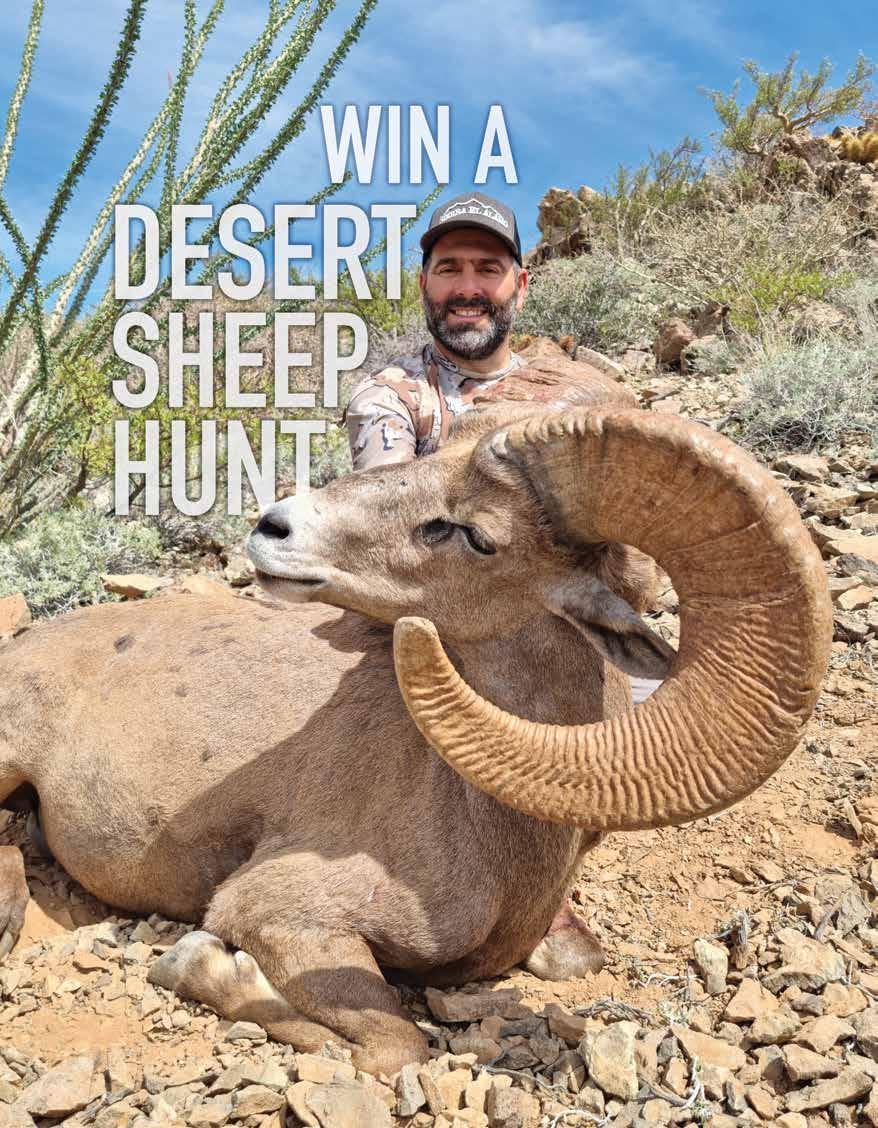
Mountain hunting is not for everyone, nor does it need to be. No shame in not wanting it bad enough. Doesn’t mean you aren’t a hunter; just means you aren’t a mountain hunter.
in your boots and add a little weight. Although it’s important to do the best you can—different for each of us—to train for a mountain hunt, I’m not sure it’s possible to be a hundred-percent ready. Footing will be different, probably unfamiliar. For those of us who live in low country (me included), altitude effects are inconsistent. Despite advancing age and physical
limitations, most of us get through it and keep coming back for more because of two important factors. First, mountain hunting is largely mental. Sheer will is a determining factor. You gotta want it bad enough. We’ll come back to that. Second, mountain hunting is not a race. Doesn’t matter how slow you are, only matters that you get there. Also sounds easy to say, right?
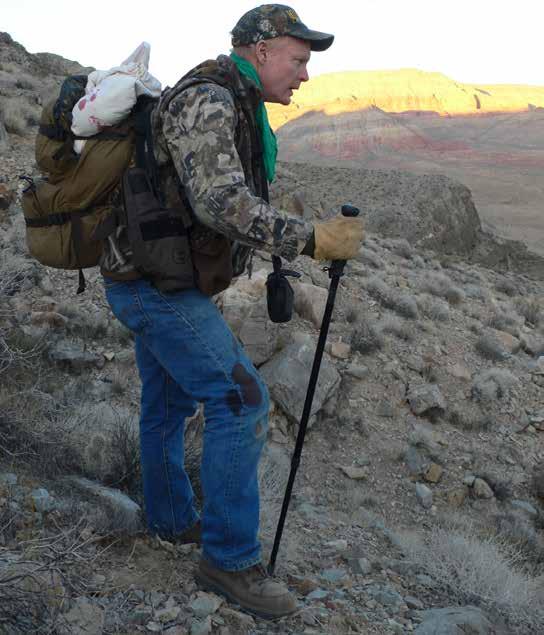
Yes, but slow and steady is the essence of mountain hunting. No points awarded for getting to the top first, only for getting there. Few mountain animals are taken in early morning. That’s when we’re climbing our way up to them, slowly but surely. The hope, always, is to reach vantage points, glass animals feeding and moving, put them to bed. Then we have all day to move on them. Slowly but surely, at our own pace.
In my experience, the daily schedule of sheep and goats is ideal for calm, deliberate, methodical hunting. Mountain animals are highly crepuscular, most active early morning and late afternoon, usually bedding and ruminating for long midday periods. They move little at night. Neither do mountain hunters, dangerous for everything up in the rocks in the dark.
In northern latitudes, with long daylight, one might have shooting light for 20 hours or more. That’s not a pace anyone can hold, so morning hunts are often abandoned. Sleep in, get rested, saddle up or pick up packs in the late morning, head up and get on the glasses, hoping to find animals moving to bedding grounds or already bedded. If the latter, you have time to move on them…at your own pace. They aren’t always approachable, but are likely to come down in the late afternoon, for water, feed, or both.
Some of my sheep and goats have been taken in their beds in midday hours. More have been taken in the late afternoon, often by waiting them out. This doesn’t always work. At some point you must get down out of the rocks, so almost
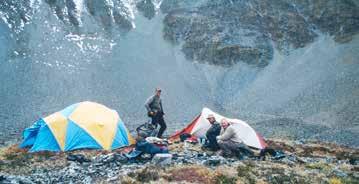
none of my mountain animals have been taken in last-light situations so common with hunting antlered game and bears. However, sheep and goats you leave at sunset probably won’t move far during the night. Now you have decisions, based somewhat on weather and mobility. Back to camp, and do it all again the next day, or stay on the mountain and plan a dawn ambush.
I don’t carry as much stuff as I used to and have much less shame about accepting help. Doesn’t matter to the sheep if you stubbornly insist on carrying all your own gear or allow your horse or strong young guide to carry a heavier burden. What does matter: When leaving camp in the morning, figure you aren’t coming back that night, so have everything you need, including a bit of food, to stay warm enough and dry enough through a long night on the mountain.
Remember my favorite mountain message? “The mountain doesn’t mind, and you don’t matter.” Absent major infirmities—even with them—age is just a number. It’s sheer will and mental toughness that put sheep and goats in the salt. On almost any day on a mountain hunt there will be times when you’ll want to quit, wonder why in the world you are doing this to yourself. Those who succumb to the temptation are not mountain hunters, and unlikely to become mountain hunters. It’s supposed to be hard, it’s supposed to hurt. The trick lies in not minding that, wanting it bad enough. Mountain hunting is not for
everyone, nor does it need to be. No shame in not wanting it bad enough. Doesn’t mean you aren’t a hunter; just means you aren’t a mountain hunter. If you are, then you want to keep doing it as long as you can.
Determination—and experience—add years to legs, but common sense should be applied. Mountains are not created equal, nor are mountain hunts (or mountain hunters). I did several backpack sheep hunts in my 60s. I’d probably need to think about that today. A couple years ago I finally drew a Montana goat tag. I didn’t know the area I drew, so I called Jack Atcheson Jr. for a recommendation. He suggested Ryan Counts, a great horse outfitter. Then he said, “The older I get, the more I like horses.” That goat area was high and rough. God bless horses!
Mountains vary, too. I trained hard and diligently for those backpack sheep hunts. Also, by design, I went to Alaska’s Brooks Range, neither high nor abrupt. Had no trouble. I’ve admitted that I’m not a fitness freak. Holiday season is hard on everyone, but that time of year I get especially lazy. Starts with post-Thanksgiving Kansas rifle season. Stand-hunting for whitetails is not conducive to staying in sheep-shape. Then comes convention season, almost impossible to keep a workout regimen.
Two years ago, I got caught with a last-minute opportunity to join a group on an ibex hunt in Tajikistan…in late February. Just after convention season, I’m not likely to be in great shape. That
year was worse than most, spent a week in bed with Covid. Of course, it never occurred to me to say no. The Pamirs in eastern Tajikistan are very high (Roof of the World), but not especially steep. I know that area, didn’t know the mountains in central Tajikistan. Not as high but very steep. Didn’t make me feel better that my camp-mates were all decades younger.
Experience does count. One morning I saw a huge ibex up high in the middle of nowhere. I don’t know if any of my younger friends could have gotten to that ibex or not; I only know he was beyond my reach. Next day, I had a shot at a lovely ibex. Midway through the hunt, lots of time. Maybe I’d have gotten a bigger one if I’d held out. Maybe not, impossible to know. I was doing fine, moving at my own pace. Feeling the country, recognizing that, age aside, I wasn’t in shape for it. Never even occurred to me to pass the shot. It did occur to me that I’d better not miss. I didn’t.
None of us can know how much time we have, or how long we can keep climbing. If I should live that long, I don’t know that I’ll still be hunting the mountains in my 80s, highly unlikely in my 90s. I do know that I’m not quite done. The mountain is speaking to me, but its message is not that it’s time to quit. Instead, it’s calling me. Right now, unusually, I have no mountain hunts planned. Maybe wait until the permit drawings come out, then make a plan. I’m feeling lucky this year. WS

BY VERN PETERS
When you’re obsessed with sheep, the Yukon’s high country beckons. The tale of one hunter’s quest for a really, really old ram...
ow do you know he’s old?” I asked.
“It’s easy. Look for a swayback and a pot-belly. Then look at the face. Is he bright-eyed? If he looks kinda out of it, he’s had a good, long life and he’s not getting around much anymore.”
“He lays around and thinks about what used to be, but he doesn’t have the zip to do it again.”
“Probably has poor teeth, too. That’s why he might be a loner, and really cranky. Nobody wants to put up with him.”
“Sway back, pot-belly, looks dull in the face—shoot that one.”
I straightened my back, sucked in my stomach, opened my eyes a little wider and smiled brightly. “I can do that.”
“And look for dark horns, broomed and chipped up a bit. That’s a fighter.”
I remembered those snippets
of conversation as spring rolled around back in 2018, gems of wisdom disguised as advice at a Yukon sheep hunters’ gathering. They were terms of endearment, too, for old Dall’s rams, seemingly disparaging remarks, yet directly correlated to admiration.
Soon after, my limited entry sheep permit for zone 7-22 arrived in the mail from the Yukon Department of Environment. That’s the Game Branch, for you other oldtimers. I was elated. “This year, we go up there and look for a big old ram. And if we can’t find a really, really big one, we’ll try for a really, really old one,” I said to my then 35-year-old son, Graeme.
In our family, when you say “really” twice, you really, really mean it. Some people add cuss words or swear for emphasis. That’s not the Mennonite way. We just say “really, really,” and add “for sure” if needed.
“Let’s do it,” Graeme replied. “For sure.”
Two weeks later, another letter arrived from the Game Branch: permit rescinded. Oh well, I thought, there are old rams in

Editor’s Note:
This story was first published in Outdoor Canada magazine, and recently was awarded first place in the “Best Hunting Feature” category in the 2024 Professional Media Association of Canada Annual Awards.


other places, so I did some research. How old is old for a ram? Surely, Google had an answer for that, too.
I found a study on ram mortality by wildlife biologist Olaus Murie, conducted long ago in Alaska’s Mount McKinley National Park now called Denali. He collected the horns of 608 rams—all dead, of course—and counted the annuli, or growth rings.
The study included lots and lots of numbers on a chart. They were meaningful. They were all over the page, with no pictures. It was exhausting. Better come back to this some other time, I thought.
Then two weeks later, another letter came. The permit was now “un-rescinded.” God works in mysterious ways. So does the Game Branch, it would appear.
With the hunt back on, I made a strong cup of coffee and revisited Olaus Murie’s ram mortality chart. Aha! There were some
In the two weeks allotted for our hunt, we expected to see no more than 100 rams.
words there I hadn’t seen last time. They explained the numbers. The 608 Denali rams had been “extrapolated,” or turned into 1,000 for statistical comparison. So, how many rams per 1,000 lived to be 10? The chart said 439. Another 252 made it to age 11, and 96 lived to be 12. After that, only six lived to be 13, and just three saw the age of 14. Beyond 14? Well, let’s just say this is no country for old men.
In the two weeks allotted for our hunt, we expected to see no more than 100 rams. That was only a tenth of the Denali study’s total, so I simply divided the data by 10
to get a picture of what we might expect to find. Our goal was to get a 13- or 14-year-old. According to my calculations, however, there would only be 0.6 of a 13-year-old and a mere 0.3 of a 14-year-old. That’s not even a complete ram when you combine the two age groups.
Such meagre math didn’t dissuade us though, so we carried on, turning to social media for hints on finding a worthy ram. I typed in “plenty of rams.” Pictures of a California football team popped up. Clearly this was not the right strategy. We had to do something real—go to where the rams lived, and look
them over in person
Early that August, Graeme and I did just that up in zone 7-22, nestled in the Yukon’s Coastal Mountains east of Kusawa Lake. We looked. And we walked. It was hot. The rams were also up high, bands of plentiful bright-eyed youngsters with straight backs, six-packs and light-coloured horns, thin and beautifully tipped out, some above the nose. It was quite a collection of six- and seven-year-olds. But where were the veterans? Had the warm spell in January melted the snow and covered the grass on the winter range with ice, starving them? Was

Did we want to go home, sit on the deck for the rest of the season and watch robins hop around on the front lawn? Nope.
it the late spring? Was it wolves?
After three days, we moved camp to the other side of the zone. We saw lots more of the same until the sixth day. Far in one corner we found them, a group of seven. Very Canadian. One ram, in particular, stood out. It was very special. Not really, really big, but really, really old. He had it all: a swayback, a potbelly, battered up dark horns, and a face that could sink 1,000 ships. This guy had character. But we let him be.
Why? Commitment issues. It’s generational they say. Leave your options open. Besides, if we took a ram, our hunt would be over. Did we want to go home, sit on the deck for the rest of the season and watch
robins hop around on the front lawn? Nope. And so we left the mountains with light packs.
Two weeks later, though, we were back. Rams move around more than you might think, so we were hoping a really, really big and really, really old ram might show up out of somewhere. It’s happened before.
Our second hunt went much like the first one, except that no hunts are ever exactly the same. We ran into a grizzly at 50 yards, then encountered another large boar draped over a ripe, half-eaten sheep carcass, its belly distended. Neither of them wanted us. Why? Commitment issues. Or perhaps we didn’t smell right.
After three days of hunting, we
found the group of seven again. Pure white they were against the brown sandstone next to a pale green slope, with dark fir trees below and a turquoise waterway bottoming out the valley. The ram with the dark, broomed-off horns was bedded down on a promontory slightly above the rest.
Graeme took a long look through the spotting scope. “Better take him, Dad. That’s a really, really great ram.”
“Let’s do it,” I said. “For sure.”
Graeme planned the stalk: stay above them, out of sight, crawl to the edge of the slope, then take care when you peek over. It took us about an hour, giving me lots of time to think about old rams


and memories.
I thought of an Ernest Thompson Seton story I’d read as a kid called “Krag, the Kootenay Ram,” about the haunting of a hunter remembering what had been.
Then I recalled the ancient 14-year-old ram we watched a number of years earlier, getting by on buckbrush leaves he stripped off with his gums. Three front teeth, hollow haunches and little fat were what we found when we dressed him out. What would his last days have been like if my other son, then 16-year-old Jody, had not taken him that October?
Then I contemplated the old ram below us on the rampart, gazing past his co-horts over the vast extended valley framed by forest, cliff and mountain. Was he also in his last summer?
I thought of the Dylan Thomas poem “Do not go gentle into that good night,” and wondered how many more years I would walk the alpine trails with my boys, now
strapping young men who could carry more and walk just as far as their father.
Of old rams and old men, dignity and endurance, courage and camaraderie, adventure and contemplation, beginnings and endings—all these thoughts pile up and mingle freely in thin air and high places.
I took off my hat and slithered forward, up and over the large, flat rock just below the rim. “He’s going to be exactly 200 yards below us when we get to that rock,” Graeme said, motioning ahead as he outlined the stalk, and behold, it was so.
Interesting, I mused to myself. Twenty years earlier, I judged the sheep, planned the stalks and called the shots. Now Graeme did. How does that happen?
The wind was behind us, rising with the warm afternoon sun and taking our scent up and over the rams. No hurry here. We both took another look through our
binoculars.
“He’s got good weight. Really, really heavy,” Graeme said.
I poked the rifle over the rim, rested my hand under it and waited until Graeme was right beside me with his binos trained on the ram. The crosshairs settled and I gently squeezed.
“Too high, wait.” Graeme’s voice was now my command. “He’s moving to the right. Don’t shoot. Ram in front of him. He’s the one still moving to the right. He’s furthest to the right now, in the clear. Wait, he’s coming up toward us. Wait till he turns. Gotta aim lower, Dad. Okay, now!”
The ram fell, rolled twice and stopped. I scrambled to my feet and was lifted way up into the air and squeezed with a giant bear hug.
“I’m so proud of you, Dad! Good shooting—eventually,” Graeme said, and laughed.
“Just like your old ram in the glaciers,” I said, recalling the 14-year-old Dall’s he took in 2001.
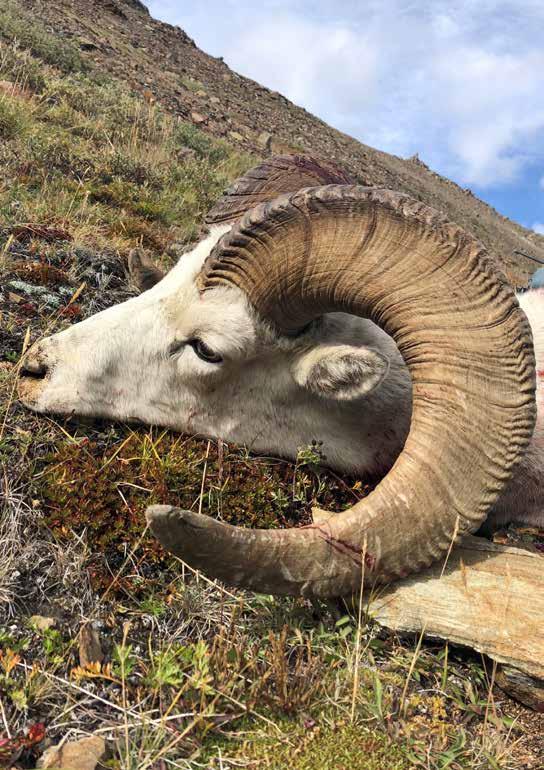

“Had to shoot over him a couple of times to make him run towards you.”
We slid down the shale and onto the green slope. “At least 12, probably 13 years old,” I said when we reached the ram. Then I counted the annuli, starting at number three since he was broomed off past the second ring. He was 13, later confirmed by wildlife technicians at the Yukon Department of Environment.
“Twenty-five,” Graeme announced.
“Twenty-five what?” I asked.
“Twenty-five years of us hunting sheep together.”
Suddenly, that very moment— and hunt—became all the more significant.
We took a number of days to pack out the ram. Why hurry? The alpine in late August is beautiful, after all, and loved ones appreciate you more if you come home late. Plus, sheep meat is a pleasant burden, and the sight of gnarly old horns on top of a heavy pack never gets old.
The mount of the old ram is now in a place of honour in my home in Whitehorse. Below it is a belt buckle with the engraving “Oldest Ram 2018 taken by a Yukon Fish and Game member,” a plaque commemorating “25 Years of Sheep Hunting, Graeme and Dad,” and a framed picture I took from the tree line of zone 7-22, showing a few scraggly old alpine firs silhouetted against the azure lake far below.
“It’s a Group of Seven photograph of where the ram lived,” I tell visitors.
The mounts of the two 14-yearold rams taken by my sons are on


And in the bleak midwinter when the moon wanes, northern lights dance and the ice fog seeps in from the Yukon River, my boys and I gather to gaze at the three old rams.



either side of mine. Their horns are also dark, battered up and broomed off. One has an old bullet hole near the tip.
And in the bleak midwinter when the moon wanes, northern lights dance and the ice fog seeps in from the Yukon River, my boys and I gather to gaze at the three old rams. We pour a shot of well-aged whisky, sip slowly and cast our minds back to bright sunshine, high alpine meadows, towering peaks and shimmering lakes far below. Most of all, we consider the old rams, and memories of the hunts. They haunt us still.
They really, really do. WS

Browning redefines Total Accuracy yet again with the new X-Bolt 2 and Vari-Tech stock. This new stock design is engineered with three-way adjustment that allows you to customize the fit of the rifle to meet your specific needs, helping you achieve consistent, tack-driving performance while retaining the silhouette of a traditional rifle stock.

Internal spacers lock in length of pull. Adjustable from 13-5/8" to 14-5/8" right from the box, this system is sturdy and rattle free. LENgth of pull
Two interchangable grip modules are available for the Vari-Tech stock: The traditional Sporter profile and the Vertical profile. Both let you optimize finger-to-trigger reach and control.
Achieve consistent eye-to-scope alignment and a rock-solid cheek weld even with large objective lens optics. Six height positions offer 1" of height adjustment. COMB HEIGHT



IT REFLECTS THE BEST OF WHAT WE CHEER AS HUNTERS!
BY WAYNE VAN ZWOLL

In new snow ankle-deep, we trudged up past timberline into the clouds. As if on cue, they parted, clearing alleys for our binoculars. “There!” But the chamois had seen us, and bounced off into the rocks. We angled onto a faint path. It snaked more gradually toward Austria’s crest, but afforded some cover. Minutes later a chain of chamois trailed across a bluff above. “That one!” My guide pointed at the second. Sling taut, I bellied into the snow. The animals caught the movement and stopped. At the .270’s bark, the target female fell. The others scattered, bounding away as if on springs.
The .270 was still a new cartridge when Joyce Hornady, named after a Methodist minister, made his first bullets. Born in Nebraska in 1907, he grew up with a middle-America work ethic. Early in his 20s, he shot rifles competitively. During WW
II he taught marksmanship for a Guard unit. Subsequently, after a stint at Nebraska’s Cornhusker Army Ammunition Plant, Joyce joined Vernon Speer in a bulletmaking enterprise in Vernon’s Lincoln machine shop. When that partnership sputtered, Speer moved to Idaho, and Hornady migrated to Grand Island. Both continued to make bullets. Hornady’s shop profited right away, generating $10,000 its first year, triple that sum by the third.
To improve the accuracy of his bullets, Hornady explored new materials, processes and designs. His mantra, “ten shots through one hole,” was a high bar when manufacturing tolerances couldn’t ensure minute-of-angle accuracy! Most hunters delighted in golf-ball groups.
Hornady suspended production of hunting and match bullets
during the Korean War, to put shop presses on other tasks. But he rightly predicted brisk post-war demand for bullets and in ‘58 broke ground for an 8,000-square-foot factory. In its 200-yard shooting tunnel he would test a sleek Secant Ogive bullet profile, soon to define Hornady Spire Point bullets.
Joyce began loading ammunition commercially in 1964, using canister powders behind Hornady bullets in once-fired cases. The first of these Frontier loads were in .243, .270, .308 and .30-06. The U.S. commitment in Viet Nam brought a shortage of formed cases, so in ‘72 Hornady began buying new brass. At this time, Joyce’s son Steve had just returned from an 11-year stint working for Pacific Tool Company in Lincoln. As Pacific’s handloading hardware line seemed a natural extension of his business, Joyce bought the company
On one of my early visits to the Hornady factory, I asked how the company could deliver such accuracy.
and moved tooling in-house. Hornady expanded further with the acquisition of West Coast Shot Company of Reno, Nevada. Later dubbed Hornady Magnum Shot, it was eventually sold back to its original owner.
The pursuit of accuracy remained Joyce’s focus through the ‘70s. On one of my early visits to the Hornady factory, I asked how the company could deliver such accuracy. “Boiled down,” explained a shop supervisor, “accuracy is a measure of uniformity. To get the best accuracy, we try to eliminate variability. Each bullet of a type must be just like the next, as regards weight, shape, length and diameter. Beyond the obvious, jackets must be concentric, with identical taper and nose finish.” He told me bullets are tested at 100,000-unit intervals for accuracy. “Average sizes of four five-shot groups must meet our standards. For .17’s, that’s an extreme spread of .400 inch at 100 yards. For 6mms it’s .450. Our 30-caliber bullets must shoot into .600, .338s into .750. Those standards apply to hunting bullets. Match bullets are spot-checked every 30,000 units and face higher bars – .350 for .224 Match. We test .308 Match bullets at 200 yards and expect them to group inside .800. As handguns are short-range arms and sometimes used in urban settings, how their bullets behave through obstacles and after impact matters. A bullet may have to penetrate thick clothing or drive straight through metal and glass at angles to its path—but expand in soft flesh to dump energy there along a broad wound channel instead of zipping through to injure


A keen hunter, Joyce Hornady tested his bullets afield to ensure they were not just accurate, but deadly.
Black powder? Hornady has lead balls and bullets and jacketed sabot loads (now with ELD-X bullets).
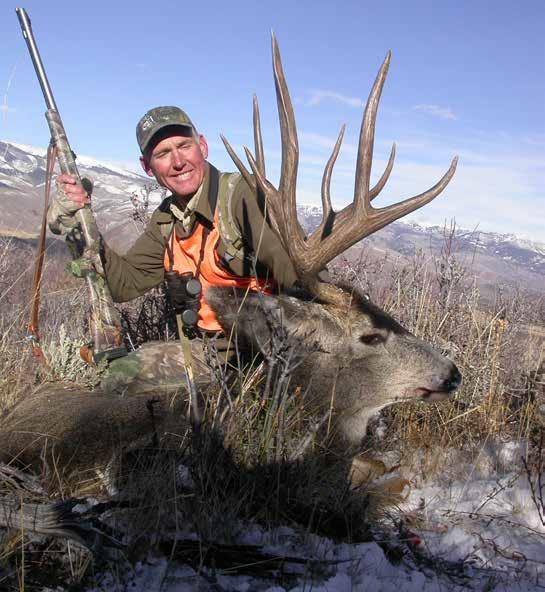
innocents beyond. Velocity, which affects upset, can be influenced as much by barrel length as by shot distance. “So we test handgun bullets at two velocities,” said my host, “—750 and 1,500 fps for .38s and .45s, but 1,000 and 1,600 fps for the .454 Casull.”
As pistol bullets also serve in sabot loads for black-powder rifles, they’re tested in muzzle-loaders too. I had seated a Hornady load in my cap-lock when, one frigid Utah morning, a big mule deer jumped from a cedar thicket. Good grief! And I was following the track! My silent tongue-lashing for not looking ahead didn’t improve prospects; but with no better option, I pressed on. The buck entered a serpentine oak thicket. Visibility fell to 15 yards; progress was noisy. About to give up, I came to a curve in the copse. It skirted an opening that extended my view. There ahead, at thicket’s edge, looking back, stood the deer! I knelt. My sight found an alley to the ribs. I exhaled and pressed the trigger.
Clack! There was no time to reprime; the buck was poised to slip deeper into the oaks. With only a faint hope the cap would have second thoughts, I again thumbed the hammer. Don’t jerk! By great good luck, the rifle bellowed. Ninety yards out: Thck! My .45 Hornady bullet had struck! Through the Pyrodex cloud, the animal lunged, then tumbled in a flurry of sun-shot snow.
Hornady Bullets lost its founder in a 1981 plane crash that also snuffed the lives of employees Ed Heers and Jim Barber. All were headed to New Orleans and the industry’s annual SHOT Show. More than a visionary with a product and a lust for market share,
Joyce Hornady had the drive to bring goals from dreams and the skills to put them in production. With no formal training in metallurgy, he’d learned materials science by trial and error. “He was a natural mechanic too,” said Steve. “He could make anything run.” His market intuition was spot-on, and he worked tirelessly.
The accident brought Steve a daunting task. “In ‘81 I was the only family member fully engaged in company operations,” he told me. “My job was suddenly to lead. I was hardly ready.”
Steve had grown up with shooting, handloading and the company. “As a youngster I held bullets to feed Dad’s handloading press. When I was five or six, we went on prairie dog safaris. One day, after my brother showed me how to load his .22 rifle, I fired it at a toy horse in the basement, using a mattress to slow the bullet. My mother came downstairs fast. I could tell she wasn’t kidding when she asked me to unlock the door.”
By age 14 Steve was pitching in to maintain machines at the factory. “I knew by then I wanted to be an important part of the company,” he said. His work at Pacific Tool would help him develop the skills and initiative to succeed as the next president of Hornady Bullets.
Soon after that transition, the company’s products included Spire Point, Flat Point, Round Nose, Hollow Point, Super Explosive, Boat Tail Hollow Point and InterLock rifle bullets, conventional handgun bullets and black-powder projectiles. XTP pistol bullets followed, as did A-MAX, V-MAX, SST (Super Shock Tip) and InterBond missiles for rifles.
In 1983 Hornady Bullets was
absorbed into a freshly formed Hornady Manufacturing Company. Frontier Ammunition and Pacific Tool Company became, respectively, Hornady Custom Ammunition and Hornady Reloading Tools. Within months the factory was making cartridge cases and loading them. “We became an integrated company,” Steve said, “with more flexibility, more autonomy. Meanwhile, we were blessed by terrific talent in our work force. This company truly runs from the bottom up.”
During the 1990s, Hornady invested heavily in research and development, a focus that remains.
In 2000 Hornady and Marlin came up with the frothy .450 Marlin for that company’s 1895
rifle. It coughs 350-grain bullets at 2,100 fps from a belted case half an inch shorter than the .458 Winchester Magnum’s. That year Hornady also worked with the Austrian firm Steyr to develop that company’s first fresh cartridge in decades. Based on the 7x64 Brenneke, the .376 Steyr punches above its size, slinging 270-grain .375-diameter bullets at 2,600 fps, for two tons of energy. Hornady loads a 225-grain bullet too.
One of the first announcements after century’s turn was as unexpected as the .376 Steyr—but for a different market. “We had supplied 17-caliber bullets to Mike Bussard at Federal Cartridge for his trials with .17 rimfire prototypes,” said Steve. “Dave Emary, our chief










engineer then, was intrigued by the idea. I wasn’t.” Understandably! Shooters know .22 rimfires as inexpensive little cartridges fired in affordable rifles they recall using as kids. But the prospect of tooling up to load rimfire ammo gives accountants the shakes. The first .22 round from a fully operational new rimfire factory represents a dollar investment of many millions, even with an established centerfire factory next door!
“Emary persevered,” Steve continued, “tweaking case design, trying new powders with our polytip .17 V-Max bullet. What he came up with, he insisted, was so much fun I had to shoot it. He coaxed me to the range. His .17 prototype was essentially a necked-down .22 WMR. It was supremely accurate, with hardly any recoil. I phoned Darrell Inman at CCI to see about loading it in Lewiston, Idaho. He said we’d have to order at least five million cartridges and buy the tooling! A huge expense!”
But in 2002 Steve took the gamble. It paid off. Just weeks after the .17 Hornady Magnum Rimfire appeared, the company doubled its order to CCI. Back-orders soon topped 12 million cartridges! The .17 HMR is still the only cartridge with “Hornady” in its name.
New ammunition for centerfire rifles followed. Hornady used a soft, resilient polymer to fashion pointed Flex-Tip, or FTX bullets for leveraction rifles with tube magazines. They gave hunters flat flight and more energy at distance without the hazard imposed by spring pressure and recoil jamming hard tips against primers in the magazine. With frisky charges of new powders, FTX bullets defined a new clan of cartridges: LeverEvolution. First in .30-30, .32 Special, .35 Remington



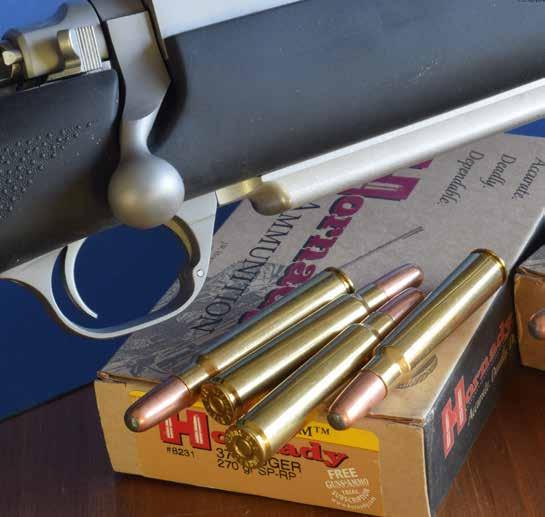
and .45-70. LeverEvolution loads have proliferated. Hornady then fielded the .308 (2007) and .338 Marlin Express cartridges for Marlin’s Models 336 and 1895 rifles. LeverEvolution loads for these rounds and for the .444 and .450 Marlin gave exposed-hammer lever rifles the reach of many boltactions. Hornady soon followed with FTX bullets in the .357 and .44 Magnums, for rifles patterned on the Winchester 1892 and Marlin 1894.
A new varmint cartridge, the .204 Ruger, began as a Hornady concept and was first loaded there in 2004. At 4,400 fps, a tiny 24-grain NTX bullet at 4,400 fps makes it the speed king among commercial centerfires. Hornady also loads it with the arguably more practical 32and 40-grain V-Max bullets.
Two years after the .204, again with Ruger, Hornady fielded a new big-bore cartridge. According to project lead Mitch Mittelstaedt, “the .375 Ruger was designed to wring the ballistic performance of the .375 H&H Magnum from standard-length actions and 20-inch barrels.” It does. I’ve found its 250-, 270- and 300-grain Hornady loads also behave civilly in recoil, even from short, nimble rifles.
“The .375 Ruger is one of the most satisfying rounds to come from our shop,” Steve declared. “It started us on the path of cartridge design. Sales were strong from the start. Everyone, it seemed, wanted a safari rifle. The .375 Ruger allowed us to eliminate the annoying magnum belt. Importantly, it became the parent case for our RCMs and PRCs (Ruger Compact Magnums and Precision Rifle Cartridges). Also, of course, the .416 Ruger. A winner in every way!”
$10


OUR TEAM HAS BEEN DEDICATED to getting it right for more than 20 years, something we prove every year by drawing some of the most coveted and competitive tags in the world.
STATE APPLICATIONS
$55 per state
$10 per species
EXAMPLES:
If you want to apply for Sheep in three states, your fee is $195.
If you want to apply for Sheep, Mtn Goat, Elk, Deer, and Antelope in one state, your fee is $105.
$10 per drawing regardless of the amount of tickets purchased
WE VALUE FAMILIES
As an added bonus, we will also apply your children under 18 for FREE in the states that you’re applying in as well as offer 50% off rates for your spouse and your children over 18.

Hornady’s .300 and .338 RCMs, announced in 2008, burn propellants developed to coax magnum velocities from carbinelength barrels. Asked to name his favorite hunting cartridge, Steve replied: “The .300 Ruger Compact Magnum. It’s flat-shooting, efficient and adequate for any game save Africa’s thick-skinned beasts. It doesn’t recoil sharply.” What’s not to like?
The most newsworthy Hornady cartridge in 2008 was the 6.5 Creedmoor. Based on the compact .30 T/C, whose base-to-shoulder measure is shorter than the .308’s, the 6.5 Cm welcomes Pinocchionose bullets whose profiles yield exceptionally high ballistic coefficients. The 6.5 Cm recoils gently. Its bullets carve flat arcs and jealously husband their speed and energy at distance. They dispatch deer and mountain game as far as hunters can aim and break an accurate shot. A wave of interest in long-range shooting has fed sales of rifles in 6.5 Cm. Hornady followed with a 6mm Cm, then the ambitious PRC cartridge series –6.5mm, 7mm and .300.
But the flurry of Hornadyinspired cartridges at the start of the 21st century didn’t diminish

efforts to improve bullets and add new types to growing rosters. At this writing, Hornady lists 16 kinds of match and hunting bullets, jacketed and lead-free, tipped and not. These include solids for Africa’s heavy game and bullets for sub-sonic loads. Add five jacketed and lead component pistol bullets, also three poly-tip bullets offered in ammunition but not as components. More than 270 loads for rifles and 70 for handguns make Hornady one of the biggest manufacturers of sporting ammunition in the world! Notably, it catalogs hard-to-find numbers like the .25-35 and .405 Winchester, Germany’s 9.3x62 and 9.3x74 and tall British big-bore rounds, .450-400 to .500 Nitro Express.
Where do ideas for new Hornady products come from? “We don’t assemble focus groups,” said Steve. “We make what we like, or think we’ll like. We assume other hunters and shooters will like them too, and most often we’re right. Not every idea becomes a commercial home run, but many have, and our staff is proud of what we introduce. We try to offer the very best value in everything we bring to market. We think our top-end hunting loads and bullets are the
most consistently accurate, deadly and dependable, to parrot what we print. Competitive shooters at the highest levels use our match ammunition.” He added that he recognizes not everyone wants to pay for the best, that a “standard” product may suffice. “In that category, we work to give customers the most value they can get anywhere for their hard-earned dollar.”
The recent spike in demand for ammunition frustrates Steve and others who produce it, as rumors beget rumors that trigger panic buying and hoarding. “We do all we can to keep production in synch with demand,” he told me. “But buying and installing new equipment, expanding the factory, then finding and training qualified people and building inventories require time and big investments.”
He pointed out that a single press in Hornady’s 108,000-square-foot factory now turns out more bullets in a day than Hornady Bullets did during its first year! “We’re operating at capacity. Still, our bestselling loads ship as soon as they’re boxed.”
Hornady also reports brisk sales in handloading tools and accessories, from presses and


dies to micrometers and bullet comparators.
Steve’s tenure at the helm of this family-run company has now surpassed that of his father Joyce. In 2006 Steve’s son Jason returned to join him after 15 years as a shooting sports industry representative. Steve has “stepped back” these days to give Jason experience as day-to-day lead at the factory, “while I focus on new products ,and how we’ll make them efficiently and at a profit.” As the Hornady work force has grown to nearly 300, keeping top talent is ever a concern. In competitive job markets, Steve’s strategy is simple: “Be as fair and as generous as reasonably possible.” It’s been successful.
Physically active, Steve travels abroad to indulge his passion for hunting mountain game. Close to home, he participates in shotgun sports. But the success of the business remains a priority.
When 75 years ago Joyce Hornady set his accuracy standard of “ten bullets through one hole,” it was a rare achievement. Still is! But a recent “quality control” group fired by a Hornady technician with 140-grain ELD Match bullets from a 6.5 Creedmoor load mic’d just .520 – at 200 yards! Results like this show why Hornady bullets and ammunition remain hugely popular. And why, at 75, the company’s best years may lie ahead! WS
Hornady Manufacturing contributes a great deal to the shooting sports industry. It is a member of NSSF, SAAMI and other groups that define it. Hornady donates generously to encourage participation in shooting sports and supports “Friends of the NRA” fundraising events. “These bring people of common interests and purpose together and keep them in touch with the industry,” Steve said, “and aware of political winds that affect the future of hunting and shooting.” WS





The Wild Sheep Foundation is pleased to announce the formation of the Southeast Chapter of WSF. We cordially invite you to join today! The new chapter was chartered June 13, 2024, during the spring board of directors meeting held in conjunction with Chapter & Affiliate Summit XVI in Calgary, Alberta.
The chapter will serve the southern region of the USA from Arkansas and Louisiana to Virginia and Florida. Membership is open to all
interested persons not only in the south and southeast, but anyone wishing to support this new and dynamic group of wild sheep conservationists and hunters.
To build a community of conservationists to raise resources in support of scientific wild sheep management practices and habitat improvement. This is to ensure healthy populations of North America’s sheep herds for future generations to enjoy. We are a
volunteer organization dedicated to sharing our passion for mountain hunting, educating the public and youth about the sustainable use of mountain resources and the important role hunters play in wildlife conservation, regardless of where we live.
A steering committee was formed in April, an inaugural board of directors established in late June, and approximately 70 initial members have signed to date. A limited SE Chapter “Founding Life Membership” is
April
1st Q4 Membership Drive Begins 13th – 14th Western Hunt Fest Raton, NM 20th MIMO Volunteer BBQ Reno, NV • Rancho San Rafael
May 4th – 5th Western Hunt Fest Palisade, CO
June
1st – 2nd Western Hunt Fest Colorado Springs, CO 13th – 16th C&A Summit XVI Calgary, AB
July
12th Ram Rendezvous III Bozeman, MT 27th Western Hunt Fest Championship Baily, CO
August
21st SITKA/WSF Films Premiere Emerson Theater, Bozeman

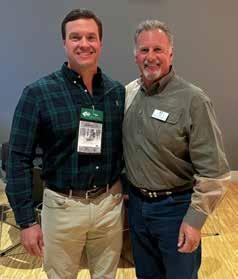
available to the first 100 Founders at $1,000. Founders must also be a Life or Summit Life member of WSF.
The chapter steering committee is working on a location for their first banquet and fundraiser next May/June which will also be host the WSF’s Chapter & Affiliate Summit XVII.
Join online here:


At the request of WSF supporters and consistent with the 2% for Conservation program of which WSF is a Founding Partner, we have launched the WSF Conservation Revolving Fund “We Give” campaign. Watch for WSF “We Give” partners who proudly include the “We Give” logo in their advertisements and/or promotions as those advertisers, exhibitors and businesses give a percentage or portion of their sales to the WSF Conservation Revolving Fund. 100% of WSF Conservation Revolving Fund contributions are directed to initiatives benefiting wild sheep and the habitat they call home. Proceeds are tax deductible to the full extent allowed by law and are directed to Grant In Aid and other specific conservation projects to Put and Keep Wild Sheep on the Mountain®
Participants to date include:
1. Jack Atcheson & Sons
2. The Journal of Mountain Hunting
3. The Wildlife Gallery
4. Backcountry BC and Beyond, Ltd.
5. Stone Glacier
6. RPS Bancard, LLC
7. YETI
8. SITKA Gear
9. Benchmade Knives
10. Kenetrek
11. Full Curl Spirits
12. RMP Rifles
13. 5.11 Tactical
14. Best of the West/Huskemaw Optics
15. Clarke – “1% For Tomorrow”
16. Brown Precision
17. Diamond Outfitters of Arizona
18. Black Rifle Coffee
19. Eventgroove
20. iHunt Apparel

For more information and to become a part of the “We Give” team, please contact Gray N. Thornton at 406-404-8750 or gthornton@ wildsheepfoundation.org
Nicholas Antoni
Brian Bailey
Kurt Bakken
Bruce Bardessono
Patrick Bernhardt
Charles Butler
Shane Byerly
Kendal Cain
Dominic Caligiuri
Ed Checque
Joseph Ciavarra
Ralph Coleman
Bernie Crooks
Jason Deraleau
Thomas Eastwood
Fernley NV Roswell NM Belmont WI Napa CA Helena MT Corpus Christi TX La pine OR Stanwood WA Des Moines IA North Pole AK Austin TX Whiting IN Sparks NV Reno NV Belgrade MT
Jesse Eckley
David Geelan
Luke Gerhart
Steven Hagan
Steven Hall
Elizabeth Hildreth
Levi Hinkelman
W A Hinson III
Ray Huot
Dave Jagst
Tripp Long
Stephanie Lough
Christopher Mathena
Sam McVay
Ben Miller
Jason Deraleau
Hinkelman
Billings MT Salem OR Yuba City CA Sisters OR Reno NV Palmer AK Ada MI Mountain Brook AL Palmer AK Hubbard Lake MI Stevensville MD Ponoka AB Aldie VA Terrebonne OR Reno NV
Quinton Nice
Brian Ortman
Randy Owen
Shane Oyster
John Prunty
Erika Putnam
Matt Schick
Brian Tinker
Bryan Tulare
Larry Tuttle
John Ward
Scott Wolf
David Zeitler
Attica MI
Anchorage AK
Chicago IL
Whitefish MT
Pagosa Springs CO
Portland OR Eagle River AK
Ontario OR Weston CT
Livingston MT Berwick PA Washougal WA
Paul Zuelke Sheridan OR Thornville OH


Without the financial support from sportsmen, fish and wildlife agencies would have little to no conservation and management programs dedicated to wild sheep. There is no other durable funding model, let alone one that has contributed at this level.
Whether you are a sheep hunter, hope to be, or want to see this opportunity for your children, this map is your legacy.
*TOTAL INCLUDES: $1,377,655 - International & $3,237,213 - Multi-State Projects









Become a Ramshorn Life or Life member and be entered to win! Each time the chapter gets 10 upgrades a winner will be drawn. Raffle ticket holders may win more than once. Winners may select from any of the prizes below. Allow 90 days lead time for delivery. Our donors will ship the winner’s choice at no expense to the winners. You will receive two tickets if you purchase a RHS life membership and 1 ticket for purchasing a life membership or upgrading from Life to Ramshorn membership.



Maven Back Country Guide Bundle

Maven Yellowstone Spotting Scope Bundle
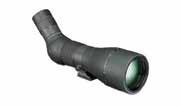

Weatherby Mark V Hunter Rifle Your choice of any caliber from the Weatherby website.

Weatherby 18i Deluxe. 12 or 20 gauge shotgun












The 2024 Lottery Tag is valid for use in any open controlled bighorn hunt, including Unit 11 .
“Tickets” are controlled hunt applications.
Ticket purchasers and persons named on tickets must be eligible to hold a hunting license in Idaho.
All controlled hunt rules apply.
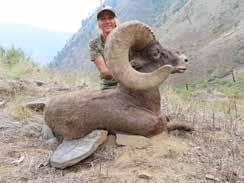







This tag (and hunting license if needed) will only be issued to an eligible applicant (the person named on the ticket drawn).
The tag is non transferrable.
Drawing will be held July 26, 2024 .
Once in a lifetime rule is waived for this tag .
Need not be present to win.
Tickets are void where the ticket/tag sale is prohibited.
No limit to number purchased.
Any insufficient funds for tickets and/or incomplete forms will invalidate a ticket(s) immediately.
Additional rules apply. See official rules at www.idahowildsheep.org.
Deadline to enter is July 22, 2024.


NOTE: bold/italics font denotes a joint WSF membership Chapter/Affiliate. Membership in these chapters and affiliates include membership in Wild Sheep
FOR COMPLETE CONTACT INFORMATION GO TO: www.wildsheepfoundation.org/memberships/chapters-and-affiliates
ALASKA WSF
Kevin Kehoe, President 907-441-6323 kevin.kehoe@alaskan.com
Molly McCarthy-Cunfer, Executive Director 907-615-2104 executivedirector@akwildsheep.org
WSF ALBERTA
Mike Smith tel:403-700-7746 mike@wsfab.org www.wsfab.org
WSF ALBERTA Chapter Office
Deena Arychuk, Chapter Staff info@wsfab.org 403-845-5544
CALIFORNIA WSF
Donald C. Martin, President 310-766-3921 Don-martin@earthlink.net
CALIFORNIA WSF Chapter Office
Beverly Valdez, Chapter Staff 650-472-3889 forthesheep@gmail.com www.cawsf.org
EASTERN CHAPTER WSF
Henry Noss, President Noss-s.mt.redbones@olive.com 610-223-8798
EASTERN CHAPTER WSF
Donna Gaugler, Office Manager info@ecwsf.org 610-704-1704 www.ecwsf.org
IDAHO WSF
Josh Miller, President Joshmiller65mm@gmail.com 575-749-8859
Tracy Rowley, Chapter Staff 208-345-6171 tracy@rtmmagt.com www.idahowildsheep.org
IOWA FNAWS
Craig Nakamoto, President 402-650-1383 nakamoto01@sbcglobal.net iowafnaws@gmail.com www.iowafnaws.org
WSF—MIDWEST CHAPTER
Al Holland, President 651-492-2985 caholl@msn.com www.midwestwildsheep.com
WSF—MIDWEST CHAPTER
Mike Bouton, Executive Director 612-940-1979 mikwbouton@hotmail.com www.midwestwildsheep.com
MONTANA WSF
D.J. Berg, President 406-366-1849 dj@montanawsf.org Ty Stubblefield, Executive Director 406-696-3003 ty@montanawsf.org www.montanawsf.org
MONTANA STATE UNIVERSITY
STUDENT CHAPTER OF WSF
Janessa Kluth, Chapter contact 208-420-4240 montanastatewsf@gmail.com facebook.com/MSUWSF
NEW MEXICO WSF
Bryan Bartlett, President (575) 635-3499 BartleBC@yahoo.com newmexicowildsheep@gmail.com
OREGON WSF
Kevin Martin President, OR WSF (541)969-6744 Kevindmartin63@gmail.com www.oregonfnaws.org
UTAH FNAWS
Travis Jenson 801-641-5453 tjenson@xmission.com www.utahfnaws.org
WASHINGTON WSF
Garrett Grant grant16garrett@hotmail.com www.washingtonwsf.org
WYOMING WSF
Zach McDermott, President 307-752-1212 zach@wyomingwildsheep.org
Wyoming WSF Chapter Office
Katie Cheesbrough, Executive Director 307-399-4383 katie@wyomingwildsheep.org www.wyomingwildsheep.org
YUKON WSF
Spencer Wallace, President 867-689-2074 yukonws@gmail.com www.yukonwsf.com
2% For Conservation
Jared Frasier, Executive Director 406-221-3102 contact@fishandwildlife.org www.fishandwildlife.org
Alaska Professional Hunters Association
Deb Moore, Executive Director 907-929-0619 Deb@alaskaprohunter.org www.alaskaprohunter.org
Alberta Outfitters Association Kevin Stanton, President 403-762-5454 aoa@albertaoutfitters.com www.albertaoutfitters.com
Alberta Professional Outfitters Society Jeana Schuurmaan, Executive Director 780-414-0588 jeana@@apos.ab.ca www.apos.ab.ca
Argali Wildlife Research Center Bamgalanbaatar Sukh, Game Biologist and head of “Argali Wildlife Research Center” +976-99176580 amgalanbaatarsukh@gmail.com
Arizona Desert Bighorn Sheep Society, Inc. T.J. Baehre, President 602-663-7871 t.j.baehre@centurylink.net www.adbss.org
Arizona Desert Bighorn Sheep Society Office
Tracey Martin 480-854-8950 admin@adbss.org
Association of Mackenzie Mountain Outfitters
Tavis Molnar, President 867-633-4934 info@arcticred-nwt.com
Bear Trust International Logan Young, Executive Director 406-595-6583 logan@beartrust.org www.beartrust.org
Cody Country Outfitters and Guides Association Lee Livingston 307-527-7416 Livingston@tctwest.net
Colorado Outfitters Association Kelly Nottingham, Office Manager 970-824-2468 office@coloradooutfitters.com www.coloradooutffiters.org
Custodians of Professional Hunting & Conservation—South Africa Adri Kitshoff-Botha +27 0 83 6500442 ceo@cphc-sa.co.za www.thecustodians.co.za
Dude Ranchers Association Colleen Hodson 307-587-2339 colleen@duderanch.org www.duderanch.org
Elko Bighorns Unlimited Cory Mahan, Vice President 775-397-4465 cmahan@ram-enterprise.com
European Federation for Hunting and Conservation (FACE) David Scallan 00353-879504563 David.scallan@face.eu www.face.eu
Fraternity of the Desert Bighorn Patrick Cummings, President Patrickcummings1002@gmail.com Michelle Mercer, Treasurer mercerlvnv@yahoo.in www.desertbighorn.com
Fundacion De Vida Silvestre En Sonora, A.C Jacobo Artee, President 011-52-662-212-5510, 011-52-662-217-4119 jacoboartee@prodigy.net.mx
Grand Slam Club/Ovis Jason Price, Executive Director 903-466-2195 gsco@wildsheep.org www.wildsheep.org
Guide Outfitter Association of BC Scott Ellis, CEO 604-541-6332 ellis@goabc.org www.goabc.org
International Caribou Foundation Cheryl Lind, Executive Director 406-404-1297 cheryl@internationalcariboufoundation. org www.internationalcariboufoundation.org
Lubbock Sportsmans Club, Inc. Dan Boone, President 806-733-0590 dfb@sonoramfg.com
Mongolia Wildlife Association
Magsarjac Erdenebat, Executive Director mongolwildlife@gmail.com
Montana Outfitter & Guides Association Mac Minard, Executive Director 406-449-3578 moga@mt.net www.montanaoutfitters.org
National Bighorn Sheep Center Amanda Verheul, Executive Director 307-455-3429 amanda@bighorn.org www.bighorn.org
Navajo Nation Department of Fish & Wildlife Jeff Cole, Wildlife Manager jcole@nndfw.org 928-871-6595
Nebraska Big Game Society Jim King (402) 430-6566 jim@glsbinc.com www.nebiggame.org
Nevada Bighorns Unlimited Tom Fennel, President 775-250-6600 tfennell@dicksoncg.com www.nevadabighornsunlimited.org
Nevada Bighorns Unlimited, Fallon Jay Lingenfelter, President jay.lingenfelter@cccomm.co 775-427-1254
Northern BC Guides Association Craig Kiselbach, President terminusmtn@gmail.com 250-442-7103
Northern Nevada SCI Chapter Gavin Chodera, President 916-960-8518 gchodera@nnsci.com www.nnsci.com
Northwest Guides & Outfitters Association
Colin Niemeyer, President 250-306-8624 hunting@kawdyoutfitters.com
Northwest Sportsman’s Club Nate Perrenoud 509-994-6795 www.northwestsportsmansclub.com
Purkersdorfer Jagdklub Gunther Tschabuschnig, Vice President 011-43-676-496-6691 info@jagdklub.eu www.jagdklub.eu
Pyramid Lake Paiute Tribe Donna Noel, Director of Natural Resources 775-574-0101 Ext: 17 www.plpt.nsn.us
Rocky Mountain Bighorn Society Ben Ramaker (785)760-1374 benramaker@hotmail.com www.bighornsheep.org Terry Meyers, Executive Director 970-640-6892 meyers.terry@gmail.com
Rocky Mountain Goat Alliance Marvin Kwiatkowski, Chairman marvin@goatalliance.org www.goatalliance.org
Contact: Kendrick Chittock, Fundraising Coordinator kendrick@goatalliance.org info@goatalliance.org
Safari Club International 520-620-1220 info@safariclub.org www.safariclub.org
Sheep Hunters of the World (SHOW) Billi Carey, Administrator 480-292-1674 www.sheephunters.com
Shoshone & Arapaho Fish and Game
Arthur Lawson, Director lawson@windriverfishandgame.com www.windriverfishandgame.com
Society for the Conservation of Bighorn Sheep Steve Marschke, President 310-339-4677 info@sheepsociety.com www.desertbighorn.org
Tahltan Guide Outfitters Association Rudy Day, President 250-235-3395 Dayrudy84@gmail.com
Spanish Professional Hunters Association Diego Satrustegui, President +34 618 621 690 Direccion.aptce@gmail.com www.spanishprofessionalhunters.com
Taos Pueblo
Michael Martinez, Hunt Manager 575-758-7410 hunting@taospueblo.com
Texas Bighorn Society Dr. Sam Cunningham, President 806-262-6889 scunningham@quailcreekent.com www.texasbighornsociety.org
The Confederated Tribes of the Warm Springs Reservation of Oregon (CTWS) Camille Brooks 541-553-2029 Camille.brooks@ctwsbnr.org https://warmsprings-nsn.gov
The International Council of Game and Wildlife Conservation (CIC) Sebastian Winkler office@cic-wildlife.org https://www.cic-wildlife.org/ Wildlife Stewardship Council John Henderson, President sirjohn55@gmail.com wildlifestewarship@gmail.com www.wildlifestewardshipcouncil.com
Wild Sheep Society of British Columbia Greg Rensmaag, President 604-209-4543 Rensmaag_greg@hotmail.com
Wild Sheep Society of British Columbia Office & Staff Kyle Stelter, CEO 250-619-8415 kylestelter@gmail.com www.wildsheepsociety.com
Michael Surbey, Executive Assistant 604-690-9555 exec@wildsheepsociety.com
Wyoming Outfitters & Guides Association Jeff Smith, President 307-265-2376 wyoga@wyoga.org www.wyoga.org
Yukon Outfitters Association Mac Watson, President 867-668-4118 (Office) info@yukonoutfitters.net www.yukonoutfitters.net
Yukon Outfitters Association Staff Shawn Wasel, Executive Director 780-213-4301 (Cell) swasel@mcsnet.ca Brenda Stehelin, Office Manager info@yukonoutfitters.net
Northern Wild Sheep and Goat Council Kevin Hurley, Executive Director 307-899-9375 info@nwsgc.org www.nwsgc.org
Desert Bighorn Council Patrick Cummings, Chair Nevada Department of Wildlife (Retired) (702) 486-5127 patrickcummings1002@gmail.com www.desertbighorncouncil.com













NOTE: Dates noted are as of press time. Please check C&A websites for updates.
Sheep Week® .............................. January 13-18 ..................... Reno, NV
Sheep Show® ................................ January 16-18 ..................... Reno, NV
WSSBC Jurassic Classic .. August 23-25, (2024) ............. Chilliwack, BC
Chapter
Alaska WSF April 12 Anchorage, AK
California WSF ...................................................... April 26 ......................... Sacramento, CA
Eastern Chapter WSF February 14-15 Lancaster PA
Idaho WSF ............................................................ March 22 ...................................... Boise, ID
Iowa FNAWS March 28-29 Des Moines, IA
Midwest Chapter WSF ................................ March 14-15 ......................... Minnetonka, MN
Montana WSF March 7-8 Bozeman, MT
MSU Student Chapter WSF .............................................................................................. N/A
New Mexico WSF TBD
Oregon WSF.......................................................... April 26 ...................................... Bend, OR
Utah WSF March 22 Salt Lake City, UT
Washington WSF TBD
WSF Alberta TBD
WSF Alberta – Yellowhead TBD
Wyoming WSF ...................................................... June 6-7 .................................. Casper, WY
Yukon WSF TBD
Affiliate
Arizona Desert Bighorn Sheep Society TBD
Elko Bighorns Unlimited TBD
Fraternity of the Desert Bighorn May 17 Las Vegas, NV
National Bighorn Sheep Center ...................................................................................... TBD
Nebraska Big Game Society ............................................................................................. TBD
Nevada Bighorns Unlimited TBD
Nevada Bighorns Unlimited - Fallon TBD
Nevada Bighorns Unlimited - Midas .............................................................................. TBD
Northern Nevada SCI Chapter ........................ March 8 ......................................Reno, NV
Rocky Mountain Bighorn Society May 16-17 Loveland, CO
Rocky Mountain Goat Alliance TBD
Society for the Consv. of Bighorn Sheep N/A
Texas Bighorn Society ........................................................................................................ TBD
Wild Sheep Society of BC–Northern .... Jan 3 & Feb 1 .................... Dawson Creek, BC
Wild Sheep Society of BC–Salute to Conservation...Feb. 20-23 Penticton, BC

Southwest Montana Chapter
12 day guided Bighorn Sheep Hunt in Alberta with Total Outdoor Adventures
September 15 - 26, 2025
Tickets: $250 each ONLY 600 TICKETS WILL BE SOLD
Drawing will be held when the last ticket is sold but not later than May 1, 2025
Need not be present to win


Name:
Address:
City:___________________State:______________Zip:
Phone:
Email:
Tickets: Tickets are $250 each
______Number of Tickets desired
NO limit to number of tickets purchased. Need not be present to win. Online order form available at www.scimontana.com. Some restrictions apply. Void where prohibited. Orders received after the last ticket has been sold will be refunded and void. Completed forms can be emailed to info@scimontana. com or mailed to SWMT SCI c/o Evete Copeland, 136 Cook Ct, Bozeman, MT 59715. To receive a receipt/confirmation, please use the online order form.
If you have any questions, please call Evete (512) 773-8898


The mission of the Southeast Chapter of the Wild Sheep Foundation is to build a community of conservationists to raise resources in support of scientific wild sheep management practices and habitat improvement. This is to ensure healthy populations of North America's sheep herds for future generations to enjoy. We are a volunteer organization dedicated to sharing our passion for mountain hunting, educating the public and youth about the sustainable use of mountain resources and the important role hunters play in wildlife conservation, regardless of where we live.

• 50 plus years as a Master Taxidermist
• With many museum commissions including the Smithsonian Institute
• Big Game Guide for Noted Outfitters
• Sculptures with many commissions including Hope Family Wines


by Rachel Ahtila
here is something about the atmosphere of a hunting camp that energizes and soothes the soul. Whether it is a camp shared by old friends or new, the camaraderie and community of the hunt is something that feels natural and rejuvenating at a very elementary level. This spring I had the pleasure of getting to play a small part hosting a camp with such an inviting setting here in British Columbia that resonated with the ethos we celebrate within our Women Hunt® community. I had the pleasure of joining two women of whom I deeply admire for their individual fortitude and passion for hunting and conservation at a Ladies Bear Camp hosted by Compass Mountain Outfitters. By all rights, Glenda
Groat and Cassidy Caron have forged their own paths as guides and outfitters in our industry, and are two women that I think have exemplified what it means to be an outdoorswoman, each with their own flair. We had the opportunity to come together in northern British Columbia at Caron’s Compass Mountain Outfitters during their spring bear hunt to host a first-of-its-kind, exclusive event catering to women hunters. As a group of women who really only knew each other through social media, or mere passing, we coined and brought life to an event that spoke to a desire to bring more women together in the backcountry. We were joined by a host of ladies from all walks of life, and from various backgrounds
and experiences. And the coolest part was through this network we were joined by one of our very own Women Hunt® class alumnae, Mrs. Ellie Henley.
As veteran guides, we all shared how special and very uncommon it has been to have more than one female guide in a camp, let alone an entire host of crew and lady hunters. Where awkward pauses usually quiet a room full of strangers, each woman shined as various topics of conversation came up, and the stories flowed like a harmonic stream. It was an energy you could feel, and an instant community that found common ground in our remote setting. This kind of event resonates with our Women Hunt® committee’s ‘why’ when it comes to the support and
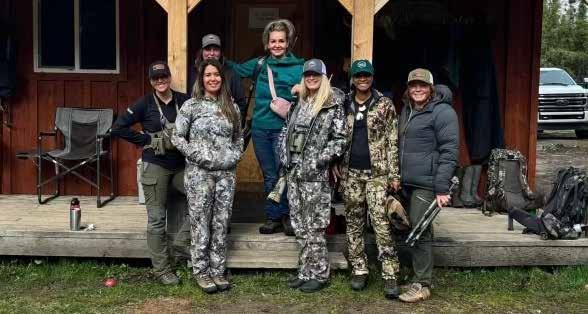
growth for outreach to the broader community of women hunters and conservationists. From a program that started as a grant opportunity to help train and educate while also providing a nurturing place to build friendships—it was inspiring to see these women step up to the plate and push themselves through their comfort zones. From humble beginnings, it felt as though everything came full circle as we brought women together—and now are beginning to see the fruits of this program as it empowers and encourages women to reach out with their new skill sets, book hunts, and make memories for themselves.
Born from a desire to help find and embellish skill sets, build a place for community, and help support the existing cohort of hunters worldwide—we are absolutely enthusiastic about the growth of our Women Hunt® program. The program annually takes in 12 blind auditions, where they are given the opportunity-of-a-lifetime at the FTW Ranch in Texas. Our intensive Women Hunt® grant opportunity and Industry Field to Fork Course has successfully hosted 41 women through its door, each and every one of them with memories and a skill set that has since found them in
some amazing opportunities—not only as new hunters, but volunteers as well—and now spokeswomen for the mission. Through each year of our program’s growth and notoriety, we continue to return with higher ratios of applications and eager interest.
Through all of the growth and tremendous feedback, we also will be continuing to grow our program to be more inclusive to the large community of women. Our best success is when we are all learning together, and after the rave accolades that we have experienced, we are setting our sights to meet the needs for women that have advanced beyond our initial programs, and continue to support the ever-growing community.
Since the start of the Women
Hunt® program in 2020, the community has grown exponentially each year. With cross branding opportunities to help maintain and pursue our mission of helping empower women, we are excited to announce more opportunities into the future to help bring inclusivity to women of all skillsets and levels. As our programs begin to roll out beyond our grant opportunity and our new Industry Field to Fork program, be sure to keep up with our campaigns for Women In Hunting®, and Women In Hunting Initiative® that will be rolling out on our new website set to launch later this summer!
Presently, our committee has been diligently working through the applications and will be soon announcing the Women Hunt® Class of 2024 at the beginning of August. Best wishes to all of the hopeful candidates!
Teaming up for our first-ever industry event, the Women Hunt® committee is proud to have offered the inaugural Field to Fork New Hunter and Rifle Training Course in May 2024. This exciting annual program is set to offer a stage where women who work in the hunting, shooting, and outdoors industries will be able to hone their skills

behind the barrel, as well as learn some of the best practices for game preparation, all while being able to network and collaborate with like-minded women from these communities!
With the rave reviews we get from our Women Hunt® alumnae and our wonderful relationship with the fabulous team in Texas, we are set to take this course to the renowned FTW Ranch every year. This comprehensive course will include over 50 hours of training in conservation, animal behaviour, various hunting methods, postharvest care, wild game cooking, federal, state, and local laws and customs. The program will also include basic navigation, a breakdown of firearm systems, fundamentals of marksmanship, shooting positions, and shot placement.
The course is designed to cover all aspects of hunting, the conservation around the practice— as well as a safe and encouraging place to learn more with a likeminded group of individuals. With the measurable success of the Women Hunt® grant opportunity, our goal is to help include and expand the growing community of women—the women who hunt—and the community that this brings together. This will be an open-to-the-public course with details soon to follow! This year alone, three WSF staff members had an opportunity to get behind a rifle and take in the course. Even though they came from hunting and conservation industry backgrounds, they had little or no hunting or shooting experience— and these women found it to be a life-changing event!
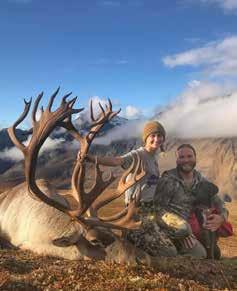
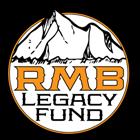
The Wild Sheep Foundation is as much an extended family as it is a tradeshow of kindred spirits. Tragically, in May of 2023, we lost one of the kindest souls that had come to be a friend to many at the show. Rubye Mayflower Blake was a woman who approached life with a zest and passion that would inspire anyone, with a life-changing story that brought people together from all walks and disciplines. She is survived by her husband, Derek Blake, and a beautiful baby girl, Harbor. In honour of Rubye, and in partnership with the Wild Sheep Foundation and Women Hunt®, Derek has founded the Rubye Mayflower Blake Legacy Fund.
The Rubye Mayflower Blake Legacy Fund has a mission to empower women recovering from traumatic experiences by fostering healing through the transformative
power of nature. The Legacy Fund is a dedicated and protected fund under the Wild Sheep Foundation’s Women Hunt® program. Derek has built a committee who are currently developing a process to provide life-changing and healing outdoor experiences to survivors, and they look forward to selecting the first woman this year!
Be sure to watch for our new event Women Hunt® Presents a Women in Hunting® ‘Beers & Bubbly’ Event at the Wild Sheep Foundation’s Thursday night gathering prebanquet in the Peppermill banquet foyer. We invite you to join us for a free beverage at the foyer in front of the Tuscany Ballroom on Thursday night! The event will kick off at 5 PM with a short acknowledgement from a very special guest speaker who will also keynote the Life Member Breakfast Saturday morning, as well as a showcase of the photo submissions we receive leading up to the event. Be sure to check for our updates as we are planning on celebrating the community as well as giving away some very cool prizes supporting this initiative!
Be sure to keep on the lookout for our new and exciting collaborations throughout the fall as we prepare to head down to the much-anticipated Wild Sheep Foundation’s 2025 Sheep Week®! WS
Renée Thornton, Chair
Rachel Ahtila
Julie Chapman
Linda Demmer
Brandi Love
Sue Skold
Meet the Wild Sheep Foundation’s Women Hunt® Committee
Bios and photos at: www.wildsheepfoundation.org/ about/women-hunt-committee
Women Hunt® wants to hear from you!


https://www.wildsheepfoundation.org/womenhunt womenhunt@wildsheepfoundation.org @womenhunt @women_hunt @womenhunt

DSC’s mission is to ensure the conservation of wildlife through public engagement, education and advocacy for well-regulated hunting and sustainable use.
The vision of DSC is a society that values wildlife, engages in its conservation and understands and supports the role of well-regulated hunting in the sustainable use of wild resources.
To become a member or learn more about DSC, head to biggame.org.




by Joshua Schwencke WSF & Women Hunt® Executive Chef in Residence

Somewhere in a remote part of the world most of us will never travel is a small open-air market. This isn’t your American-style farmer’s market. Far from it. It’s the lifeblood to those who call this area of the globe home. Without it, feeding their families would be near impossible. Daily visits to such a place results in access to fresh produce while also offering the opportunity for more home cooking.
In my travels as a young man in northern Mexico, I came across such markets. Full of life, music, and foods that remain alien to their star-spangled-clad neighbors to the north. This remains a shame in my eyes to be deprived of such culture. Such color. To know that flavors so readily available are so close to my
home in south Texas.
While walking through the market, I recall the fresh yet overripe quality of the produce. Not present in such a place is the perfectly stacked assortment of roma tomatoes, free from blemishes and flavor. What caught my eye, however, were the spices and herbs. Their aroma would fill the senses and draw you in, only to compete with the smell of cooking carnitas nearby.
This is my eyes-shine-light on our stale American palette. When mentioning spices to most in the states, their first thought may be that of a small container of dried powder dawned with a red lid and sitting idle in their cabinet. Or maybe the last-minute purchase to complete an online recipe damned
to a life of never being utilized again. When fresh herbs are the topic, the plastic-wrapped, storebought, limited selection is what remains the norm.
One thing I will not assume is that everyone cooks the same with spices and herbs. I will, however, go off my experience in speaking to countless people about their cooking at home. The underutilized knowledge of how to cook with herbs and spices in your everyday cooking is something that I’d like to see change. I describe this as the void of spiritual essence in our modern day American gastronomy.
Herbs have been long valued for their medicinal qualities and harbor vitamins ranging from calcium, magnesium, iron, and vitamins A, K, and B6. All this is a benefit to
Scan
the flavor they add to your game cooking. These flavors are the hydrocarbons that are the actual defense mechanism of the plant. Because we consume so little of these chemicals in herbs and spices alike, their effort is futile but delicious.
Herbs showcase their superpower far different from spices. The abundance of moisture that is still within an herb’s cell walls adds a fresh and vibrant flavor much different than their dried variation. The fresh herb in it’s natural state lends itself to multiple applications like finishing a soup or to be added to a stir fry. The plate of fresh basil and mint arriving at the table of your favorite Phở restaurant is a prime example of their importance of use at the end of the cooking process. When parsley is added to the top of your steak it not only adds color but also freshens the pallet and helps aid in digestion.
Fresh herbs belong at the end. Period. Using them in the start of the cooking will extract their chemicals, dissipating them into the air and not into the food. However dried spices bring a different approach. These are not just the dried version of fresh herbs but also are the use of crushed seeds, roots, and other parts of the plant.
Spices are a category all their own and should be treated as such. Their contribution to a recipe is at the beginning of the cooking process. Adding them to the end does little

to nothing in the way of flavor and can have an overly woody taste depending on the spice.
Due to the dried nature of their cell walls, spices need heat and sometimes moisture in order to break down and dissolve into the rest of the food. Many MiddleEastern, Indian and Moroccan recipes showcase the roasting of dry spices in a pan as the first course of action, thus releasing the hydrocarbons into the air. This roasting of the concentrated oils still left in the dried bark, seeds, or roots is what brings layers of flavor and body to your cooking.
It should also be mentioned that the celebration of herbs and spices from across the globe is something that must also be celebrated stateside. These microcosms of ingredients across the map are as diverse and colorful as the people who harbor them.
With Europe and Asia being the major powerhouses of herbs in the world, this map gives a good understanding of utilization of their treasured ingredients. Spices are more predominate in the arid, desert areas of the Middle East. This is not only due to the climate, but also the historical trade of such ingredients. This exchange between regions changed the world’s culinary map for the better.
Applying spices and herbs to your game cooking can be as easy as selecting a region, focusing on
the ingredients, and applying your protein. These zones offer multiple cooking methods that can be easily adapted. Due to the climate of the regions, fresh herbs are more predominant on the European and Asian continents. Likewise, the arid Middle East is the home to most of the world’s dried spices. The map at left showcases these flavors in their birthplaces of many of our modernday ingredients in use.
Most herbs from around the world, primarily in Europe are that of either the mint family (such as sage and basil) or of the carrot family (such as dill and fennel). Some herbs also have major parts to play in two or more areas of the globe. An example of this is cilantro. The market I walked through was adorned with this fragrant herb. This setting would mimic that of an African or Asian market where it’s called coriander, even in it’s fresh and leafy form. These are both similar to their Caribbean cousin, chadon beni, in flavor and use.
What is important to remember in all cooking, also applies to the usage of herbs and spices. Use often and use properly. To miss out on the flavor packed within it’s cell walls would be a shame. A little knowhow and some proper application will help you not only add much needed phytonutrients to your cooking, it might also change your cooking all together. WS


by Ryan Brock, Ph.D. WSF Youth Education Coordinator

Caddo, Texas was certainly an unfamiliar location to the seven families prior to the fourday outdoor learning experience that took place there at the end of October. However, by the end of trip, no one would forget this place in the future, as lifelong memories were profoundly created there.
The Shooting, Hunting & Ethics Education Program (S.H.E.E.P.) took on the role of travel agent in creating an opportunity for eight hunters and their families to fly to Texas, rent three vehicles, and drive to a ranch so they could experience their first pig hunt. The icing on the cake was the fishing that also took place during the day. The goal of the
trip was to create a lasting memory for the hunters and their families which offered a positive experience of hunting, learning how to clean wild game, and understand how a state such as Texas is working to counteract the issue of wild pigs in their state by using hunting as a conservation tool.
Once arriving at Walking Cane Ranch and viewing the lodge where the families were going to spend the next three nights, the group knew right away that this was off to a great start. The bunkhouse was another perfect fit for the experience. Totally family-friendly with rooms featuring bunkbeds, a lounge area, kitchen, pool table,
plenty of bathrooms and showers, and even an indoor BBQ pit; the feel was one of togetherness. It would be a place where the group could get to know each other over the next several days, eat some good meals, and socialize and hang out when not in the field.
Jacob Boyd, of Boyd Hunting & Recreation, who manages the wildlife on the ranch met the families there upon their arrival. After a quick introduction to the bunkhouse, hunters and their families speedily prepared to get into the blinds for the evening’s pig hunt, as the group arrived a little later in the day than expected. It was obvious to the keen eye that

Jacob knew this first night was going to be anything but ideal, with the late arrival and trying to get eight groups into blinds early enough before the pigs came out. Yet, he didn’t stress any of the families and in a short time two rental vehicles and his UTV were headed down the muddy road, opening and closing gates so the cows would stay where they should.
One by one, groups of two, were dropped off and told clearly how to follow each road up to the blinds. Each youth was accompanied by
their parent, and the one twentyone-year-old who had just got her hunter-safety card within the last year was with her boyfriend, who had grown up in a hunting family. The first night, all eight blinds were full by about 6:15, well after the ideal time of getting in early so as not to disrupt the pigs. Regardless, within minutes of sitting down one fourteen-year-old had shot a pig and was sending out a “success” text to a few others. An hour later, an eleven-year-old had harvested her first pig as well.
DO YOU KNOW A TEACHER WHO TEACHES LIFE SCIENCE, OR THEMED UNITS ON WILDLIFE?
The Wild Sheep Foundation has put together an educational kit that includes a variety of information and hands-on items that teaches about bighorn sheep and their conservation. The kit can be checked out for week-long segments for free and shipping is paid for.
Kit includes a ram skull, GPS collar, hide sample, curriculum book with over 20 lessons, Ovisopoly game, consumables to hand out to the students, a curriculum book and a USB drive with PowerPoints and movies for lessons with an optional “talk to a sheep expert” through Skype or Zoom class meeting.
To reserve your week, contact: Ryan
Brock Youth Education Coordinator Rbrock@wildsheepfoundation.org
As the group hunted, Jacob’s family prepared an amazing dinner of tacos, beans, and rice, having it ready to consume when they returned around 9 p.m.
Stories started immediately as all were interested in seeing the harvested pigs. No one in the group, even parents, had previously been on a hunt such as this. Soon, stories of whitetail and raccoons coming into the feeders were shared. Certainly, a very successful night for the group.
With the group being from out



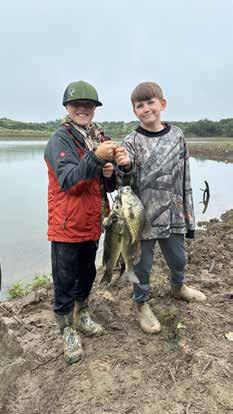
of the area and coming in by plane, Jacob helped line them up with Ray’s Wild Game Processing in Breckinridge, about 15 minutes away. The following day, the two small pigs were driven in and dropped off. The goal was to get enough meat during the trip so that all families could try the wild pig meat back at home. The processor was super helpful, and although they wouldn’t be able to turn around the meat fast enough for the group to take it back with them, they prepared the sausage to be shipped back.
Luckily, Jacob’s family was kind enough to do some shopping the prior evening for the group, using a grocery list made on the airplane. The families cooked a giant brunch and then were given directions on how to drive to two bass ponds on
the property. A few mid-day hours of fishing proved to be successful. Catching over twenty largemouth bass, huge catfish, and crappie, all were released except for a few that were determined to be cleaned and cooked back at the ranch for a snack. Luke Briant, a sixth grader, mentioned that “crappie were a unique kind of fish…and were really good tasting.” He certainly was the ringleader when it came to inspiring others to take fish back to clean and cook.
The weather began to change the second day, and unlike the first evening where the blinds were almost a little too warm, the second day offered quite a bit of rain and a substantial cool down.
Getting into the blinds much earlier and knowing a little more about what to expect, the group had also developed a more thoughtful “group text”. As soon as the sun set, texts started announcing sightings of various animals and
successful hunts. Everyone was in awe as the three pigs harvested this second night were much larger than the younger ones the prior night. All were cleaned, with some meat reserved to be cooked the next day right on site for all to try. Once again, the Boyd family had an amazing dinner waiting for all to enjoy after returning late.
The coolness drastically changed to cold the following day as more rain saturated the area and a true cold front moved in. The group didn’t get discouraged, and although a few stayed back to “help” cook the meat, the majority headed back to the bass ponds and had suprising success considering the drop in temperature.
As the vehicles headed out for their final evening of hunting, the rented Jeep Gladiators no longer reflected that rental car shine but were caked in mud inches thick. With the temperature around 40 degrees at dropoff around 4 p.m.,



Dedicated to education, Dedicated to education, supporting the research & supporting the research & conservation of mountain goats conservation of mountain goats
Memberships available through
Memberships available through WSF for $40 per year. WSF for $40 per year. Join our efforts today!



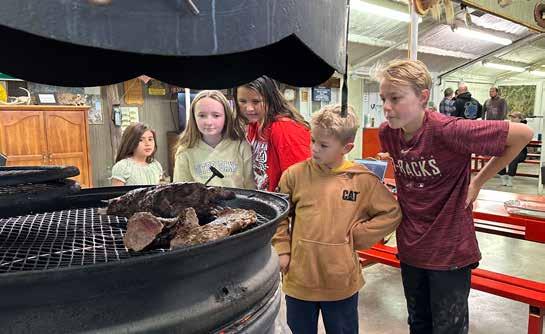
the group knew the evening would be the coldest yet.
Wind and a chilling rain battered the blinds and those inside the entire time. Lights by the feeders, unable to charge throughout the day due to lack of sun, made hunting even more difficult. A few blinds had lights use up their charge within thirty minutes, while another simply refused to turn on. As the temperature dropped into the mid-30’s, some groups began to move out of the blinds early, only to be informed that pigs had either come into the blind minutes after they left, or were spooked as one group was picked up by another, fouling up an opportunity. Two hunters did get shots off. As with novice hunters, and the nerves of taking a shot, the two who had opportunities were unsuccessful in bringing a pig back.
Even with a night of being unsuccessful, lessons were learned. Not every hunt is successful and there are often forces outside of
one’s control that can impact a good hunt. Fifteen-year-old Bryce Dillard found education even outside of the hunts. He reflected, “It was kind of nice to come down here and see all the people. Everyone was just super nice. We saw people pull over on the side the road to just let you drive by every now and then.” A final dinner at the bunkhouse, along with some pig backstraps and a hind quarter gave all a taste of how delicious this meat can be.
The following day, the three vehicles departed the ranch. Much of the two-hour trip to the airport centered in at least one vehicle, around other hunting opportunities that the youth wanted to pursue in the future. With memories made, and knowing some good sausages would be delivered to all in the near future, the group departed back home to realities of work and school.
In reflecting upon the experience, the father of Sophia Chase said,
“My daughter is a competitive archer and had always wanted to go hunting. This trip could not have been any better for a first time hunt. My daughter learned a lot about gun safety, patience, and perseverance.” Sophia was able to take a shot at a pig on the final night, but with her heart pounding in excitement and her adrenaline pumping, the shot was unable to connect. Joe continued by saying, “Even though she missed, she is now super excited about getting home and taking shooting lessons to get better.”
Boyd Hunting & Recreation provided an amazing experience to these fifteen individuals. Their patience with the kids and new hunters and the way they created an environment of “family” right alongside their own, helped to make this a truly enjoyable time. The Wild Sheep Foundation hopes to be able to re-create this type of experience in the near future.
Perhaps the mother of one of the youth shooters summed the experience up best. Heidi recounted that her son and her “had a great experience hunting and fishing in Texas! It was amazing, not just for the youth, but also for the parents to experience both hunting and fishing at a very nice ranch. Dr. Brock’s motivation to get more youth into hunting and fishing, along with adding parent participation has been amazing. I can’t thank the Wild Sheep Foundation and its donors enough. Their support….to provide opportunities like this is appreciated and is definitely making a difference in getting more people interested in conservation.” WS

This badge.






by Ashley McEnroe
by Jim Manley
Anne Lamott, the witty and insightful author of the classic Bird by Bird, is an oft-quoted source on the writing way of life.
“One of the gifts of being a writer is that it gives you an excuse to do things, to go places and explore. Another is that writing motivates you to look closely at life, at life as it lurches by and tramps around.”
These writer’s gifts are evident in the newly released inaugural book by WSF member Jim Manley, Tracks on a Mountain: Journeys of a Sheep Hunter. In his conversational style, Manley’s 419-page memoir recounts his 12 sheep hunts in honest detail, avoiding any chest-beating braggadocio while documenting the grind, hopes, frustrations, joys and miseries that attend a wild ram hunt. As he lurches and tramps around sheep country, Manley examines the natural world and reflects on life’s essence that he finds through hunting.
Starting with a dream-dashing Dall’s attempt, Manley packs us along as he is reborn professionally and as a hunter. Optimistically daring new feats and defying the painful limitations of his increasingly battered and aging body, he almost surprises himself as he grasps weathered old full curls on mountain after mountain. His only constant companion: a small chunk of jade carved into a ram’s shape that Manley stashes in his pocket on each journey. That green charm naturally symbolizes Manley’s ascent from a jaded

greenhorn with a narrow view of his ram prospects to a seasoned mountain sheep devotee.
As a hands-on business owner, Manley must balance daily life responsibilities with his ram reveries. He is a realist unafraid to seize opportunities to satisfy his yearnings and set bold new goals. Along the way, he meets sharp, candid and colorful guides and witnesses landscapes that ceaselessly enchant Manley, whether or not sheep are there.
In Lamott’s words, “In order to be a writer, you have to learn to be reverent. If not, why are you writing? Why are you here? … Think of reverence as awe, as presence in and openness to the world.” Manley’s reverent soul is imprinted on each page of Tracks. A mountain man’s face that
nature etched onto a cliff seems to encourage Manley with silent advice to keep after the hunt and enjoy every second of it, even in the most trying circumstances, whether it’s destroying his knee in a devastating fall, a wounded ram disappearing without a trace or choking down dreaded oatmeal every morning. Manley notes the little things that leave lasting impressions: the scent of fir-bough mattresses, the aroma of frying bacon, the purifying breeze after a passing downpour, the spectacular taste of grilled meat after a daylong slog back to camp with a ram-laden pack.
While Tracks opens its chapters with timeless quotes from Jack O’Connor, its contents reflect the modern realities of sheep hunting, a far cry from O’Connor’s often self-guided, several-week affairs.

Booking a guided hunt and sometimes purchasing a costly auction tag is the norm not the exception today for anyone in search of all four North American wild sheep or rewards like 700 Club achievement. Though guided, these hunts are pressure-packed in terms of cost, time limits and the stresses of missing work. Manley describes these factors weighing on him and pushing each decision.
Yet, he does not use the guided experience as an excuse to sandbag in the high country. Manley is a hunter, not just a collector or hunttourist. He earns his glory, trusting his own judgement, shooting confidently and accurately, cutting up the downed animals, cleaning skulls, helping out when horses bolt, lending a hand with camp chores and shouldering heavy camp gear. He earns it by adjusting his attitude when weather, delays, bodily injury, equipment malfunctions, a swamped Argo and a sickening, less-than-optimal shot threaten to crush his morale. The episode of the condensation fogging the interior of his rifle scope while sheep loomed on the horizon was memorable proof of Manley’s seasoned hunter’s coping skills. In every travail, Manley is anything but a whiner. When he realizes he has reached his first FNAWS at long last—about halfway through the book—he and his guide have nothing more to toast with than creek water while sleeplessly shivering in the dark without the comfort of tent, sleeping bags or dry clothes in griz country. Throughout the ordeal, he remains upbeat and grateful. Such hard-scrabble moments make

Manley’s luxurious La Palmosa Mexican desert ram hunt a welldeserved respite, as well as an interesting tale. Bringing the reader into the discomfort zone then back to a warm campfire, Manley offers a clear-eyed account of what the aspiring sheep hunter will face in embarking on any guided wilderness ram quest.
Of the 12 sheep hunts in this book, I found Manley hit his stride as a writer in chapter 8, the BC Stone’s and elk adventure with Big Nine guides Stephanie Shippy and Amanda Tompkins. I also enjoyed the outfitters and guides recap at the book’s end, plus the wildgame recipes Manley thoughtfully included. Though self-published, the book reflects dedication to quality publishing, professional editing and photography that brings the stories to life (the photos by Darryn Epp are downright spectacular, no surprise). Anyone dreaming of seeing their own book in print should do exactly what Manley did in producing Tracks. Lamott has said that perfection is the enemy of an author’s creativity,
and certainly Tracks is not perfect. The terms “once-in-a-lifetime” and “sheep fever” were used a bit too often throughout the book. I would have relished to read more natural history of the remote places Manley saw and the backstories of the often multi-generationally pedigreed mountain outfitters, guides and pilots the author encountered. Some of Manley’s trips were returns to a previously visited hunting area, and this gave parts of those chapters a somewhat repetitious feel.
Nonetheless, any fan of Wild Sheep® magazine and hunting stories in general will find it an engaging and informative read. As a WSF Summit Life member, donor and volunteer, Manley carries a sincere sheep-conservation spirit and found a way in Tracks to convey it with witty, sincere and solid style. Though admirably successful, Manley writes of himself with humility and humor to the point you can’t help but feel the author is a friend you want to follow chapter by chapter, hunt after hunt.
The sum of this book satisfies Anne Lamott’s standard: “Good writing is about telling the truth. We are a species that needs and wants to understand who we are.” Manley’s earnest, often soulful, truth telling about not just his sheep encounters but also life in its purest distillation does, indeed, give fellow sheep seekers and outsiders to the world of wild rams an understanding of who we are and why we do what we do.
Tracks on a Mountain: Journeys of a Sheep Hunter by Jim Manley is available for purchase at www.tracksonamountain.com. WS
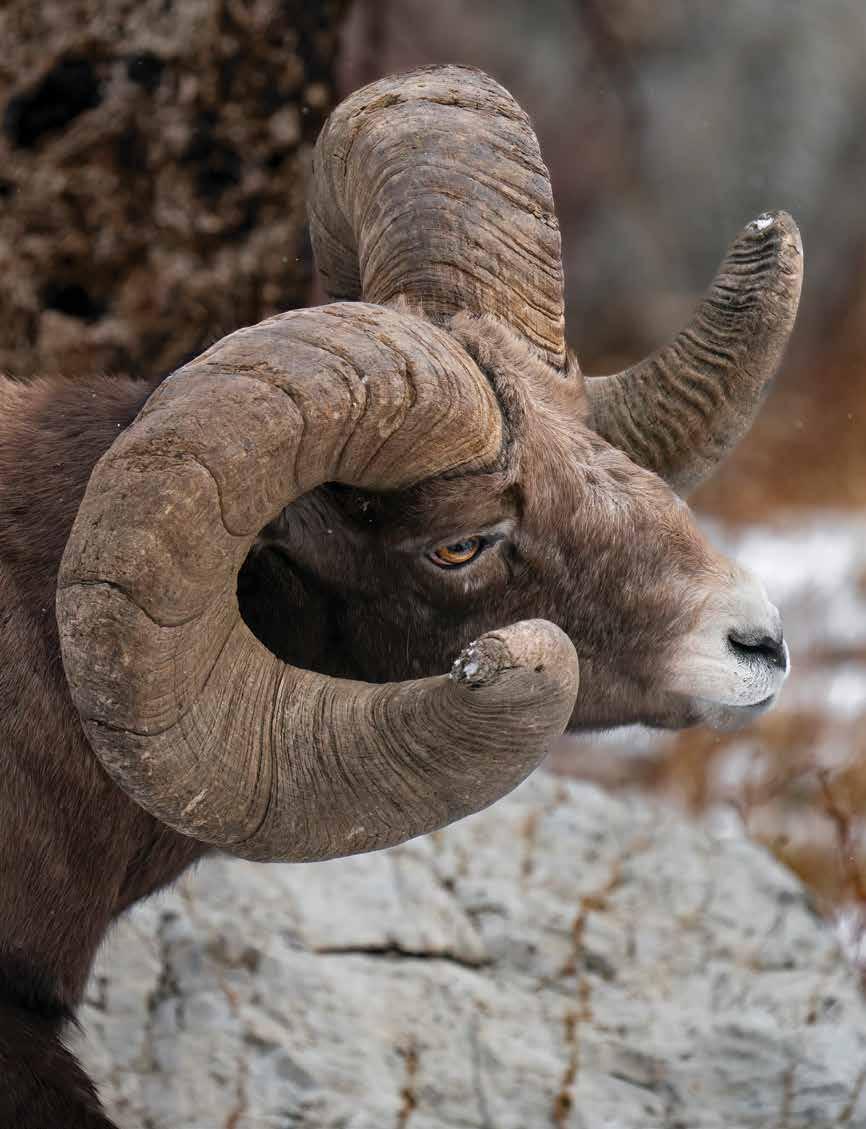



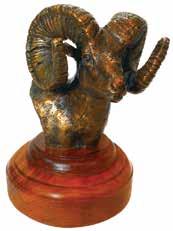



AR1
ONE OF A KIND LOST WAX ORIGINAL BRONZE OF THE BUYER’S CHOICE (100% FULLY DONATED)
JUSTIN YOUNG FINE ARTS
Justin Young P: 719.336.2556
E: jyoungfineart@hotmail.com




W: www.justiniyoung.com
AR2
BIGHORN RAM BUST (100% FULLY DONATED)
JUSTIN YOUNG FINE ARTS
AR3
ORIGINAL WILDLIFE ART BRONZE & PAINTING COMBO “WHITETAIL DEER” (100% FULLY DONATED)
CRAIG PHILLIPS ORIGINALS
Craig Phillips
P: 406.827.3702
W: www.phillipsbronze.com
AR4
ORIGINAL OIL PAINTING BIGHORN SHEEP PORTRAIT JOSHUA SPIES
E: spies@joshuaspies.com
AR5
“SPEED KILLS” 20X30” LIMITED EDITION CANVAS GICLEE THE DEVINE GALLERY
Dan Devine
P: 905.560.1653
E: dan@dandevine.net
W: www.dandevine.net
AR6
“THE BOYS” ONE-OF-A-KIND CERAMIC TILE ART -CONSISTING OF 24 ONE INCH TILES (4’X6’) (100% FULLY DONATED)
MARQUIS AWARDS & SPECIALTIES, INC.
John & Terry Collins P: 307.754.9577
E: terry.marquis@outlook.com
W: www.rushawards.com
AS1
3 - DAY SINDH IBEX (UP TO 39") HUNT IN PAKISTAN FOR 1 HUNTER(TROPHY FEE UP TO 39" IS INCLUDED -$1,000 PER INCH OVER 39)
CAPRINAE SAFARIS OF TURKEY
Mehmet Alkan & Riza Gozluk P: +90.532.583.9108
E: info@caprinae.com W: www.caprinae.com
B1
3 - DAY WATERFOWL & SAND HILL CRANE HUNT IN ALBERTA CANADA FOR 1 HUNTER (100% FULLY DONATED)
AMERI-CANA EXPEDITIONS INC.
Nick, Dan, & Pat Frederick
P: 780.469.0579
E: ameri.cana@shaw.ca
W: www.ameri-cana.com
EU1
4 - DAY IBERIAN MOUFLON SHEEP HUNT FOR 1 HUNTER IN SPAIN (Trophy fee included for 1 Iberian mouflon)
GIUSEPPE CARRIZOSA - SPAIN
Giuseppe Carrizosa
P: +34.68.693.5651
E: giuseppecarrizosa@gmail.com
W: www.giuseppecarrizosa.com
EU2
4 - DAY TROPHY ROEBUCK HUNT IN SWEDEN FOR 1 HUNTER AND 1 NON-HUNTER WITH CELEBRITY GUEST KRISTY TITUS! (100% FULLY DONATED TO WOMEN HUNT ®)
JR HUNTING LLC
Yogi Rausch
P: 49.172.666.7400
E: info@jrhunting.com
W: www.jrhunting.com
EU3
5 - DAY SOUTHEASTERN IBEX AND BALEREAN BOC HUNT FOR 2 HUNTERS (Trophy fees included for 2 bronze medal southeastern ibex, and 2 bronze medal Balearean boc)
IBERHUNTING SPAIN
Antonio Teruel Farrugello
P: +34 664.283.512
E: iberhunting@iberhunting.com
W: www.iberhunting.com
F1
COLT SAUER SPORTING RIFLE .300 WIN MAG W/CUSTOM ENGRAVING OF A BIGHORN SHEEP (Made between 1974-1985) (100% FULLY DONATED)
Jim Miller
P: 916.804.9225















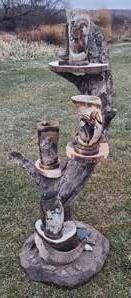



F2
CUSTOM BUILT INTER ARMS .375 H&H MAG WITH 6X32 ZEISS SCOPE
JIM TRAVIS
P: 520.241.0641
E: jtravis17@hotmail.com
F3 “SPECIAL FNAWS EDITION” REMINGTON 700 7MM MAG (100% FULLY DONATED) DALE & DONNA GAUGLER P: 610.909.6000
E: gauglerd@aol.com


M1
FNAWS HORN MUGS ORIGINAL ART
M2 TWO HORN GOBLET ORIGINAL ART ANTLERED ART
Todd Strupp P: 715.642.3937
E: toddstrupp@gmail.com W: www.antleredmugworks.com
M3 (2) WOLF HIDES FOR AUCTION
JIM TRAVIS P: 520.241.0641
E: jtravis17@hotmail.com
M4
HOME THEATER SIMULATION HUNTING PACKAGE - INCLUDES WEAPONS AND MULTIPLE GAMES LASER SHOT
Alan Winslette P: 281.240.1122
E: tradeshows@lasershot.com W: www.lasershot.com
M5
CALIFORNIA KING SIZE SHEARED BEAVER BEDSPREAD JIM TRAVIS P: 520.241.0641
E: jtravis17@hotmail.com
M6
WSF - VIP TABLE FOR 2026 LADIES LUNCHEON IN RENO WILD SHEEP FOUNDATION - LADIES LUNCHEON COMMITTEE P: 406.404.8750
M7
WSF - UPGRADED VIP TABLE 2026 SHEEP SHOW Sold at Each Live Auction!
M8
BIGHORN SHEEP SKULL EMBEDDED IN TREE - FOUND BY STANLEY POTTS - IDAHO (100% FULLY DONATED)
JIM PARKER - PARKER TOYOTA
P: 208.661.0806
M9
THE TACTICAL - T-4-16-HD CUSTOM SERIES
TACTICAL HEARING
Tim Sparks
P: 801.822.6888
E: tim@tacticalhearing.com
W: www.tacticalhearing.com
M10
TROPHY ROOM CLEANING (100% FULLY DONATED)
HEADHUNTER TROPHY CARE LLC
Wade West
P: 817.988.2312
E: trophycare@rocketmail.com
NA1
10 - DAY DALL’S SHEEP/ ARCTIC GRIZZLY/BARREN GROUND/ CARIBOU HUNT FOR 1 HUNTER IN ALASKA’S ARCTIC NATIONAL WILDLIFE REFUGE OR (Hunter’s Choice) 10 DAY DALL’S SHEEP/ BROWN BEAR/BLACK BEAR IN THE LEGENDARY SOUTH WRANGELLS (Wrangell St. Elias Preserve) ALASKA OUTFITTERS UNLIMITED
Aaron Bloomquist
P: 907.982.2471
E: bloomya@hotmail.com
W: www.alaskaoutfittersunlimited.com
W: www.huntalaska.net
NA2
10 - DAY SPRING GRIZZLY BEAR & WOLF HUNT FOR 1 HUNTER MIDNIGHT SUN SAFARIS
Coke Wallace
P: 907.978.0929
E: info@midnightsunsafaris.com
W: www.midnightsunsafaris.com
NA3
12 - DAY MOUNTAIN GOAT IN BRITISH COLUMBIA FOR 1 HUNTER (100% FULLY DONATED FOR WSF THINHORN INITIATIVE)
GOLDEN BEAR OUTFITTING
Blake Williams
P: 250.794.8350
E: gbowilliams@gmail.com
W: www.goldenbearoutfitting.com









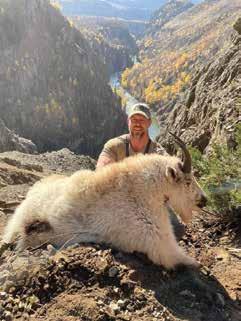










NA4
12 - DAY SPRING KODIAK ISLAND
BROWN BEAR HUNT FOR 1 HUNTER
ROHRER BEAR CAMP
Sam Rohrer
P: 907.486.4074
C: 907.539.1828
E: sam@kodiakbearcamp.com W: kodiakbearcamp.com
NA5
10 - DAY ALASKA-YUKON
MOOSE HUNT FOR 1 HUNTER IN NORTHWEST ALASKA
FREELANCE OUDOOR ADVENTURES
Lance Kronberger
P: 907.854.2822
E: freelanceOA@mac.com
W: www.freelanceoutdooradventures.com
NA6
2 - DAY HUNT FOR HYBRID EUROPEAN MOUFLON/HAWAIIAN
SHEEP FOR 1 HUNTER AND 1 DAY DEEP SEA FISHING FOR UP TO 3 PEOPLE
(100% FULLY DONATED)
MAUNA LOA OUTFITTERS
Colin Onaka - WSF Life Member
Steven Onaka
P: 808.960.7373
E: MaunaLoaOutfitters@gmail.com
Capt. Mark Bartell of the Ambush P: 808.366.4808
NA7
10 - DAY MOUNTAIN CARIBOU HUNT FOR 1 HUNTER IN NWT CANADA
(100% FULLY DONATED) RAVEN’S THROAT OUTFITTERS
Griz & Ginger Turner P: 867.332.7286
E: hunts@ravensthroat.com W: www.ravensthroat.com
NA8
4 - DAY MULE DEER HUNT FOR 2 HUNTERS
SHOSHONE LODGE OUTIFTTERS & TRAILS WEST OUTFITTERS
Josh Martoglio P: 307.899.4673
E: shoshonelodgeoutfitters@gmail.com
W: www.shoshonelodgeoutfitters.com
NA9
10 - DAY ALASKA YUKON MOOSE BACKPACK HUNT FOR 1 HUNTER NWT OUTFITTERS
NAHANNI BUTTE OUTFITTERS
Jim & Nadine Lancaster/Clay Lancaster P: 250.847.1855
E: jladventures@xplornet.com W: www.lancasterfamilyhunting.com
NA10
10 - DAY LA PALMOSA DESERT SHEEP HUNT FOR 1 HUNTER AND 2 NON-HUNTERS (100% FULLY DONATED)
LA PALMOSA - HUNTING OUTFITTER
Emilio Espino
P: +521.811.916.4668
E: info@lapalmosa.com
NA11
6 - DAY ALBERTA WHITETAIL DEER HUNT FOR 1 HUNTER (100% FULLY DONATED)
CARTER OUTFITTING LTD.
Scott Carter
P: 780.977.8188
E: carteroutfitting@gmail.com
W: www.carteroutfitting.com
NA12
12 - DAY DALL’S SHEEP/WOLF/ WOLVERINE HUNT IN THE NORTHWEST TERRITORIES FOR 1 HUNTER & 1 NON-HUNTER
GANA RIVER OUTFITTERS LTD.
Harold Grinde
P: 403.357.8414
E: ganariver@pentnet.net
W: www.ganariver.com
NA13
3 1/2 - DAY AOUDAD HUNT FOR 1 HUNTER IN WEST TEXAS HIGH WEST OUTFITTERS
Jim Breck Bean
P: 915.526.3001
E: highwestoutfitter@yahoo.com
W: www.highwestoutfitter.com
NA14
12 - DAY STONE’S SHEEP HUNT IN NORTHERN BRITISH COLUMBIA (100% PROCEEDS TO SUPPORT NW BC STONE’S SHEEP INITIATIVES) SPATSIZI RIVER OUTFITTERS
P: 250.847.9692
E: mike_gilson@bcsafaris.com
E: admin@spatsizi.com
W: www.spatsizi.com
NA15
5 - DAY COLUMBIA BLACK-TAIL DEER & COASTAL BLACK BEAR HUNT FOR 1 HUNTER (100% FULLY DONATED) SPOON CREEK OUTFITTERS
Ken Wilson
P: 541.396.2726
E: spooncreek13@gmail.com









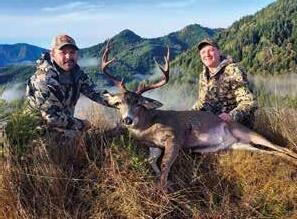











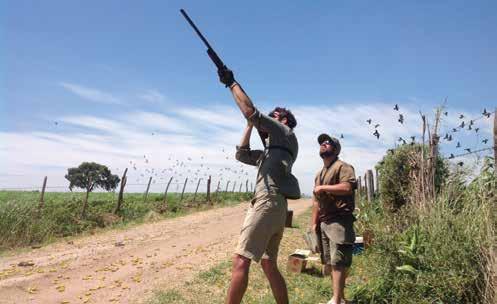

SAF1
3 - DAY BLESBOK & BLACK WILDEBEEST HUNT AND 2 DAYS OF FISHING FOR 1 HUNTER IN SOUTH AFRICA (100% FULLY DONATED)
J P BIG GAME SAFARIS
Dean & Juan Pace
P: +27.732.137.902
E: jpsafaris@outlook.com
W: www.jpsafaris.com
SAF2
3 - DAY COW BUFFALO HUNT FOR 1 HUNTER IN SOUTH AFRICA (100% FULLY DONATED)
J P BIG GAME SAFARIS
Dean & Juan Pace
P: +27.732.137.902
E: jpsafaris@outlook.com W: www.jpsafaris.com
SAF3
5 - DAY WATERBUCK HUNT FOR 1 HUNTER IN SOUTH AFRICA (100% FULLY DONATED)
J P BIG GAME SAFARIS
Dean & Juan Pace
P: +27.732.137.902
E: jpsafaris@outlook.com
W: www.jpsafaris.com
SAF4
7 - DAY SOUTH AFRICAN HUNT FOR 4 HUNTERS ($1,000 credit towards trophy fee, single hunter can be entitled to one credit) (100% FULLY DONATED) IBAMBA SAFARIS
Johan & Zelda Pretorius
P: +27832261690
E: johan@ibambasafaris.com
W: www.ibambasafaris.com
SAM1
3 - DAY/3 - NIGHT DOVE HUNT IN ARGENTINA FOR 4 HUNTERS AND 4 NON-HUNTERS (100% FULLY DONATED) NORTE HUNTERS
Paula Cardelle
P: 972.528.4770
E: nortehunters@gmail.com
W: www.nortehunters.com
TAX1
LIFE-SIZE NORTH AMERICAN SHEEP MOUNT
(100% FULLY DONATED) THE WILDLIFE GALLERY
Dan & Charlotte Catlin
P: 989.561.5369
E: dan@thewildlifegallery.com
W: www.thewildlifegallery.com
TAX2
LIFE-SIZE WILD SHEEP MOUNT WITH HABITAT AND BASE DEER CREEK WILDLIFE STUDIO
Josh Hunt
P: 307.272.3718
E: deercreekwildlife@icloud.com
W: www.deercreekwildlifestudio.com
TR1
WINE TASTING FOR 50 PEOPLE ANYWHERE IN THE CONTINENTAL USA
(2 of these Wine Tasting will be available for auction)
AFRICAN TRADITION
Clive Botha
P: 561.379.8243
E: blksem7@aol.com
W: www.sabestwine.com
SSR1
12 - DAY STONE’S SHEEP HUNT IN NORTHERN BRITISH COLUMBIA SPATSIZI RIVER OUTFITTERS
P: 250.847.9692
E: mike_gilson@bcsafaris.com
E: admin@spatsizi.com
W: www.spatsizi.com
SSR2
5 - DAY ALASKAN CARIBOU HUNT FOR 1 HUNTER ALASKA HUNTING
EXPEDITIONS, LLC
Jim Kedrowski
P: 907.373.4773
E: jimkedrow@mtaonline.net
SSR3
8 - DAY SPRING MUSKOX ADVENTURE FOR 1 HUNTER CANADA NORTH OUTFITTING
Tony Mudd
P: 775.690.6300
E: Tmudd@canadanorthoutfitting.com
W: www.canadanorthoutfitting.com
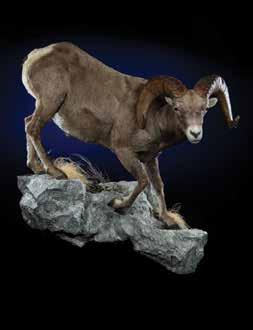












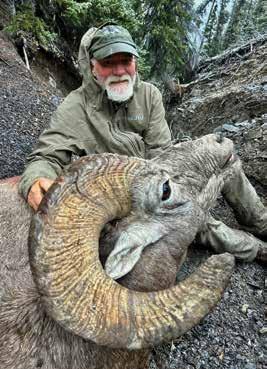

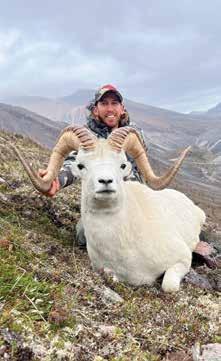
SSR4
7 - DAY LATE SEASON MOUNTAIN GOAT HUNT IN ALASKA FOR 1 HUNTER - SHEEP SHOW 2024! (100% FULLY DONATED)
ULTIMA THULE OUTFITTERS
Paul & Donna Claus
E: jaystanford@ultimathulelodge.com
W: www.ultimathulelodge.com
SSR5
ULTIMATE FLORIDA EXPERIENCE FOR TWO PEOPLE (2 alligators, peacock bass, snook, redfish, tarpon, sea trout cobia & much more!) (100% FULLY DONATED)
BIENVENUE OUTDOORS
Camille Bienvenue P: 941.806.8062
E: bienvenueoutdoors@outlook.com
W: www.bienvenueoutdoors.com
SSR6
10 - DAY BROWN BEAR HUNT ON THE AK PENNINUSULA ALASKA HUNTING EXPEDITIONS, LLC
Jim Kedrowski
P: 907.373.4773
E: jimkedrow@mtaonline.net
SSR7
14 - DAY BIGHORN SHEEP HUNT 2024 SHEEP SHOW RAFFLE CARTER OUTFITTING LTD.
Scott Carter
P: 780.977.8188
E: carteroutfitting@gmail.com
W: www.carteroutfitting.com
<1 1
12 - DAY HORSEBACK DALL’S SHEEP HUNT, ONE WOLVERINE AND 5 WOLVES FOR 1 HUNTER (2025 <1CLUB) NORTHCURL OUTFITTERS
Mac & Leona Watson
P: 780.646.2161
E: hunt@northcurl.com
W: www.northcurl.com
<1 2
10 - DAY DALL'S SHEEP HUNT FOR <1CLUB 2024
RAVEN'S THROAT OUTFITTERS
Griz & Ginger Turner
P: 867.332.7286
E: hunts@ravensthroat.com W: www.ravensthroat.com
JAN . 16 -18 RENO, NV ‘25

SPONSORS ARE CURRENT AS OF PRESS TIME
WE ENCOURAGE YOU TO PATRONIZE THOSE WHO SUPPORT THE WILD SHEEP FOUNDATION
OFFICIAL SHEEP WEEK® SPONSOR
PRESENTING SPONSORS
PLATINUM SPONSORS - ( Platinum Plus)
DIAMOND SPONSORS
Kevin & Tuesdy Small
GOLD SPONSORS



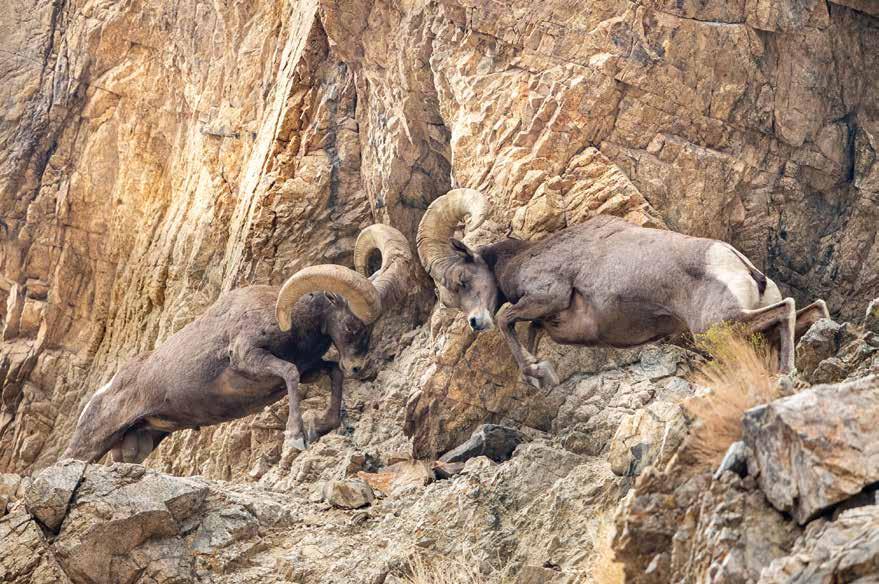







Simply email your nominations to: Julie Tripp @ jtripp@wildsheepfoundation.org by November 1, 2024

The Conklin foundation board is pleased to announce the 2024 winner of the Conklin award. Eduardo Negrete, is the 22nd winner of the “Tough Man” award, named after the late Dr. James Conklin, a Weatherby award winner, who liked to pursue difficult animals throughout the world.
Eduardo, began his big game hunting in 2001 at the age of 33. Since then he has been on over 170 hunts throughout the world taking over 580 animals including 237 Conklin animals. This includes taking 65 sheep and 58 goats.
Eduardo has been married for 28 years to Julia and has a son and a daughter. He lives in Mexico City and has a commercial real estate company.
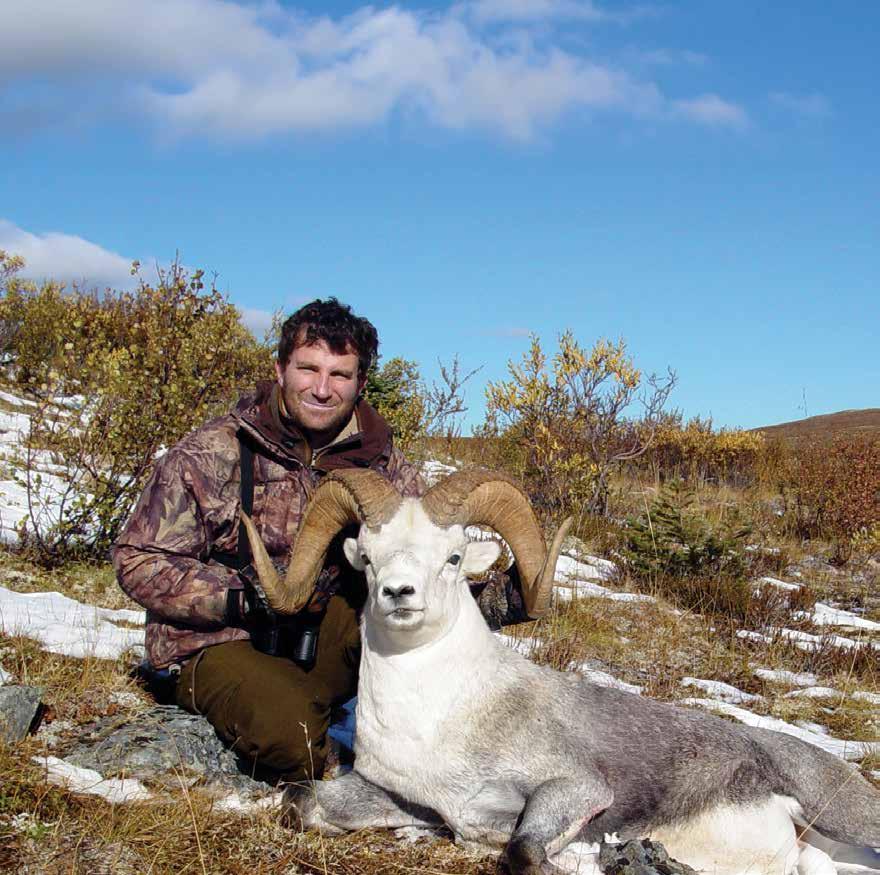
sponsored
by:
The Conklin Foundation would like to gratefully acknowledge and thank the following businesses and individuals for their generous donations.
The support of donors makes it possible for the Conklin Foundation to continue its efforts to educate youth about hunting.
Alan
Renee






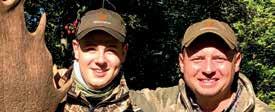










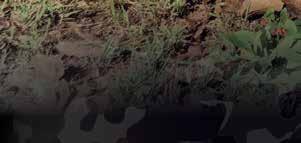




Hunt first class Fallow Buck trophies. Hungary o ers the World largest Fallow Buck population.










































































Brian Winot
SPECIES: Desert Bighorn
OUTFITTER: Aqua Fria Ranch Outfitters
LOCATION: Sonora, Mexico





OUTFITTER: Iber Hunting
LOCATION: Spain

Traveling to non-English speaking countries is always a challenge—then add bringing a firearm to their country and the stress level was palpable. Luckily, I have a very good friend, Rodrigo Sagastegui from Mexico who is now a U.S. citizen. When I called and asked if he wanted to tag along and help with the language barrier, he didn’t hesitate for a second!
On the fourth day we climbed to the top of a mountain. Being up high and right on the Sea of Cortez made for a breathtaking view and one that must be very rare in the sheep hunting world. After walking along the top of the mountain range for a few hours, including some very sketchy and very technical sections, my guide Oscar suddenly spoke English when he turned to me and said, “Spotting scope.”
He promptly lined us up on a beautiful ram, all the way at the bottom of the mountain. Normally a 700-yard shot wouldn’t be something I balked at with my Gunwerks Clymbr 7 SAUM. However, with a 25 MPH sustained wind and gusts to 40, we had to get closer. After two hours we found ourselves within 100 yards of the ram and with one easy shot my FNAWS was achieved! WS
We hunted with Iber Hunting—and it was a first-class trip. Antonio and Mercedes did a great job. Our hunt started on March 12 looking for Gredos ibex in the snowy mountains of Losar de La Vera. I shot my ibex at 330 yards and prayed over the animal thanking God for new found friends and ibex.
Our next trip was for the Beceite ibex near Villarroya da Los Pinares. We had coffee with locals and went hunting, walking the mountains and seeing ibex. After locating a shooter, we stalked to within 160 yards and I squeezed the trigger. My second ibex was down and I prayed over the ibex thanking God.
The hunt for Southeastern ibex number three was located at Carboneras.We started out again at a local coffee shop and then went into the mountains along the Mediterranean Sea. Again we found a shooter, made the shot and number three was down. I prayed again over this ibex thanking God.
Number four would be a Ronda at Alcaucin. Beginning from a (now routine) local coffee shop, we rode halfway up a nearby mountain. Close to top of the mountain was a monster ibex. I had a shot opportunity at 350 yards while the ibex was laying down and was succesful, putting number four in the books. I would recommend Iber Hunting—it was a tripof-a-lifetime! WS
SPECIES: Aoudad – Barbary Sheep OUTFITTER: Point Blank Hunts LOCATION: Tichka Plateau, Morocco
All the normal preliminaries took the first day and a half—rifle clearance, ammunition verification and counting, travel from Marrakech to the hunting area. We started the next day very strong with lots of hiking. During the morning we saw rams and nanny groups, but none we wanted to pursue. For the afternoon hunt, we planned to climb to the high pass, cross over and hunt. My guide Renaud thought we walked about 10 km, I’m convinced it was more! My iPhone showed over 14,400 steps, half of which were uphill.
At 4:00 we spotted six rams, three of which were very good ones. We slid down far enough to be at 360 yards, with a cross-canyon and slightly downhill shot. I shot but didn’t anchor him. I shot again and heard the solid whack, but he was still not down. One more to the neck finished the job and he rolled downhill. It took us 45 minutes to get down to him.
We enjoyed the sites and experiences of Morocco the rest of the week. Thanks to Renaud, Alex, Joe, and a great crew. They were all very friendly and professional. WS




SPECIES: Desert Bighorn
OUTFITTER: Sierra El Alamo
LOCATION: Sonora, Mexico
On the first day of my hunt, I had the opportunity to sight in my gun before we went to scour the mountains for sheep. We went on a short drive and located a few desert bighorns. After a couple hours of glassing Jorge and Javi said there was a very nice ram in the group. We planned our stalk and within a few hours the ram was within my sights and off the mountain. I had told them I did not want a first-day ram, but it is what it is! As with all hunting, you take what you get, and I harvested a very fine ram that day! WS

SPECIES: Stone’s Sheep
OUTFITTER: Backcountry BC
LOCATION: British Columbia
It was smokey on the first two days in the Cassiars with Dustin Roe of Backcountry BC. My guide Doran Carter and I spotted a twister of a ram on the opener who was with three other rams. We were able to get it done, and just like that, my hunt was over. It happened very quickly! This was one of the few times I have punched a tag on the opening day of a season. WS

SPECIES: Gobi Argali
OUTFITTER: Mongol Tours
LOCATION: Gobi Mountains, Mongolia
The great curly-horned argalis of Central Asia have been on my bucket list for decades and I was finally able to gather my forces to pursue this hunt. The terrain was gentle, but the vast open valleys were deceiving. These are long-legged sheep that outrun the wolves. The people, and animals were exotic and aweinspiring. WS
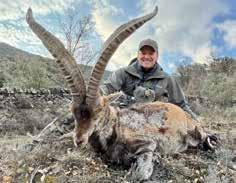
SPECIES: Beceite Ibex
OUTFITTER: Safari Outfitters
LOCATION: La Mata, Spain
Hunting the ancient-terraced hillsides of the Beceite region was a fascinating experience. Wonderful accommodations and beautiful weather greeted us on this hunt. We spotted my billy bedded at the edge of a terraced wheat field just after first light with two nannies feeding near him. Conditions allowed for a quick stalk to within 165 yards with a deep creek bed between us. When he rose to feed, a well-placed shot afforded a clean kill. The region is facing an outbreak of scabies that has taken a toll on the Beceite herd. These old boys were “high representative” examples. I was on an age-class mission rather than size for these two, and the hunts were absolutely perfect. WS
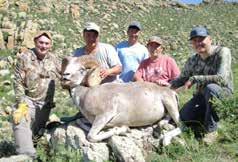
SPECIES: Khangai Argali
OUTFITTER: Mongol Tours, Ogi
Galbadrakh
LOCATION: Hangai Mountains, Mongolia
The great sweeping horns of the Hangai argali are the epitome of Asian Mountain Hunting. I lusted over these rams many years before I realized the dream of hunting them. The Hangai Mountains are high and austere. Few westerners ever see their sunrises. It was a dream come true to run my hands along the massive gnarly horns of these great beasts. Do it while you still have the legs! WS

SPECIES: Gredos Ibex
OUTFITTER: Safari Outfitters
LOCATION: Gredos Mountains Spain
This hunt exceeded expectations... a true mountain hunt, in some of mainland Europe’s most beautiful mountains. We started the hike early in the morning into the mist and fog and immediately saw groups of ibex in the rocks. About four miles in, and nearing the end of the basin, we found the old billies we were after. My hunting partner was first on the gun, and after his successful shot, I had the opportunity at mine across the canyon, but only about 180 yards away. Cannot say enough about Fernando San Pio and his services— absolutely top-notch. WS






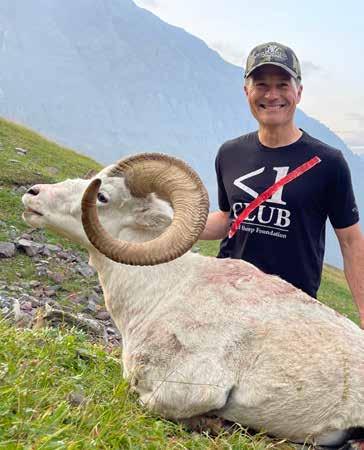
Simon Whetzel Dall’s/Yukon
Literally as I walked off the stage, moments after winning the 50/50 drawing at the Sheep Show® Grand Finale dinner, bundle of cash in hand, I was congratulated by Logan Young of Midnight Sun Outfitters who extended his giant hand and asked, “We going sheep huntin’?” A year later, we went huntin’! WS Way to go Simon, but you are Kicked Out!
The following <1 Club® or <1iClub® members have LOST their membership status by taking their first wild sheep rams! Congratulations!
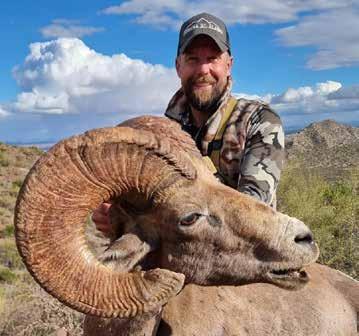
Every year in Reno, Nevada, thousands of sheep enthusiasts, hunters, and conservationists meet at one of the most spectacular events in the conservation world, the Sheep Show®. Amongst the many banquets, seminars, celebrations, and meetings, are auction and raffle opportunities like none-other. Two years ago, I happened to be one of those lucky few to acquire a tag. Fast forward to December 2023, and I found myself flying into Hermosillo, Mexico to hunt desert sheep.
After we spotted a beautiful ram on the second day and put him to bed, we were back on the mountain at sunrise the next day and found him in a different drainage. Closing the distance to 250 yards and setting up for the shot, I was finally given the opportunity to make a clean kill on a beautiful old ram.
I can’t thank the Artee Family, and all of the staff of Alcampo and Sierra El Alamo enough. They are conservationists to the core and their passion is something any WSF member should aspire to. WS Mike, you are Kicked Out with passion!



Jeanette Marian Frederick
Jeanette Marian Frederick, beloved wife, mother, grandmother, and cherished member of her family, passed away unexpectedly on April 21, 2024.
Born on April 29, 1944, Jeanette’s life was defined by her deep love
for her family and her infectious joy for life.
In 1969, she married the love of her life, Pat, creating a family that became her greatest source of happiness. Jeanette was a devoted mother to her three children, Nick, Danny, and Jill, and her love extended to her six grandchildren: Jamie, Brett, Taylor, Myla, Nash and Luke.
Jeanette’s vibrant spirit and love for social gatherings made her the life of every party. She found joy in playing bingo, testing her luck at blackjack, and sharing moments with family and friends while savouring a glass of wine.
Her passing leaves a void in the hearts of all who knew her, but her legacy of love, laughter, and cherished memories will forever remain in the hearts of her family and friends. Jeanette will be dearly missed and fondly remembered as
a beacon of light and love in the lives she touched.
Jeanette is survived by her husband, Pat; sons, Nick (Trish) and Dan (Sherry); daughter, Jill (Trevor); grandchildren, Jamie, Brett, Taylor, Myla, Nash and Luke; sisters, Sonia (Don) and Iris (Doug); brother, John (Carol); sister-in-law, Bonnie; along with numerous nieces and nephews. Predeceased by her parents, Mike and Mary Panko.
A Celebration of Life was held Monday, April 29, 2024, at 4 p.m. at the Edmonton Expo Centre, 301, 7515 - 118 Avenue NW, Edmonton. To view a livestream of the service, please visit www. parkmemorial.com and select “Webcasting” from Jeanette’s Book of Memories.
In Jeanettes honour, donations may be made to the Stollery Children’s Hospital Foundation. WS

RPS Bancard LLC is the preferred merchant services provider for the Wild Sheep Foundation, and proud participating partner of the WSF WE GIVE Program.
RPS provides Retail and E-Commerce businesses with ultracompetitive rates for credit/debit card processing.
RPS will help minimize your company’s merchant services fees while maximizing your support of WSF, as RPS donates a percentage of your processing fees to the WSF Conservation Revolving Fund.
Join RPS in supporting the WSF WE GIVE Program, and support our shared passion for “Putting and Keeping Wild Sheep on the Mountain®”.




Joe Klutsch
It’s a very sad moment for friends, colleagues, and the hunting industry to hear the passing of Joe Klutsch, one of APHA’s founding


cornerstones in making the hunting industry what it is today. Joe was born in a small rural community in Colorado called Wheat Ridge, March 22,1947, to Joseph and Ruth Klutsch. Joe was the oldest of four boys.
After graduating from Wheat Ridge High school in 1965, Joe enrolled in college at Western State College in Gunnison, Colorado and then transferred and finished college at Metropolitan State University of Denver (MSU), graduating with a bachelor degree in both history and economics. While finishing college at MSU, Joe married his high school sweetheart, Carol, in 1968. Carol and Joe were married for over 49 years and raised one son, Joey. After graduating from college, Joe had a number of jobs in Colorado, from
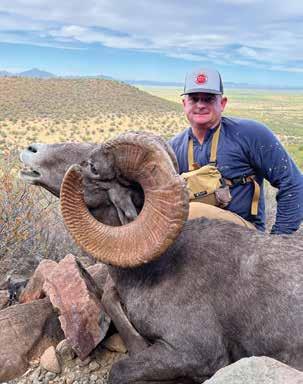


working in a sporting goods store, to construction. As the Colorado population began to grow, Joe was looking for a change in his life and was drawn to Alaska for work for in its rural, untouched wilderness. Joe’s first job in Alaska in 1972 was working as a construction superintendent, building luxurious condos for Alyeska Pipeline staff and executives. While working construction in 1975 in King Salmon, Alaska, doing a remodel at Eddie’s Fireplace Inn, Joe met a guide named Al Burnette. Al needed some camp construction, clean-up and some help packing for some guided hunts. This part-time job intrigued Joe and was really his beginning of a lifelong career in Alaska’s guiding industry. WS




This historical piece was written by Christine Southwick and Stacey Shook, and is written from memory.
Blaine was born to Lila Doris Pitts in the Dawson Creek hospital on February 24, 1943. Lila met Bud (Harvey) Southwick, and after they were married, she and Blaine moved to Bud’s Lower Cash Creek ranch. While there, Blaine’s bothers where born. First came Dennis, then Rocky, Ronny and Glen. Five boys that is a busy household!
Blaine grew up in the saddle. Blaine worked hard doing men’s jobs as a very young boy at six or seven years old. Bud and Lila purchased a “hunting country” (lease of rights to guide nonresident hunters) when Blaine was a teenager. They built a log home at mile 442 on the Alaska Highway which became the headquarters of their guide outfitting business. Blaine grew up hunting and guiding in the summer and fall.
In the off season, Blaine supported himself as a catskinner in the oil patch. He was a dependable and skilled operator, clearing thousands of miles of cutlines and living out of a bunkhouse. He also worked for the owners of Davis Keays Mine, building roads.
In the late 1960s, Blaine and Lila’s brother Ray Pitts and his wife Onie arranged to take over another hunting territory. This area was adjacent to the hunting area owned by Bud and Lila.
In May of 1970 Blaine met Christine Greig at the Toad River (mile 422) Lodge. Chris was working as one of the waitresses at the Lodge. Blaine’s brother Dennis met his future wife, Valerie Calverly at that time as well. Blaine and Chris were married by the Justice of Peace in Fort Nelson on May 21,1971. Blaine and Chris welcomed two children into the world. Patrick Ray was born in Fort Nelson on July 14, 1973, and Stacey Anne was born in Fort St. John on February 1, 1977. Blaine made a name for himself as an outstanding guide and outfitter. His services for hunting
wild sheep and the fabulous game in the area became sought after by wealthy hunters from all over the world. He has said that he took 337 Stone’s sheep as a guide and his personal hunts. Blaine won many awards during his hunting and guiding career.
Blaine purchased a new hunting area at the Liard River, as well as an old cabin and land on the south side of the Liard River close to the bridge. Marilyn Pallister and Blaine spent the next 20 or so years building a home and business in the Liard Valley. Blaine spent his last years in the spring and summer at Liard and spent the winters with Patrick and Diana in Grande Prairie or with Stacey and Dale on Vancouver Island.
Blaine passed away peacefully in Fort Nelson on May 24, 2024. WS

share the news of the passing of Mark Hampton. Mark suffered a heart attack while on a hunting trip in Tanzania on Sunday morning, June 23.
Mark was a Life Member of Safari Club International, where he served with distinction as Record Book Committee Co-Chairman, Asia Subchair, and Record Book Handgun

community were invaluable.
Mark’s dedication, leadership, mentorship, and selflessness will be greatly missed. We ask that you keep Mark’s wife, Karen, in your prayers during this most difficult time. More information regarding services will be forthcoming.
Mark Hampton’s legacy of dedication and passion will live on in the hearts of all who knew him. WS


“Helping Mentor Kids Into The Great Outdoors”
Quarter Century Celebration! Join our team at Bear Trust International in celebrating our 25th Anniversary of Youth Education and Bear Conservation! After an incredible 25 years of bear projects and striving to educate the next generation our core values still remain the same.
Bear Trust has an effective, common-sense conservation policy based on four basic values:
1. Conservation should be based on sound science and make economic sense; the result of conservation action should help ensure the long-term sustainability of bear populations and economies.
2. Conservation should care for both public and private lands.
3. Nations, communities and people have a shared responsibility to conserve bear populations and their habitats for present and future generations.
4. Hunting is part of the world’s natural heritage and should be used as one of many tools for effective wildlife management.
















































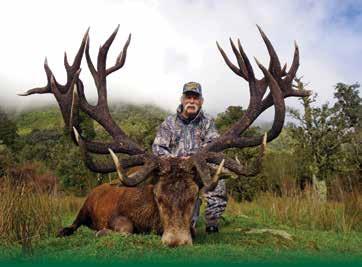






























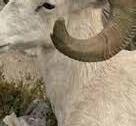








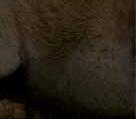




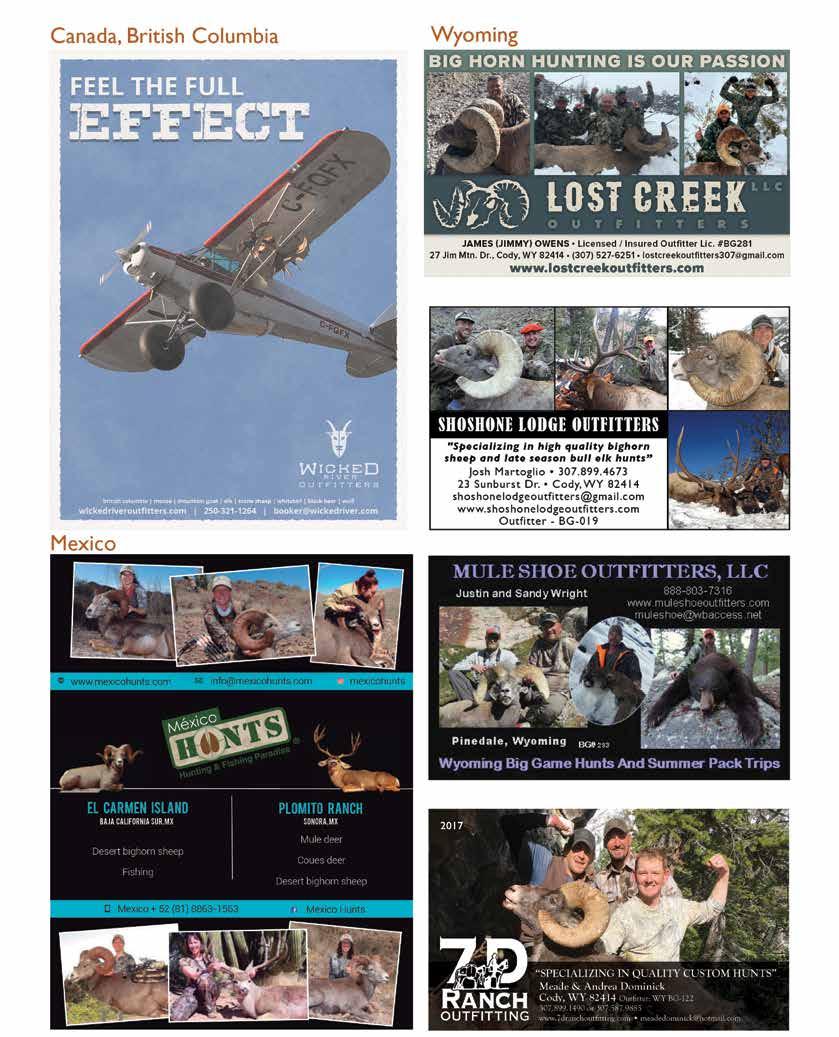























by Ken Nowicki

“I AM THE GREATEST”
“Hi guys, heard any great sheep stories?” I plopped down on my usual stool at Ruby’s counter and ordered some coffee and pie. My old outfitter pals were waiting for me with big smiles, probably because they knew I’d pay.
“You want to skip the weather and get right into it Boy?” Lead-On arched his brows.
“That ain’t polite,” added Packtrain. “Around these parts we ease into every conversation with weather talk.”
“I’m sick of talking about ice and snow. I want to get sheep hunting.”

“He’s like a little kid, ain’t he?” Lead-On said. “He’s got cabin fever,” said Packtrain. They often talk over my head like I’m not even there. “He’s slow for sure.” “Not real swift.” I try to ignore it.
“Guys, I’m just frustrated that I got no draws. Three states and two provinces—nothing. Now I have a box of ticket stubs. I never won nothing at any of the shows.”
“Aw, gee, whiz,” snarked LeadOn. “All you did was donate money.”
“Banquet season done, spring bear hunting’s just begun. Go buy a bear tag Boy. It’s the best excuse



there is.” Lead-On nodded his head like a wise man. “You’ll see.”
“I shot lots of bears. It’s rams I want,” I pleaded. “You guys got to give me some tips on where to look.”
“We’ll help you Boy,” said LeadOn with a sly smile. “I’ll draw you a map. There’s a skid trail up into the high benches where they logged the last old growth Douglas fir in BC by horseback. You can run right up there with a quad. But then youse will need to climb up a couloir to the ridge and look over the top into a hidden basin.”
“We used to call it the Ram Pasture. It’s about 40 acres of sheep heaven.”
“And you’ll see some black bears too along the way. Bring us back some backfat and a greasy hide.”
Now I was excited. This was one of the first times that I ever got a real tip out of either of these old scallywags. I was enthused and took off from Ruby’s with my napkin map. All I needed to do was drive about two hours over the Pass on the Upthrust Range. From there it
was up the Raging River road to Bear Creek at kilometer 50 and take branch “C”. Then the right fork off the top landing where it showed a skid trail to the top.
My preparations were swift. I enlisted a good friend of mine to help. He needed a ram too, and I figured there would be plenty to share if this new area panned out. Besides, he had a quad and a lot of camping gear. There was one question that nagged me some—I could not find the geographic features on my Google searches? I even plugged in Bear Creek and Mutton Top Mountain and some of the other place names that LeadOn penciled into his map. Nothing showed up. But never mind. I figured I could follow his directions. I had my napkin map.
It was a great day in the morning when we left. The sun was shining, and the birds were singing. I could feel the cabin fever cooling as we headed up and into the mountains.

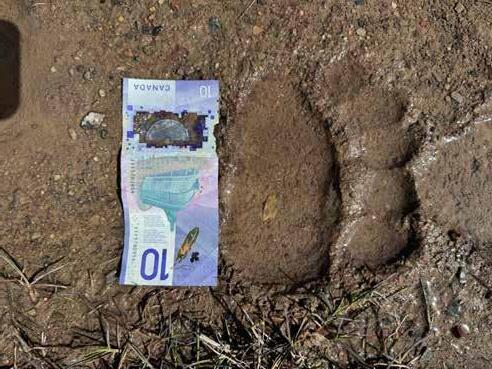
I could feel the potholes on the road. It was not long before I could feel the ice. Then we hit a blizzard going over the Hump Road.
Spring comes late to the high country. And the snow melts slowly. There was still lots up high which explained all the Thule Cartops we saw on the SUV’s in town. We finally hit sheep country. It was still winter, not spring. We found that the only green grass was in the little microclimates formed in the ditches with a southern aspect. There were ewes down beside the road fighting with wild horses for gobs of salty mud. It looked to me that the salt in the mud was from the crusty pockets of horse urine.
We hit deep snow and found a rig abandoned in the middle of the road. “Oh great!” I said.
There were grizzly tracks. You can’t hunt them these days. There was other sign too. Big piles of black turds, and they were fresh.
We got stuck and got lost. We hit the end of the road. We cussed Packtrain. We cussed Lead-On.
We left and drove a hundred miles south where we found a green valley. There were sheep to the left and right. Sheep in the ditches and sheep on the hills. Most were ewes. The ewes were shedding, and they looked awful. But they were sheep. We tried to quad into the mountains and failed.
We finally found some rams. Right beside the Trans-Canada Highway. That made it all worthwhile. Didn’t it?
Back in town, Packtrain asked me how the scouting trip went. “A great success,” I lied. “We found a ram pasture.”
“I’m thinking you were lost,” he said when he saw the pictures. “Where’s that map? “Say, did any of those cayuse have my brand?”
“I didn’t think to look,” I said, a little embarrassed. I had to use that
napkin for something urgent on the way home. But I am planning to go back and look for his Ram Pasture. WS
Nowicki advises that spring scouting is a great way to find rams. The winter coat on bighorns have bleached nearly white and the spring aggregations are easy to find and glass. The sheep exhibit very little fear of man and he was able to drive right up to them on the highway. He reports that spring is a great time to study the rams and look for unique features like chips out of the horns. Later in the fall it would be fun to find and harvest the same ram up in the high ram pastures. To date, Nowicki has never been so lucky. Still, he is planning to present a slide show of his observations at the next Sheep Show® in Reno.
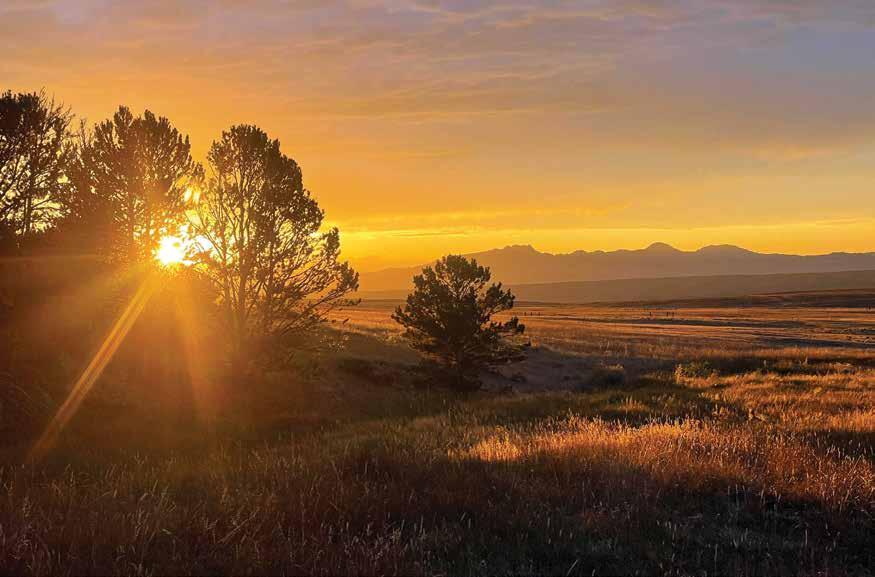
WSF’s Legacy Society recognizes individuals, families and foundations making testamentary bequests or contributions of major gifts, gift annuities or other charitable-giving instruments. Since inception of the Ensuring the Future of Wild Sheep (ETFOWS) campaign, 47 Legacy Society members have been recognized through WSF’s Legacy Society for contributions or pledges of future gifts.
Anonymous
Anonymous
Lee & Penny Anderson
Jack, Jr. & Cindy Atcheson
Derek W.O. Berry
Mike Borel
Cabela’s Outdoor Fund
David W. Campbell
Rick & Heather Carosone
Dr. Robert W. & Cynthia Cassell
David & Sona Combs
Monty & Becky Davis
Howard & Mary Deters
Doug & Patty Dreeszen
Buddy DuVall
Tom Grimes
Eric & Sue Hansen
Robert & Arlene Hanson
Dr. Paul F. & Kathy J. Havey
Zach & Amber Higgins
John R. & Mary Ann Justus
Blair A. & Victoria M. Kenewell
Robert M. Martin, Jr.
Robert and Lisa Mays
Bequests made through the New Beginnings Campaign* or other bequests may be recognized through the Legacy Society by contacting WSF. For more information on the Legacy Society or Estate Planning resources available through WSF, please contact Paige Culver at 406.404.8758 or PCulver@WildSheepFoundation.org.
Roger McCosker
Kyle & Joanne Meintzer
Chuck Middleton
David Mode
John & Leslie Pearson
Brad R. Plaga
Robert L. & J.P. Puette
Kevin & Janine Rinke
Lanny Rominger
Louis & Pauline Rupp
SCI Foundation
- Hunter Legacy Fund (HLF-100)
Roger Segebrecht
Kasie and Jason Sheridan
Tim & Roxane Shinabarger
Steve & Sue Skold
Curt & Marcia Thompson
Gray & Renée Thornton
Jim Travis
Tim & Ruth Van Der Weide
The Estate of Robert B. Johnson
Zachary Walton
Wayne W. Webber
The William H. Donner Foundation, Inc





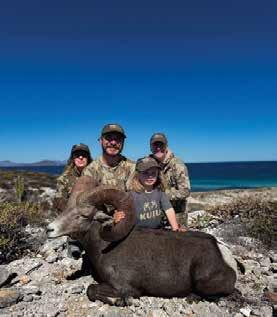







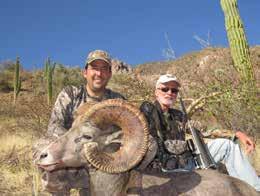

Adam Foss
Young, passionate, accomplished archeryonly sheep hunter. Youngest hunter to earn the archery FNAWS. Gets after it no matter the weather or the terrain. Can’t wait for the next hunt. Uses Hilleberg tents, including the Rogen.

“
i love my rogen for long, multi day trips. I do a lot of my mountain hunting with a partner, so the Rogen’s two door/two vestibule design is ideal, as is its amazingly light weight and impressive strength. Since it’s a 3-season tent, I wouldn’t take it if I were going up super high or when there’s likely to be snow, but for early season sheep hunts, it’s outstanding!

”for over 50 years, Hilleberg has been making the highest quality tents and shelters available. Developed in Sweden, manufactured in Europe, and used worldwide, Hilleberg tents and shelters offer the ideal balance of high strength, low weight, ease of use, and comfort.


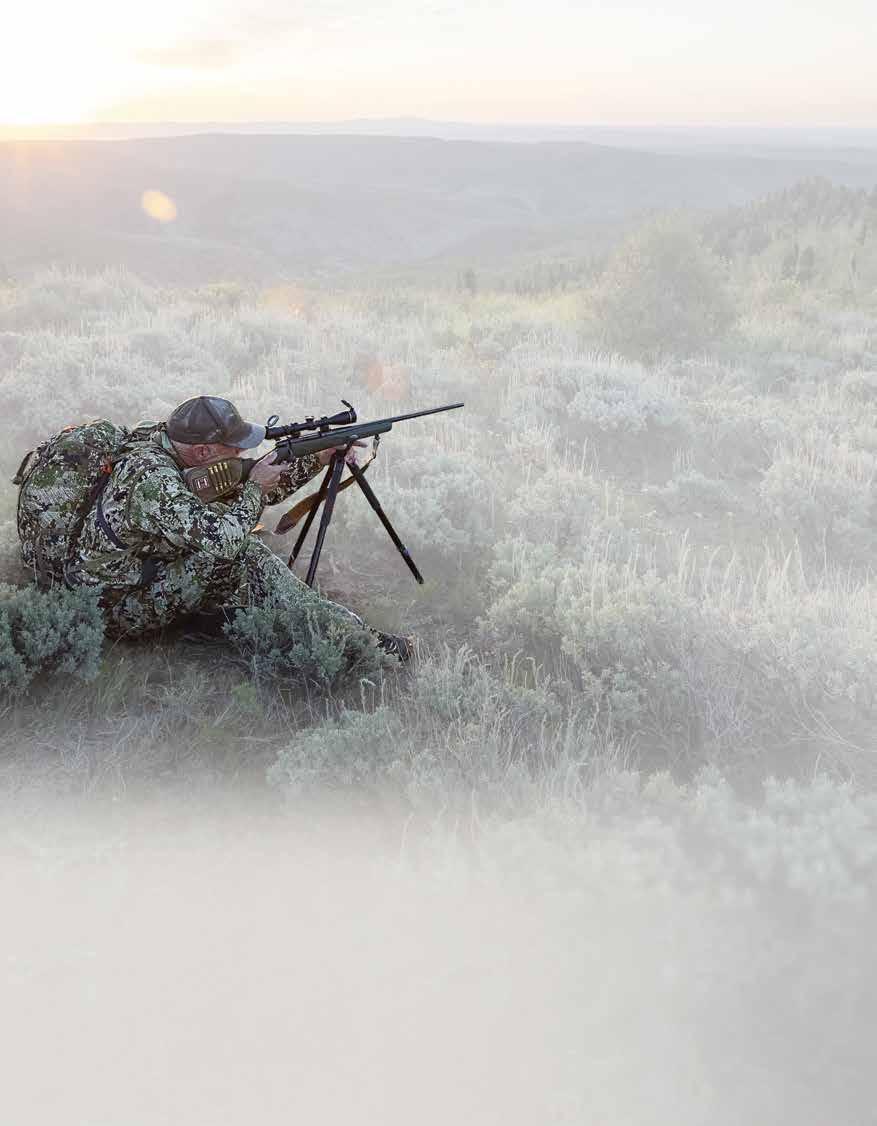

When you set out to exceed the limits of what is expected of hunting ammunition, you don’t do it by guessing what should happen. You test, evaluate and refine until you arrive at Hornady ® Precision Hunter ® ammunition, loaded with our ballistically advanced ELD-X® bullet with Heat Shield® tip. Engineered specifically to deliver match accuracy and lethality at all practical ranges, Hornady ® Precision Hunter ® ammunition is the best ALL-RANGE hunting ammunition.
